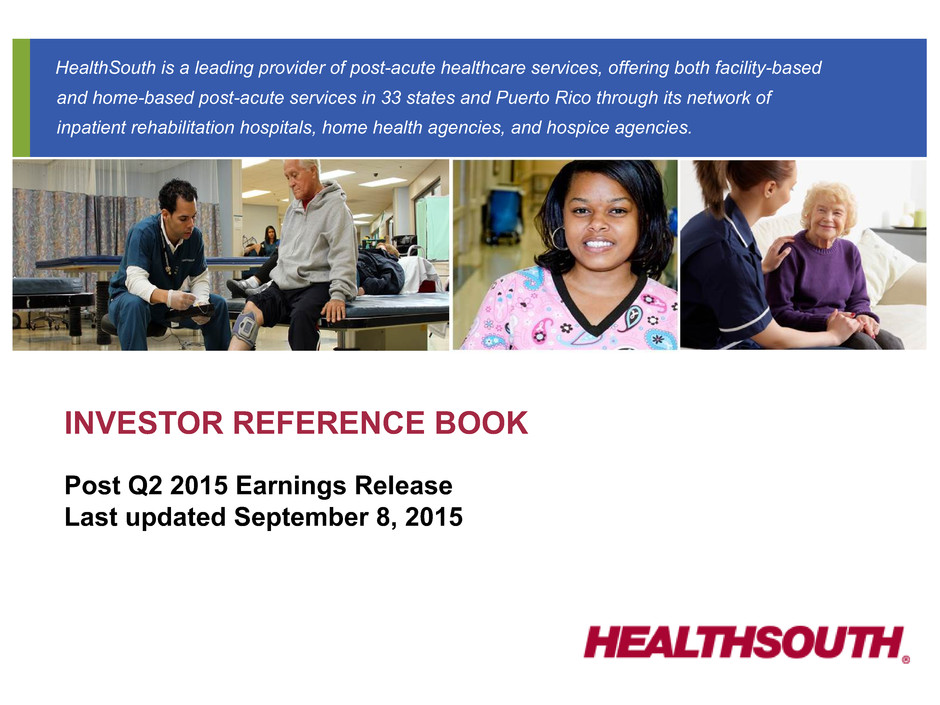
INVESTOR REFERENCE BOOK Post Q2 2015 Earnings Release Last updated September 8, 2015 HealthSouth is a leading provider of post-acute healthcare services, offering both facility-based and home-based post-acute services in 33 states and Puerto Rico through its network of inpatient rehabilitation hospitals, home health agencies, and hospice agencies.
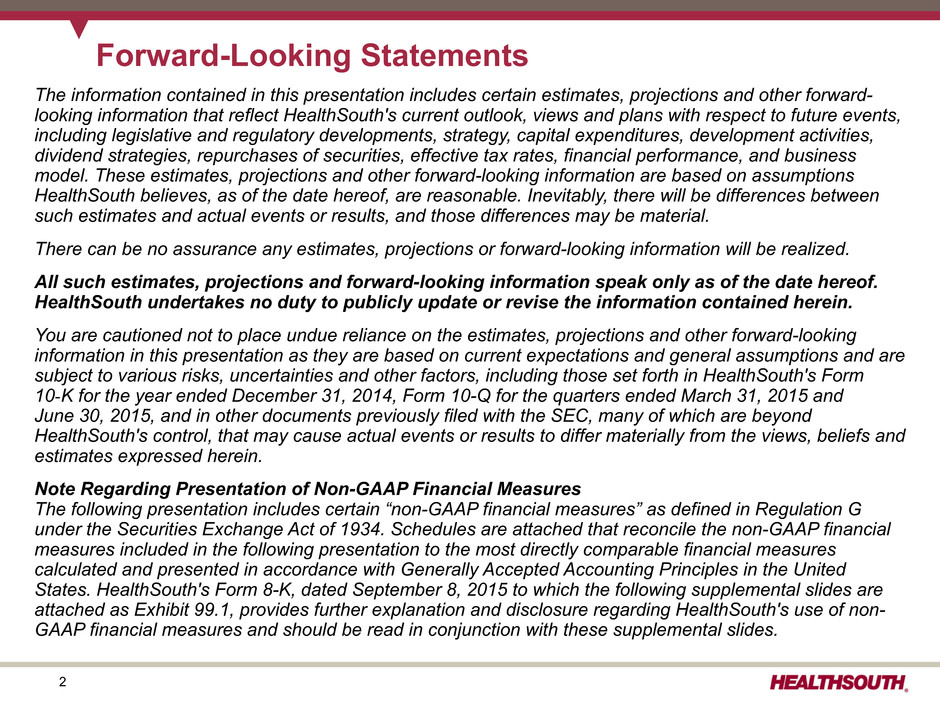
2 The information contained in this presentation includes certain estimates, projections and other forward- looking information that reflect HealthSouth's current outlook, views and plans with respect to future events, including legislative and regulatory developments, strategy, capital expenditures, development activities, dividend strategies, repurchases of securities, effective tax rates, financial performance, and business model. These estimates, projections and other forward-looking information are based on assumptions HealthSouth believes, as of the date hereof, are reasonable. Inevitably, there will be differences between such estimates and actual events or results, and those differences may be material. There can be no assurance any estimates, projections or forward-looking information will be realized. All such estimates, projections and forward-looking information speak only as of the date hereof. HealthSouth undertakes no duty to publicly update or revise the information contained herein. You are cautioned not to place undue reliance on the estimates, projections and other forward-looking information in this presentation as they are based on current expectations and general assumptions and are subject to various risks, uncertainties and other factors, including those set forth in HealthSouth's Form 10‑K for the year ended December 31, 2014, Form 10-Q for the quarters ended March 31, 2015 and June 30, 2015, and in other documents previously filed with the SEC, many of which are beyond HealthSouth's control, that may cause actual events or results to differ materially from the views, beliefs and estimates expressed herein. Note Regarding Presentation of Non-GAAP Financial Measures The following presentation includes certain “non-GAAP financial measures” as defined in Regulation G under the Securities Exchange Act of 1934. Schedules are attached that reconcile the non-GAAP financial measures included in the following presentation to the most directly comparable financial measures calculated and presented in accordance with Generally Accepted Accounting Principles in the United States. HealthSouth's Form 8-K, dated September 8, 2015 to which the following supplemental slides are attached as Exhibit 99.1, provides further explanation and disclosure regarding HealthSouth's use of non- GAAP financial measures and should be read in conjunction with these supplemental slides. Forward-Looking Statements
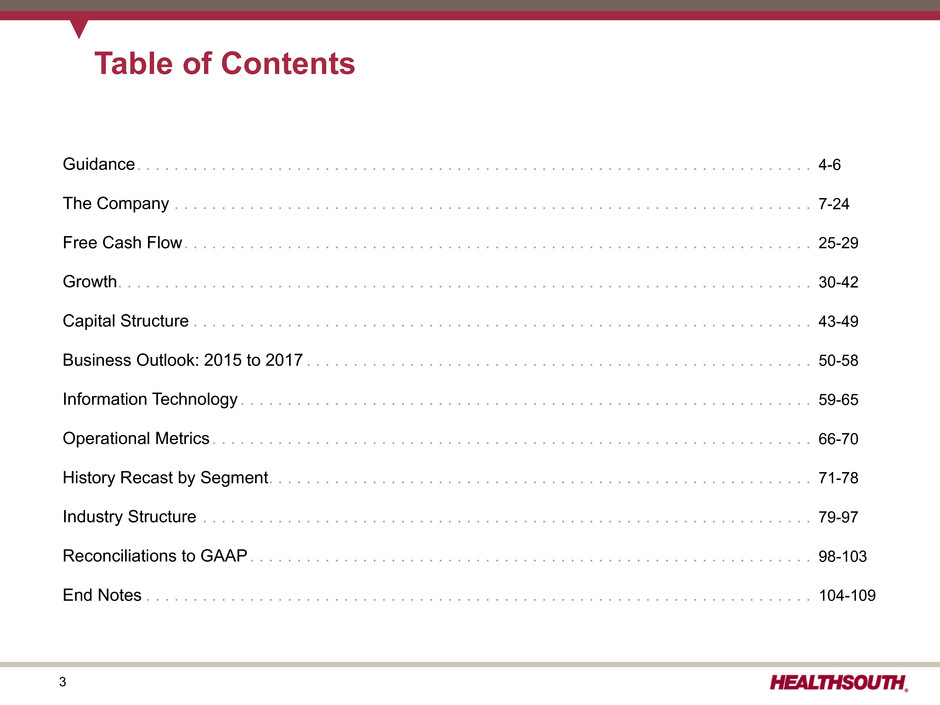
3 Table of Contents Guidance. . . . . . . . . . . . . . . . . . . . . . . . . . . . . . . . . . . . . . . . . . . . . . . . . . . . . . . . . . . . . . . . . . . . . . . . 4-6 The Company . . . . . . . . . . . . . . . . . . . . . . . . . . . . . . . . . . . . . . . . . . . . . . . . . . . . . . . . . . . . . . . . . . . . 7-24 Free Cash Flow. . . . . . . . . . . . . . . . . . . . . . . . . . . . . . . . . . . . . . . . . . . . . . . . . . . . . . . . . . . . . . . . . . . 25-29 Growth. . . . . . . . . . . . . . . . . . . . . . . . . . . . . . . . . . . . . . . . . . . . . . . . . . . . . . . . . . . . . . . . . . . . . . . . . . 30-42 Capital Structure . . . . . . . . . . . . . . . . . . . . . . . . . . . . . . . . . . . . . . . . . . . . . . . . . . . . . . . . . . . . . . . . . . 43-49 Business Outlook: 2015 to 2017 . . . . . . . . . . . . . . . . . . . . . . . . . . . . . . . . . . . . . . . . . . . . . . . . . . . . . . 50-58 Information Technology . . . . . . . . . . . . . . . . . . . . . . . . . . . . . . . . . . . . . . . . . . . . . . . . . . . . . . . . . . . . . 59-65 Operational Metrics . . . . . . . . . . . . . . . . . . . . . . . . . . . . . . . . . . . . . . . . . . . . . . . . . . . . . . . . . . . . . . . . 66-70 History Recast by Segment. . . . . . . . . . . . . . . . . . . . . . . . . . . . . . . . . . . . . . . . . . . . . . . . . . . . . . . . . . 71-78 Industry Structure . . . . . . . . . . . . . . . . . . . . . . . . . . . . . . . . . . . . . . . . . . . . . . . . . . . . . . . . . . . . . . . . . 79-97 Reconciliations to GAAP. . . . . . . . . . . . . . . . . . . . . . . . . . . . . . . . . . . . . . . . . . . . . . . . . . . . . . . . . . . . 98-103 End Notes . . . . . . . . . . . . . . . . . . . . . . . . . . . . . . . . . . . . . . . . . . . . . . . . . . . . . . . . . . . . . . . . . . . . . . . 104-109

4 Guidance (as of September 8, 2015)
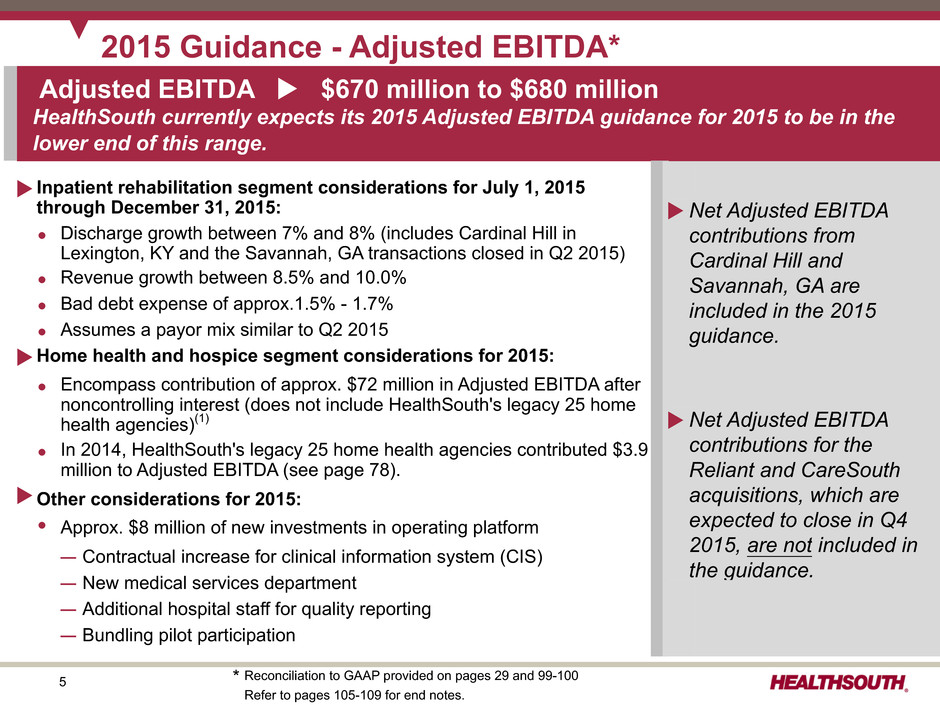
5 2015 Guidance - Adjusted EBITDA* u Inpatient rehabilitation segment considerations for July 1, 2015 through December 31, 2015: Ÿ Discharge growth between 7% and 8% (includes Cardinal Hill in Lexington, KY and the Savannah, GA transactions closed in Q2 2015) Ÿ Revenue growth between 8.5% and 10.0% Ÿ Bad debt expense of approx.1.5% - 1.7% Ÿ Assumes a payor mix similar to Q2 2015 uHome health and hospice segment considerations for 2015: Ÿ Encompass contribution of approx. $72 million in Adjusted EBITDA after noncontrolling interest (does not include HealthSouth's legacy 25 home health agencies)(1) Ÿ In 2014, HealthSouth's legacy 25 home health agencies contributed $3.9 million to Adjusted EBITDA (see page 78). uOther considerations for 2015: Ÿ Approx. $8 million of new investments in operating platform — Contractual increase for clinical information system (CIS) — New medical services department — Additional hospital staff for quality reporting — Bundling pilot participation Adjusted EBITDA u $670 million to $680 million HealthSouth currently expects its 2015 Adjusted EBITDA guidance for 2015 to be in the lower end of this range. * Reconciliation to GAAP provided on pages 29 and 99-100 Refer to pages 105-109 for end notes. u Net Adjusted EBITDA contributions from Cardinal Hill and Savannah, GA are included in the 2015 guidance. u Net Adjusted EBITDA contributions for the Reliant and CareSouth acquisitions, which are expected to close in Q4 2015, are not included in the guidance.
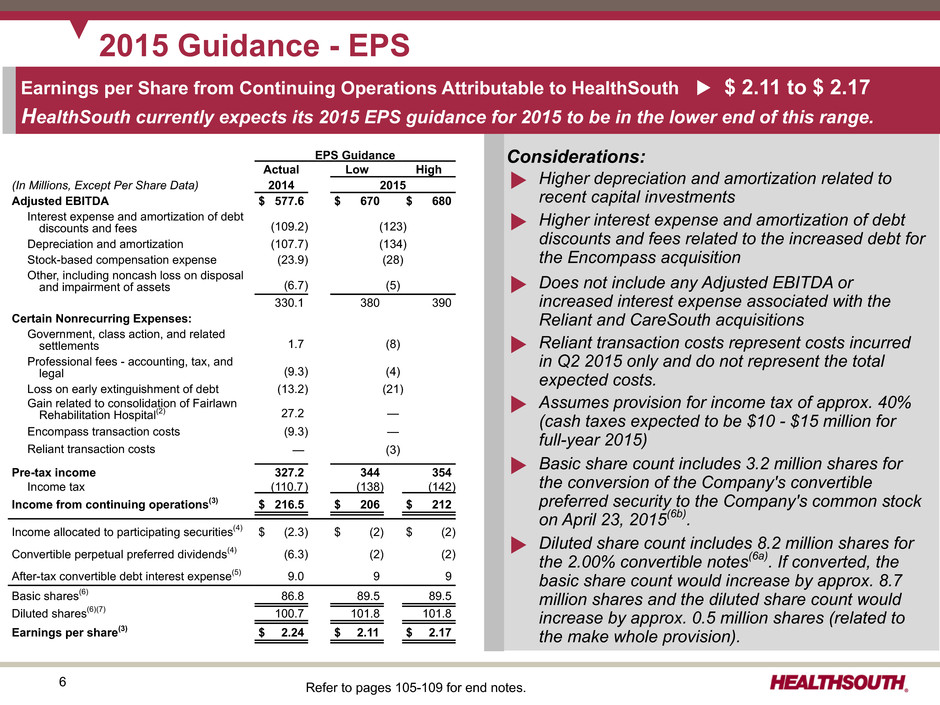
6 2015 Guidance - EPS EPS Guidance Actual Low High (In Millions, Except Per Share Data) 2014 2015 Adjusted EBITDA $ 577.6 $ 670 $ 680 Interest expense and amortization of debt discounts and fees (109.2) (123) Depreciation and amortization (107.7) (134) Stock-based compensation expense (23.9) (28) Other, including noncash loss on disposal and impairment of assets (6.7) (5) 330.1 380 390 Certain Nonrecurring Expenses: Government, class action, and related settlements 1.7 (8) Professional fees - accounting, tax, and legal (9.3) (4) Loss on early extinguishment of debt (13.2) (21) Gain related to consolidation of Fairlawn Rehabilitation Hospital(2) 27.2 — Encompass transaction costs (9.3) — Reliant transaction costs — (3) Pre-tax income 327.2 344 354 Income tax (110.7) (138) (142) Income from continuing operations(3) $ 216.5 $ 206 $ 212 Income allocated to participating securities(4) $ (2.3) $ (2) $ (2) Convertible perpetual preferred dividends(4) (6.3) (2) (2) After-tax convertible debt interest expense(5) 9.0 9 9 Basic shares(6) 86.8 89.5 89.5 Diluted shares(6)(7) 100.7 101.8 101.8 Earnings per share(3) $ 2.24 $ 2.11 $ 2.17 Refer to pages 105-109 for end notes. Considerations: u Higher depreciation and amortization related to recent capital investments u Higher interest expense and amortization of debt discounts and fees related to the increased debt for the Encompass acquisition u Does not include any Adjusted EBITDA or increased interest expense associated with the Reliant and CareSouth acquisitions u Reliant transaction costs represent costs incurred in Q2 2015 only and do not represent the total expected costs. u Assumes provision for income tax of approx. 40% (cash taxes expected to be $10 - $15 million for full-year 2015) u Basic share count includes 3.2 million shares for the conversion of the Company's convertible preferred security to the Company's common stock on April 23, 2015(6b). u Diluted share count includes 8.2 million shares for the 2.00% convertible notes(6a). If converted, the basic share count would increase by approx. 8.7 million shares and the diluted share count would increase by approx. 0.5 million shares (related to the make whole provision). Earnings per Share from Continuing Operations Attributable to HealthSouth u $ 2.11 to $ 2.17 HealthSouth currently expects its 2015 EPS guidance for 2015 to be in the lower end of this range.
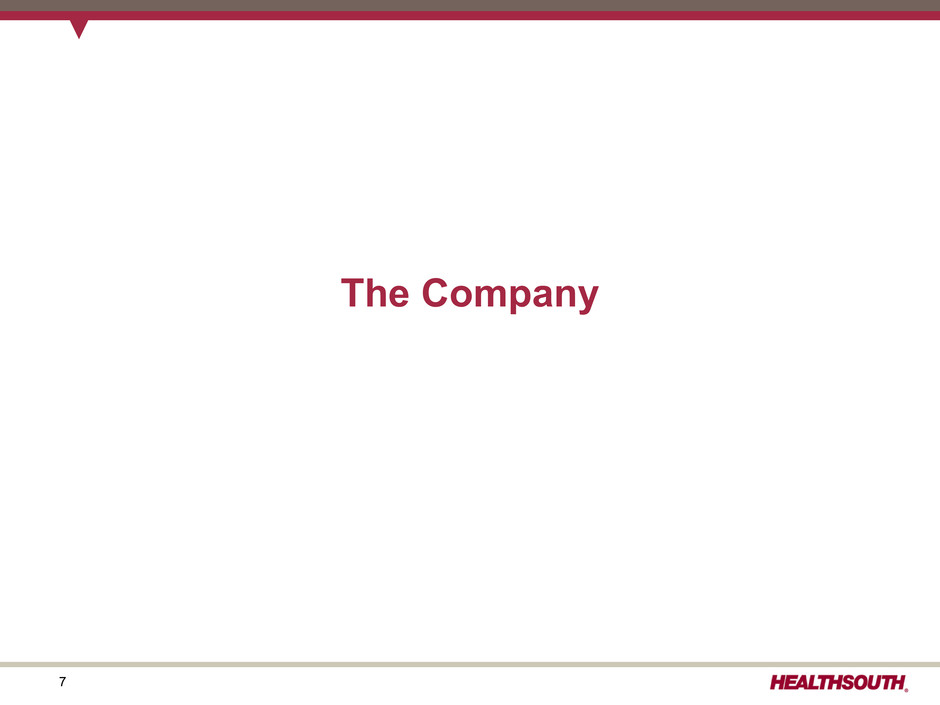
7 The Company
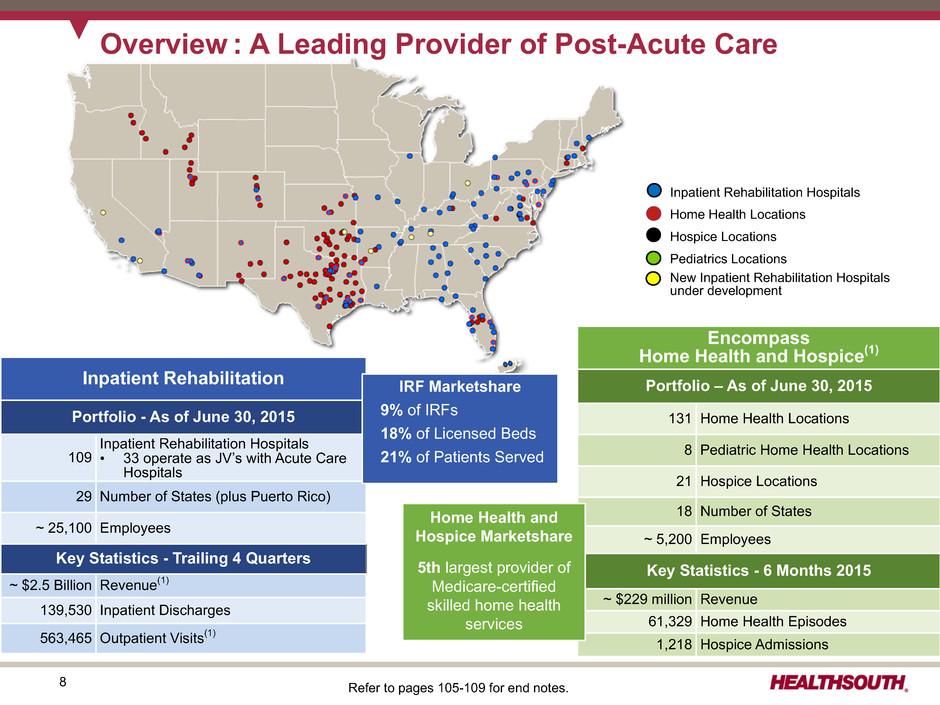
8 Refer to pages 105-109 for end notes. Inpatient Rehabilitation Portfolio - As of June 30, 2015 109 Inpatient Rehabilitation Hospitals • 33 operate as JV’s with Acute Care Hospitals 29 Number of States (plus Puerto Rico) ~ 25,100 Employees Key Statistics - Trailing 4 Quarters ~ $2.5 Billion Revenue(1) 139,530 Inpatient Discharges 563,465 Outpatient Visits(1) Overview : A Leading Provider of Post-Acute Care Encompass Home Health and Hospice(1) Portfolio – As of June 30, 2015 131 Home Health Locations 8 Pediatric Home Health Locations 21 Hospice Locations 18 Number of States ~ 5,200 Employees Key Statistics - 6 Months 2015 ~ $229 million Revenue 61,329 Home Health Episodes 1,218 Hospice Admissions Inpatient Rehabilitation Hospitals Home Health Locations Hospice Locations Pediatrics Locations New Inpatient Rehabilitation Hospitals under development IRF Marketshare 9% of IRFs 18% of Licensed Beds 21% of Patients Served Home Health and Hospice Marketshare 5th largest provider of Medicare-certified skilled home health services

9 Acquisition of: • Acquisition adds 11 inpatient rehabilitation hospitals in Texas, Massachusetts, and Ohio with a total of 902 beds. • Reliant generated approx. $249 million of revenue in 2014. • All 11 hospitals are leased, and 7 of those leases are treated as capital leases for accounting purposes. HealthSouth will assume the lease obligations of all 11 acquired hospitals. • 8 IRFs in Texas • 2 IRFs in Massachusetts • 1 IRF in Ohio Ÿ $730 million purchase price —Expect to realize approx. $125 million to $150 million (NPV) tax benefit —The cash purchase price will be reduced based on any remaining limited partner equity interests at closing (currently expect one Reliant hospital operating entity with remaining minority limited partner interests at closing). —Capital lease obligation to be recognized on HealthSouth's balance sheet upon closing preliminarily estimated at approx. $210 million. Ÿ Accretive upon closing —Reliant generated Adjusted EBITDA of approx. $82 million in 2014. —The acquisition is expected to be immediately accretive (excluding transaction costs) to earnings per share. Ÿ Transaction expected to be funded with cash on hand and senior debt Ÿ Expected to close in Q4 2015 —Received Hart-Scott-Rodino approval —Subject to other regulatory approvals
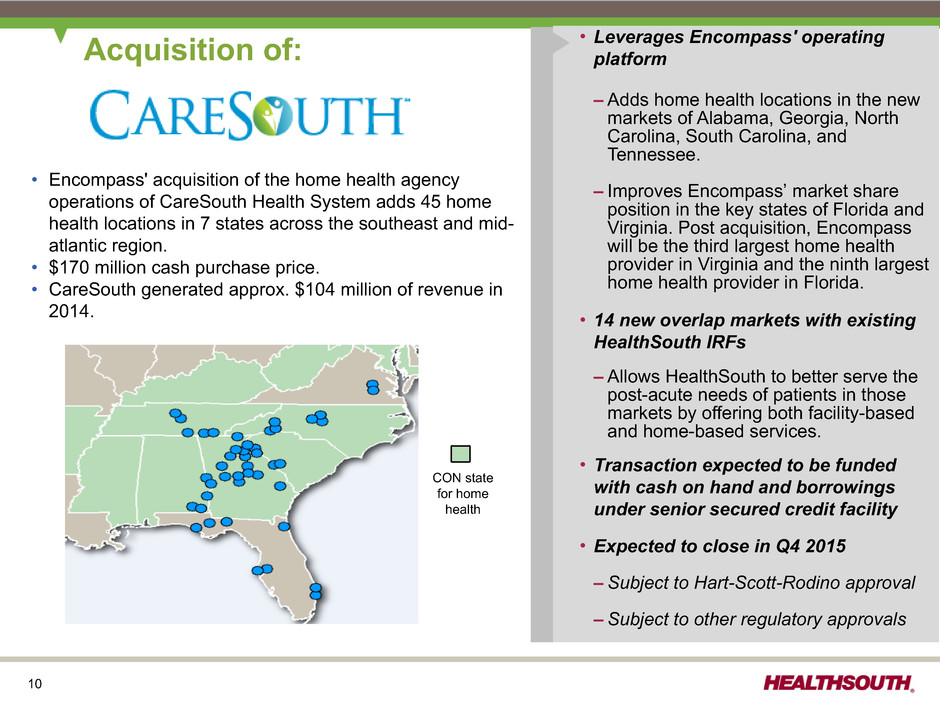
10 Acquisition of: • Encompass' acquisition of the home health agency operations of CareSouth Health System adds 45 home health locations in 7 states across the southeast and mid- atlantic region. • $170 million cash purchase price. • CareSouth generated approx. $104 million of revenue in 2014. Ÿ Leverages Encompass' operating platform —Adds home health locations in the new markets of Alabama, Georgia, North Carolina, South Carolina, and Tennessee. —Improves Encompass’ market share position in the key states of Florida and Virginia. Post acquisition, Encompass will be the third largest home health provider in Virginia and the ninth largest home health provider in Florida. Ÿ 14 new overlap markets with existing HealthSouth IRFs —Allows HealthSouth to better serve the post-acute needs of patients in those markets by offering both facility-based and home-based services. Ÿ Transaction expected to be funded with cash on hand and borrowings under senior secured credit facility Ÿ Expected to close in Q4 2015 —Subject to Hart-Scott-Rodino approval —Subject to other regulatory approvals CON state for home health
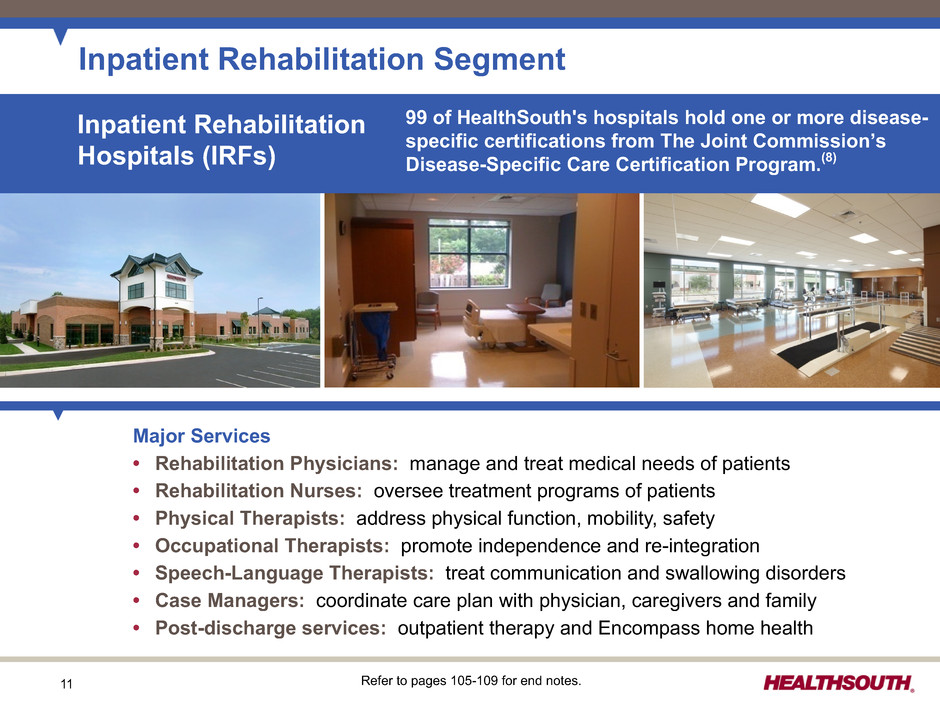
11 Inpatient Rehabilitation Segment Major Services • Rehabilitation Physicians: manage and treat medical needs of patients • Rehabilitation Nurses: oversee treatment programs of patients • Physical Therapists: address physical function, mobility, safety • Occupational Therapists: promote independence and re-integration • Speech-Language Therapists: treat communication and swallowing disorders • Case Managers: coordinate care plan with physician, caregivers and family • Post-discharge services: outpatient therapy and Encompass home health Inpatient Rehabilitation Hospitals (IRFs) Refer to pages 105-109 for end notes. 99 of HealthSouth's hospitals hold one or more disease- specific certifications from The Joint Commission’s Disease-Specific Care Certification Program.(8)
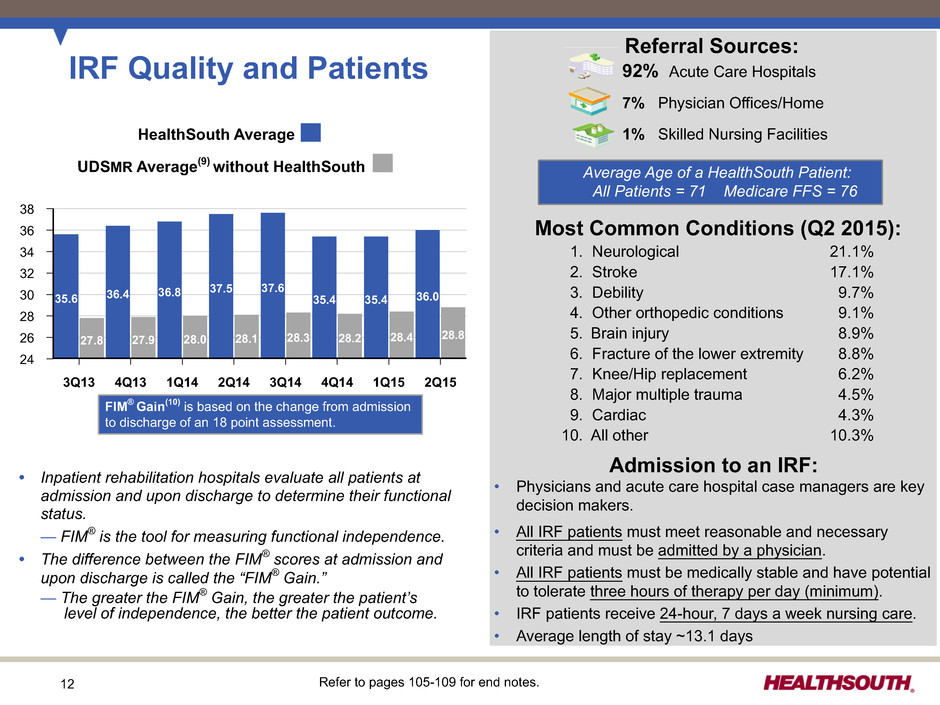
12 IRF Quality and Patients • Inpatient rehabilitation hospitals evaluate all patients at admission and upon discharge to determine their functional status. — FIM® is the tool for measuring functional independence. • The difference between the FIM® scores at admission and upon discharge is called the “FIM® Gain.” — The greater the FIM® Gain, the greater the patient’s level of independence, the better the patient outcome. HealthSouth Average UDSMR Average(9) without HealthSouth 38 36 34 32 30 28 26 24 3Q13 4Q13 1Q14 2Q14 3Q14 4Q14 1Q15 2Q15 35.6 36.4 36.8 37.5 37.6 35.4 35.4 36.0 27.8 27.9 28.0 28.1 28.3 28.2 28.4 28.8 Refer to pages 105-109 for end notes. Referral Sources: 92% Acute Care Hospitals 7% Physician Offices/Home 1% Skilled Nursing Facilities 1. Neurological 21.1% 2. Stroke 17.1% 3. Debility 9.7% 4. Other orthopedic conditions 9.1% 5. Brain injury 8.9% 6. Fracture of the lower extremity 8.8% 7. Knee/Hip replacement 6.2% 8. Major multiple trauma 4.5% 9. Cardiac 4.3% 10. All other 10.3% Most Common Conditions (Q2 2015): • Physicians and acute care hospital case managers are key decision makers. • All IRF patients must meet reasonable and necessary criteria and must be admitted by a physician. • All IRF patients must be medically stable and have potential to tolerate three hours of therapy per day (minimum). • IRF patients receive 24-hour, 7 days a week nursing care. • Average length of stay ~13.1 days Admission to an IRF: Average Age of a HealthSouth Patient: All Patients = 71 Medicare FFS = 76 FIM® Gain(10) is based on the change from admission to discharge of an 18 point assessment.
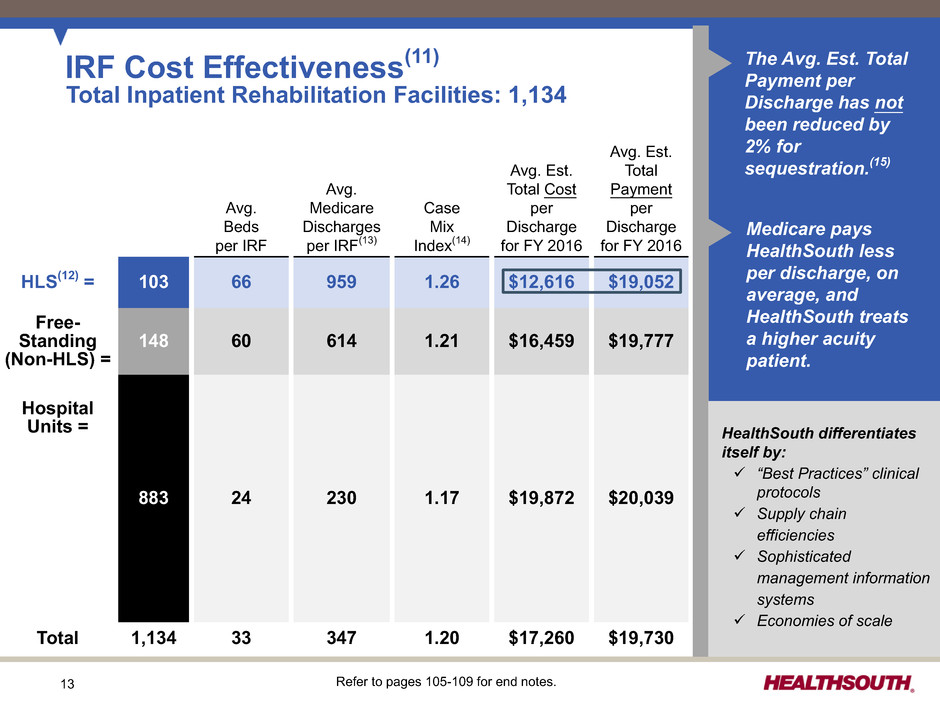
13 Total Inpatient Rehabilitation Facilities: 1,134 IRF Cost Effectiveness(11) The Avg. Est. TotalPayment per Discharge has not been reduced by 2% for sequestration.(15) Medicare pays HealthSouth less per discharge, on average, and HealthSouth treats a higher acuity patient. Avg. Beds per IRF Avg. Medicare Discharges per IRF(13) Case Mix Index(14) Avg. Est. Total Cost per Discharge for FY 2016 Avg. Est. Total Payment per Discharge for FY 2016 HLS(12) = 103 66 959 1.26 $12,616 $19,052 Free- Standing (Non-HLS) = 148 60 614 1.21 $16,459 $19,777 883 24 230 1.17 $19,872 $20,039 Hospital Units = Total 1,134 33 347 1.20 $17,260 $19,730 Refer to pages 105-109 for end notes. HealthSouth differentiates itself by: ü “Best Practices” clinical protocols ü Supply chain efficiencies ü Sophisticated management information systems ü Economies of scale
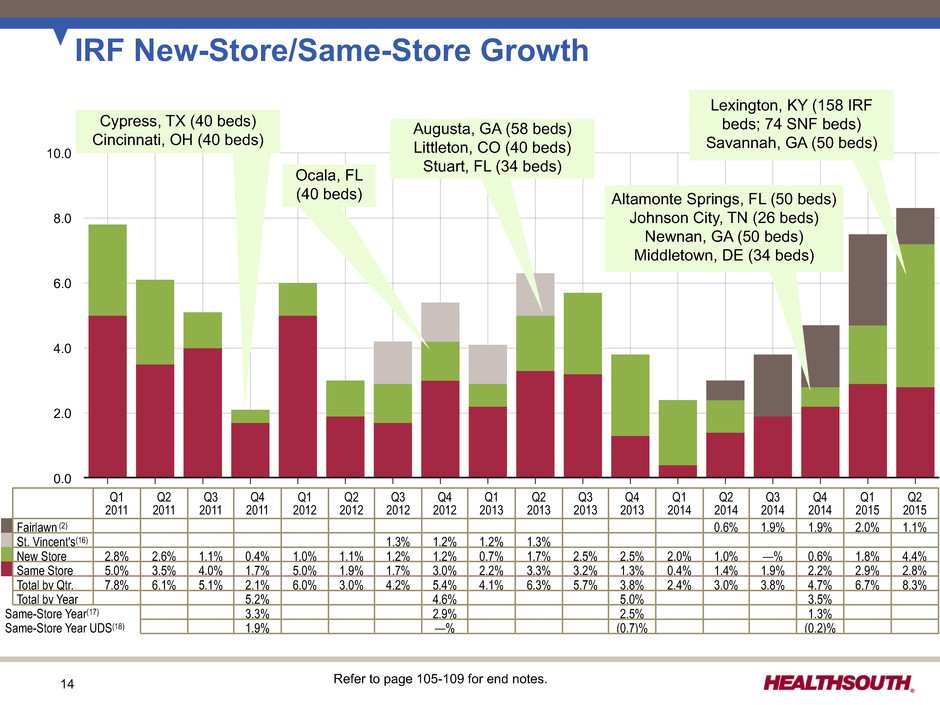
14 10.0 8.0 6.0 4.0 2.0 0.0 Q1 2011 Q2 2011 Q3 2011 Q4 2011 Q1 2012 Q2 2012 Q3 2012 Q4 2012 Q1 2013 Q2 2013 Q3 2013 Q4 2013 Q1 2014 Q2 2014 Q3 2014 Q4 2014 Q1 2015 Q2 2015 IRF New-Store/Same-Store Growth Q1 2011 Q2 2011 Q3 2011 Q4 2011 Q1 2012 Q2 2012 Q3 2012 Q4 2012 Q1 2013 Q2 2013 Q3 2013 Q4 2013 Q1 2014 Q2 2014 Q3 2014 Q4 2014 Q1 2015 Q2 2015 Fairlawn (2) 0.6% 1.9% 1.9% 2.0% 1.1% St. Vincent's(16) 1.3% 1.2% 1.2% 1.3% New Store 2.8% 2.6% 1.1% 0.4% 1.0% 1.1% 1.2% 1.2% 0.7% 1.7% 2.5% 2.5% 2.0% 1.0% —% 0.6% 1.8% 4.4% Same Store 5.0% 3.5% 4.0% 1.7% 5.0% 1.9% 1.7% 3.0% 2.2% 3.3% 3.2% 1.3% 0.4% 1.4% 1.9% 2.2% 2.9% 2.8% Total by Qtr. 7.8% 6.1% 5.1% 2.1% 6.0% 3.0% 4.2% 5.4% 4.1% 6.3% 5.7% 3.8% 2.4% 3.0% 3.8% 4.7% 6.7% 8.3% Total by Year 5.2% 4.6% 5.0% 3.5% Same-Store Year(17) 3.3% 2.9% 2.5% 1.3% Same-Store Year UDS(18) 1.9% —% (0.7)% (0.2)% Altamonte Springs, FL (50 beds) Johnson City, TN (26 beds) Newnan, GA (50 beds) Middletown, DE (34 beds) Cypress, TX (40 beds) Cincinnati, OH (40 beds) Ocala, FL (40 beds) Augusta, GA (58 beds) Littleton, CO (40 beds) Stuart, FL (34 beds) Lexington, KY (158 IRF beds; 74 SNF beds) Savannah, GA (50 beds) Refer to page 105-109 for end notes.
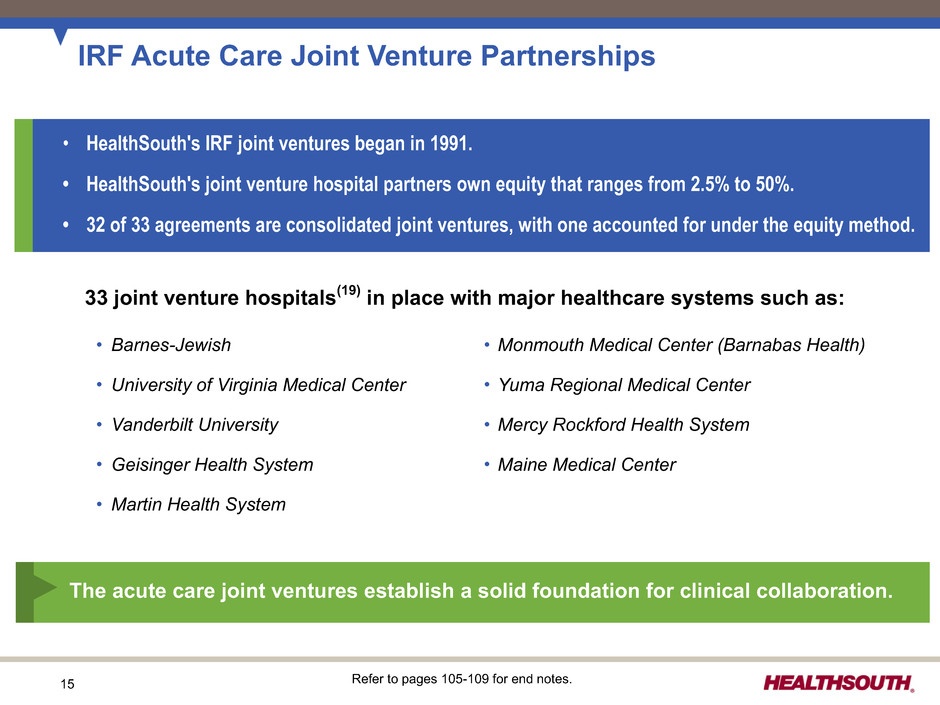
15 • HealthSouth's IRF joint ventures began in 1991. • HealthSouth's joint venture hospital partners own equity that ranges from 2.5% to 50%. • 32 of 33 agreements are consolidated joint ventures, with one accounted for under the equity method. IRF Acute Care Joint Venture Partnerships 33 joint venture hospitals(19) in place with major healthcare systems such as: The acute care joint ventures establish a solid foundation for clinical collaboration. • Barnes-Jewish • Monmouth Medical Center (Barnabas Health) • University of Virginia Medical Center • Yuma Regional Medical Center • Vanderbilt University • Mercy Rockford Health System • Geisinger Health System • Maine Medical Center • Martin Health System Refer to pages 105-109 for end notes.
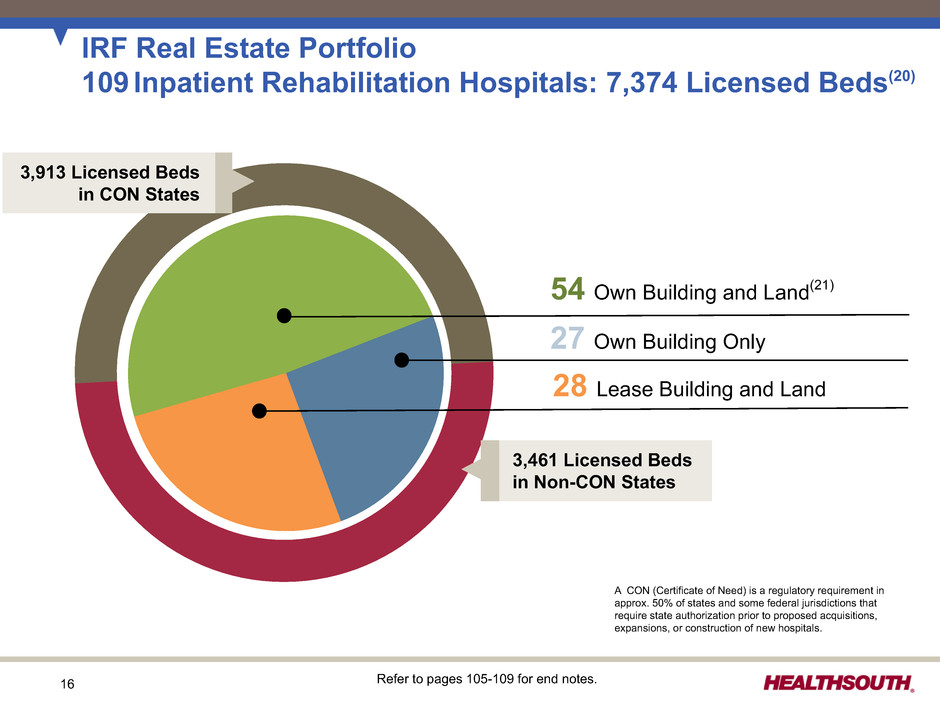
16 28 Lease Building and Land A CON (Certificate of Need) is a regulatory requirement in approx. 50% of states and some federal jurisdictions that require state authorization prior to proposed acquisitions, expansions, or construction of new hospitals. 54 Own Building and Land(21) 27 Own Building Only Refer to pages 105-109 for end notes. IRF Real Estate Portfolio 109 Inpatient Rehabilitation Hospitals: 7,374 Licensed Beds(20) 3,913 Licensed Beds in CON States 3,461 Licensed Beds in Non-CON States
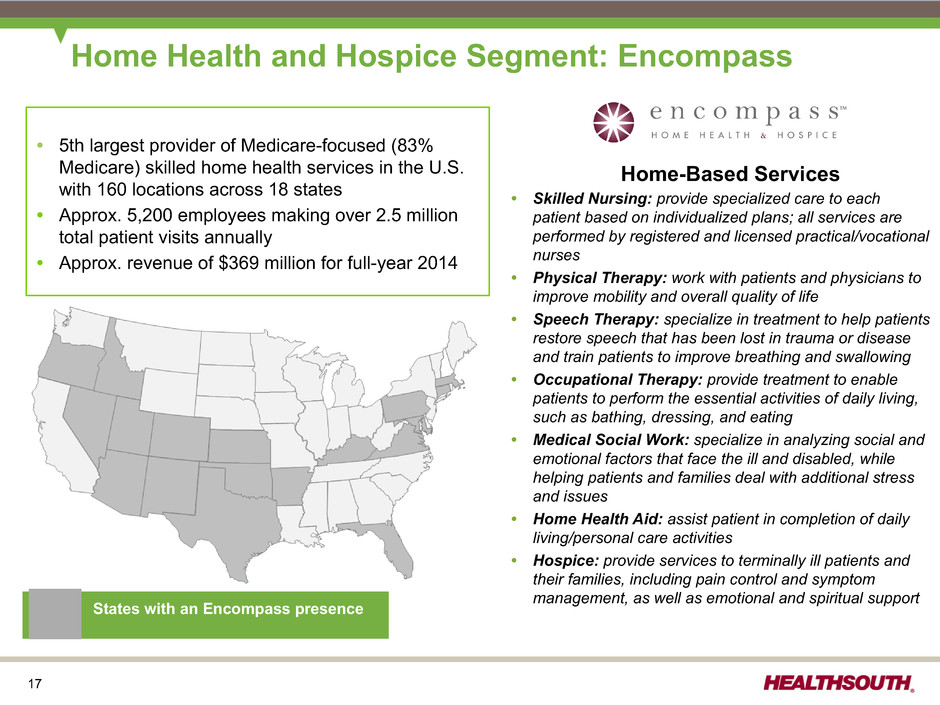
17 Home-Based Services • Skilled Nursing: provide specialized care to each patient based on individualized plans; all services are performed by registered and licensed practical/vocational nurses • Physical Therapy: work with patients and physicians to improve mobility and overall quality of life • Speech Therapy: specialize in treatment to help patients restore speech that has been lost in trauma or disease and train patients to improve breathing and swallowing • Occupational Therapy: provide treatment to enable patients to perform the essential activities of daily living, such as bathing, dressing, and eating • Medical Social Work: specialize in analyzing social and emotional factors that face the ill and disabled, while helping patients and families deal with additional stress and issues • Home Health Aid: assist patient in completion of daily living/personal care activities • Hospice: provide services to terminally ill patients and their families, including pain control and symptom management, as well as emotional and spiritual support States with an Encompass presence Home Health and Hospice Segment: Encompass • 5th largest provider of Medicare-focused (83% Medicare) skilled home health services in the U.S. with 160 locations across 18 states • Approx. 5,200 employees making over 2.5 million total patient visits annually • Approx. revenue of $369 million for full-year 2014
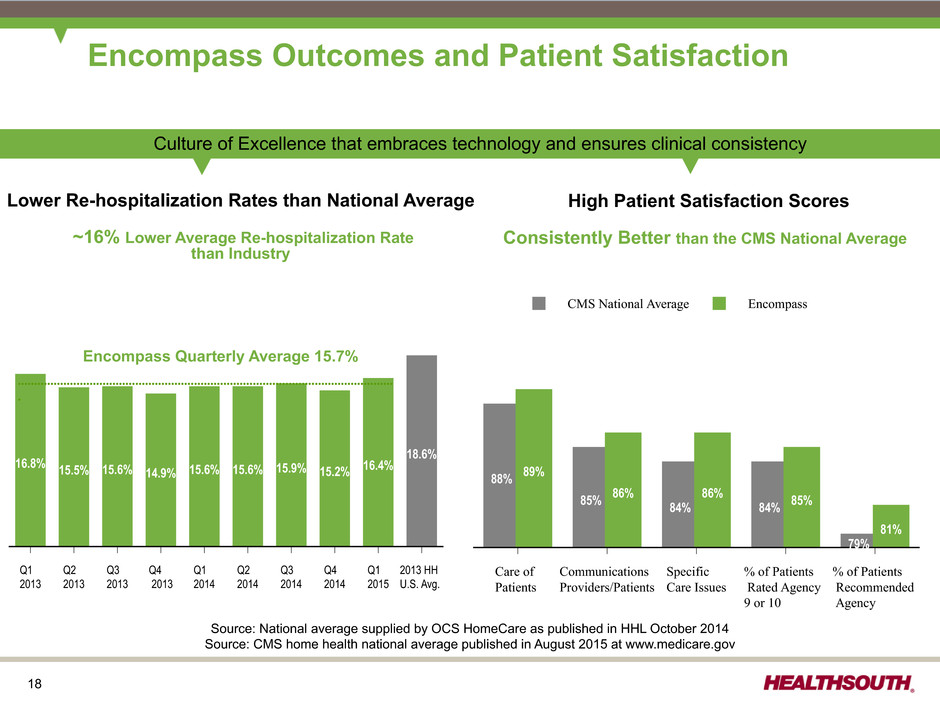
18 Q1 2013 Q2 2013 Q3 2013 Q4 2013 Q1 2014 Q2 2014 Q3 2014 Q4 2014 Q1 2015 2013 HH U.S. Avg. 16.8% 15.5% 15.6% 14.9% 15.6% 15.6% 15.9% 15.2% 16.4% 18.6% Encompass Outcomes and Patient Satisfaction Lower Re-hospitalization Rates than National Average ~16% Lower Average Re-hospitalization Rate than Industry Culture of Excellence that embraces technology and ensures clinical consistency CMS National Average Encompass Care of Patients Communications Providers/Patients Specific Care Issues % of Patients Rated Agency 9 or 10 % of Patients Recommended Agency 88% 85% 84% 84% 79% 89% 86% 86% 85% 81% High Patient Satisfaction Scores Consistently Better than the CMS National Average ................................................................................................................... . Encompass Quarterly Average 15.7% Source: National average supplied by OCS HomeCare as published in HHL October 2014 Source: CMS home health national average published in August 2015 at www.medicare.gov
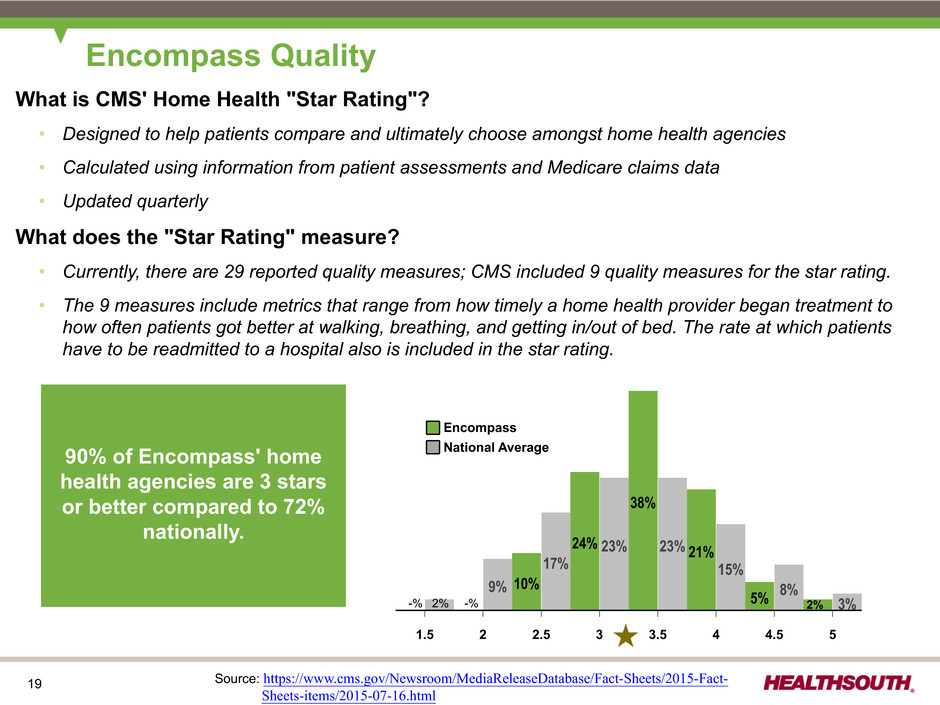
19 Encompass Quality Source: https://www.cms.gov/Newsroom/MediaReleaseDatabase/Fact-Sheets/2015-Fact- Sheets-items/2015-07-16.html What is CMS' Home Health "Star Rating"? • Designed to help patients compare and ultimately choose amongst home health agencies • Calculated using information from patient assessments and Medicare claims data • Updated quarterly What does the "Star Rating" measure? • Currently, there are 29 reported quality measures; CMS included 9 quality measures for the star rating. • The 9 measures include metrics that range from how timely a home health provider began treatment to how often patients got better at walking, breathing, and getting in/out of bed. The rate at which patients have to be readmitted to a hospital also is included in the star rating. 1.5 2 2.5 3 3.5 4 4.5 5 10% 24% 38% 21% 5% 9% 17% 23% 23% 15% 8% 3% 90% of Encompass' home health agencies are 3 stars or better compared to 72% nationally. « Encompass National Average -%-% 2% 2%
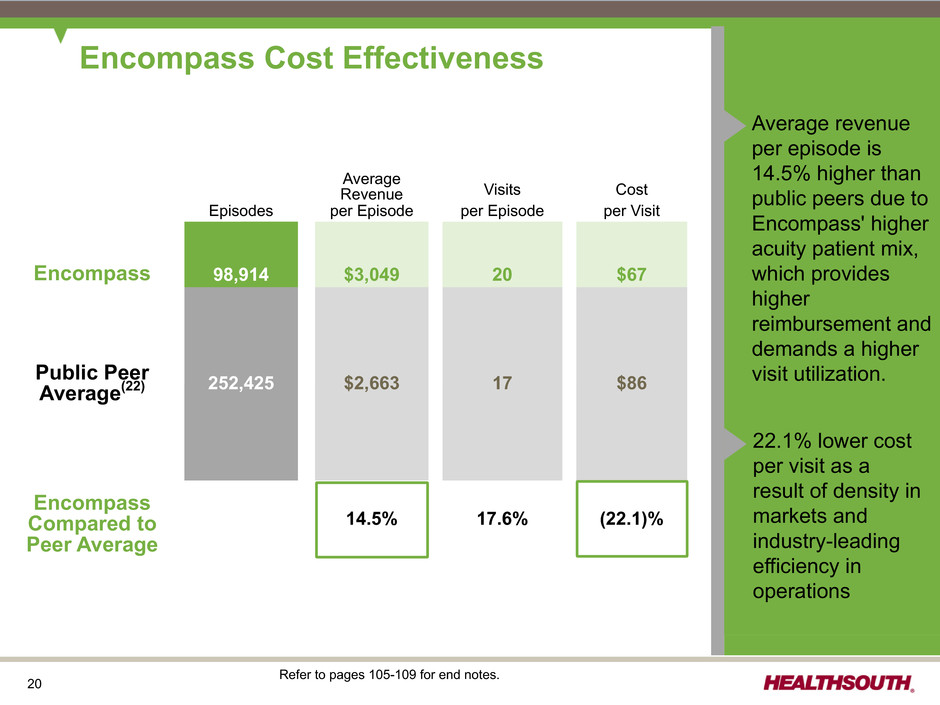
20 Encompass Cost Effectiveness Average revenue per episode is 14.5% higher than public peers due to Encompass' higher acuity patient mix, which provides higher reimbursement and demands a higher visit utilization. 22.1% lower cost per visit as a result of density in markets and industry-leading efficiency in operations Average Revenue Visits Cost Episodes per Episode per Episode per Visit Encompass 98,914 $3,049 20 $67 Public Peer Average(22) 252,425 $2,663 17 $86 Encompass Compared to Peer Average 14.5% 17.6% (22.1)% Refer to pages 105-109 for end notes.
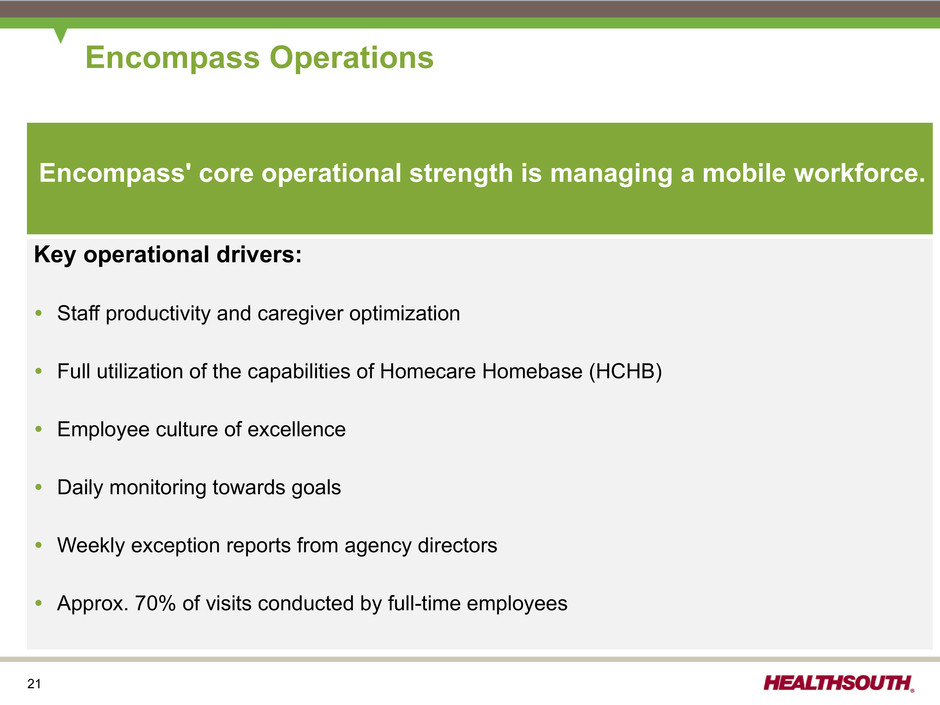
21 Key operational drivers: • Staff productivity and caregiver optimization • Full utilization of the capabilities of Homecare Homebase (HCHB) • Employee culture of excellence • Daily monitoring towards goals • Weekly exception reports from agency directors • Approx. 70% of visits conducted by full-time employees Encompass Operations Encompass' core operational strength is managing a mobile workforce.
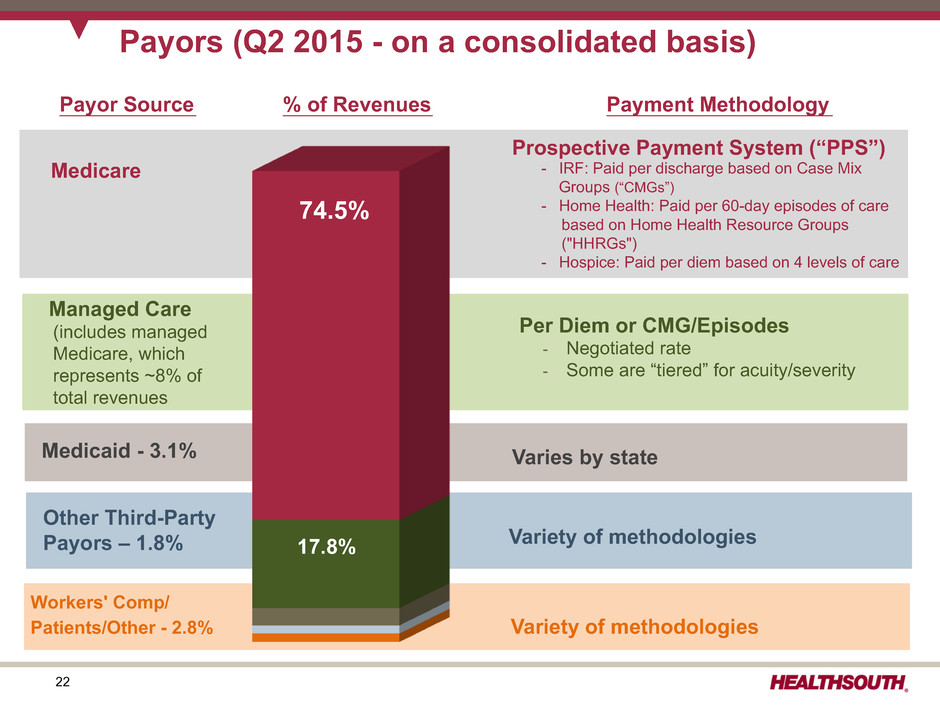
22 Workers' Comp/ Patients/Other - 2.8% Variety of methodologies Medicaid - 3.1% Prospective Payment System (“PPS”) - IRF: Paid per discharge based on Case Mix Groups (“CMGs”) - Home Health: Paid per 60-day episodes of care based on Home Health Resource Groups ("HHRGs") - Hospice: Paid per diem based on 4 levels of care Medicare Per Diem or CMG/Episodes - Negotiated rate - Some are “tiered” for acuity/severity Varies by state Variety of methodologies Managed Care (includes managed Medicare, which represents ~8% of total revenues Other Third-Party Payors – 1.8% 17.8% 74.5% Payors (Q2 2015 - on a consolidated basis) Payor Source Payment Methodology% of Revenues
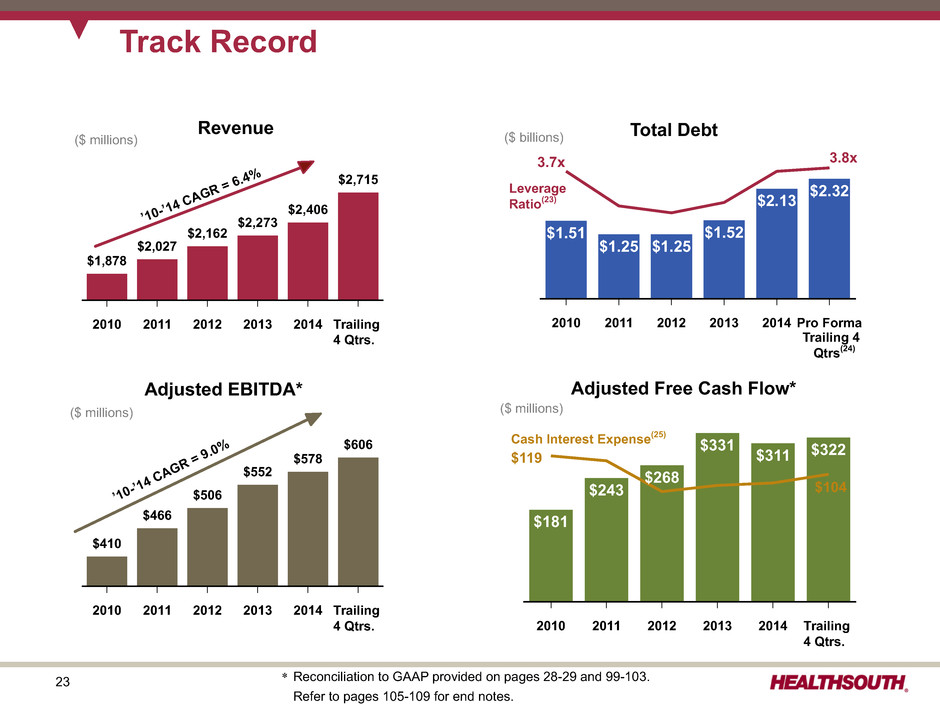
23 2010 2011 2012 2013 2014 Trailing 4 Qtrs. $181 $243 $268 $331 $311 $322 Revenue 2010 2011 2012 2013 2014 Trailing 4 Qtrs. $1,878 $2,027 $2,162 $2,273 $2,406 $2,715 Adjusted EBITDA* 2010 2011 2012 2013 2014 Trailing 4 Qtrs. $410 $466 $506 $552 $578 $606 Track Record ’10-’14 CAGR = 6.4 % ’10-’14 CAGR = 9.0 % ($ millions) ($ millions) * Reconciliation to GAAP provided on pages 28-29 and 99-103. Refer to pages 105-109 for end notes. 2010 2011 2012 2013 2014 Pro Forma $1.51 $1.25 $1.25 $1.52 $2.13 $2.32 ($ billions) Leverage Ratio(23) Total Debt ($ millions) Adjusted Free Cash Flow* Cash Interest Expense(25) 3.7x 3.8x Trailing 4 Qtrs(24) $119 $104
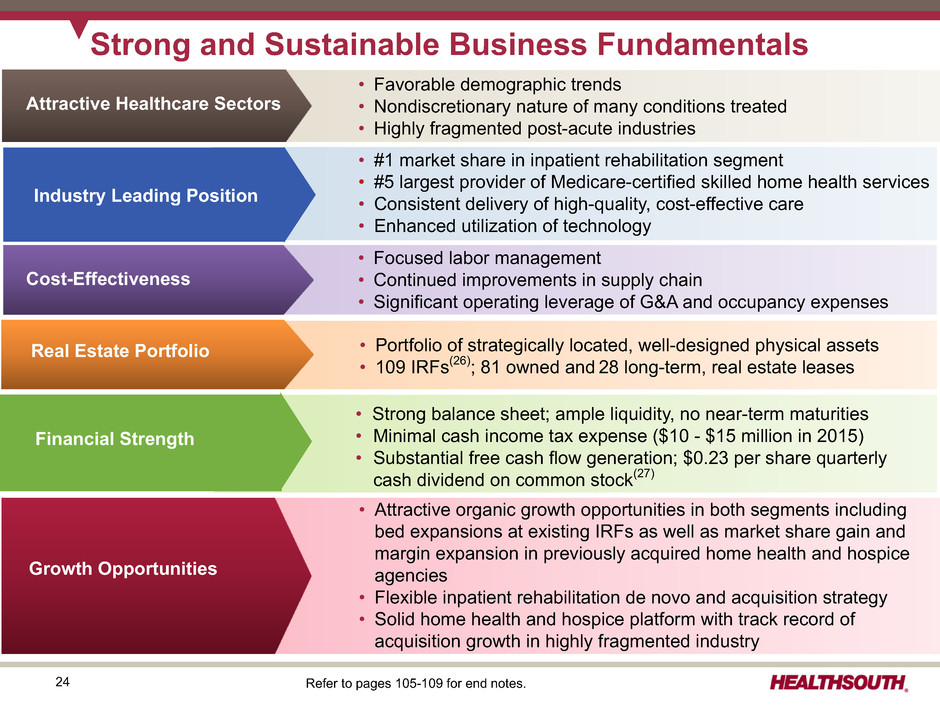
24 Strong and Sustainable Business Fundamentals • Focused labor management • Continued improvements in supply chain • Significant operating leverage of G&A and occupancy expenses Cost-Effectiveness • Strong balance sheet; ample liquidity, no near-term maturities • Minimal cash income tax expense ($10 - $15 million in 2015) • Substantial free cash flow generation; $0.23 per share quarterly cash dividend on common stock(27) • #1 market share in inpatient rehabilitation segment • #5 largest provider of Medicare-certified skilled home health services • Consistent delivery of high-quality, cost-effective care • Enhanced utilization of technology • Attractive organic growth opportunities in both segments including bed expansions at existing IRFs as well as market share gain and margin expansion in previously acquired home health and hospice agencies • Flexible inpatient rehabilitation de novo and acquisition strategy • Solid home health and hospice platform with track record of acquisition growth in highly fragmented industry • Portfolio of strategically located, well-designed physical assets • 109 IRFs(26); 81 owned and 28 long-term, real estate leases Real Estate Portfolio Attractive Healthcare Sectors Growth Opportunities Industry Leading Position Cost-Effectiveness Refer to pages 105-109 for end notes. • Favorable demographic trends • Nondiscretionary nature of many conditions treated • Highly fragmented post-acute industries Industry Leading Position Financial Strength
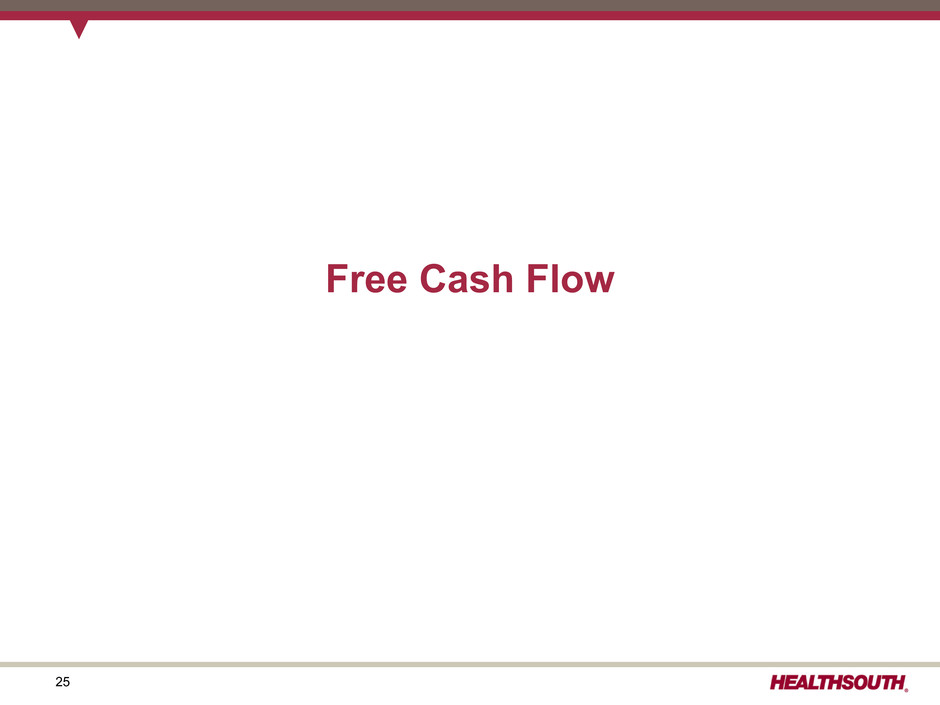
25 Free Cash Flow
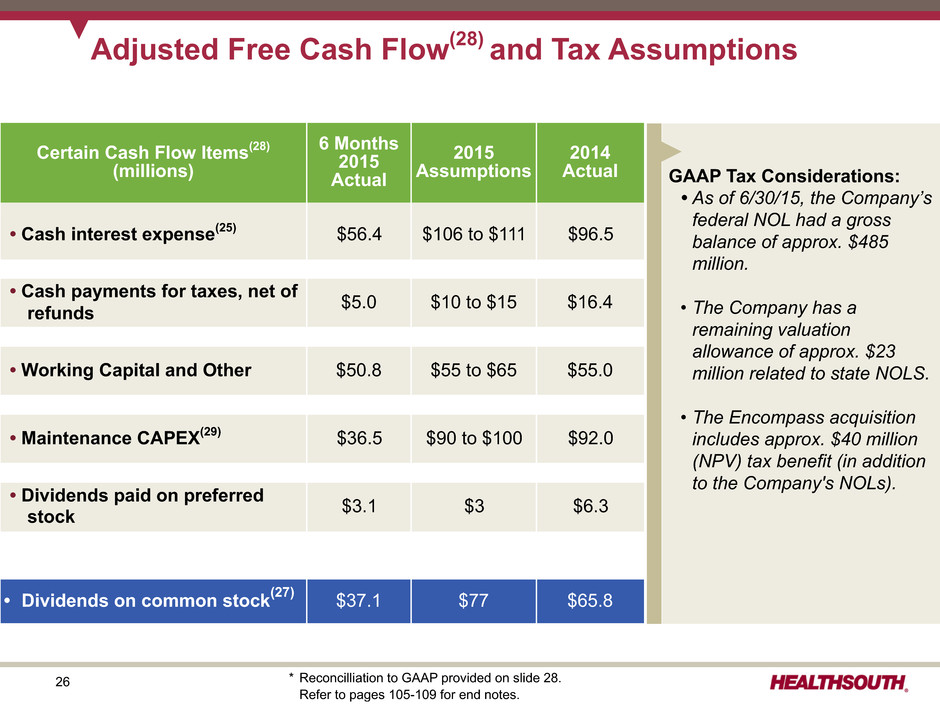
26 * Reconcilliation to GAAP provided on slide 28. Refer to pages 105-109 for end notes. Adjusted Free Cash Flow(28) and Tax Assumptions Certain Cash Flow Items(28) (millions) 6 Months 2015 Actual 2015 Assumptions 2014 Actual • Cash interest expense(25) $56.4 $106 to $111 $96.5 • Cash payments for taxes, net of refunds $5.0 $10 to $15 $16.4 • Working Capital and Other $50.8 $55 to $65 $55.0 • Maintenance CAPEX(29) $36.5 $90 to $100 $92.0 • Dividends paid on preferred stock $3.1 $3 $6.3 • Dividends on common stock(27) $37.1 $77 $65.8 GAAP Tax Considerations: • As of 6/30/15, the Company’s federal NOL had a gross balance of approx. $485 million. • The Company has a remaining valuation allowance of approx. $23 million related to state NOLS. • The Encompass acquisition includes approx. $40 million (NPV) tax benefit (in addition to the Company's NOLs).
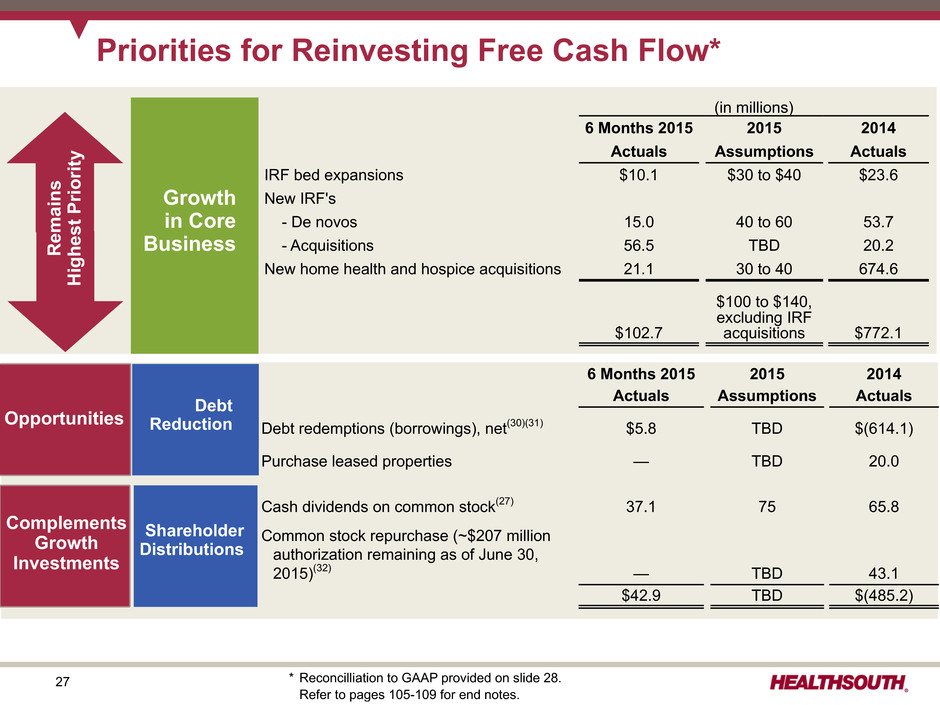
27 Priorities for Reinvesting Free Cash Flow* Opportunities (in millions) 6 Months 2015 2015 2014 Actuals Assumptions Actuals IRF bed expansions $10.1 $30 to $40 $23.6 New IRF's - De novos 15.0 40 to 60 53.7 - Acquisitions 56.5 TBD 20.2 New home health and hospice acquisitions 21.1 30 to 40 674.6 $102.7 $100 to $140, excluding IRF acquisitions $772.1 6 Months 2015 2015 2014 Actuals Assumptions Actuals Debt redemptions (borrowings), net(30)(31) $5.8 TBD $(614.1) Purchase leased properties — TBD 20.0 Cash dividends on common stock(27) 37.1 75 65.8 Common stock repurchase (~$207 million authorization remaining as of June 30, 2015)(32) — TBD 43.1 $42.9 TBD $(485.2) Complements Growth Investments Shareholder Distributions Growth in Core Business Debt Reduction Remain s Highest Priorit y * Reconcilliation to GAAP provided on slide 28. Refer to pages 105-109 for end notes.

28 Adjusted Free Cash Flow History(28) Q2 6 Months Full-Year (Millions) 2015 2014 2015 2014 2014 2013 2012 2011 2010 Net cash provided by operating activities $ 102.9 $ 128.0 $ 204.9 $ 235.1 $ 444.9 $ 470.3 $ 411.5 $ 342.7 $ 331.0 Impact of discontinued operations 0.2 1.0 0.3 1.2 1.2 1.9 (2.0) (9.1) (13.2) Net cash provided by operating activities of continuing operations 103.1 129.0 205.2 236.3 446.1 472.2 409.5 333.6 317.8 Capital expenditures for maintenance(29) (18.2) (17.6) (36.5) (47.8) (92.0) (74.8) (83.0) (50.8) (37.9) Net settlements on interest rate swaps — — — — — — — (10.9) (44.7) Dividends paid on convertible perpetual preferred stock (1.5) (1.5) (3.1) (3.1) (6.3) (23.0) (24.6) (26.0) (26.0) Distributions paid to noncontrolling interests of consolidated affiliates (13.0) (13.4) (26.2) (25.4) (54.1) (46.3) (49.3) (44.2) (34.4) Nonrecurring items: Encompass transaction costs and related assumed liabilities — — 17.7 — 2.0 — — — — Reliant transaction costs 1.6 — 1.6 — — — — — — Net premium on bond issuance/repayment 11.8 — 3.8 — 4.3 1.7 1.9 22.8 — Cash paid for professional fees - accounting, tax, and legal 2.7 2.0 3.4 3.6 8.6 7.0 16.1 21.0 17.2 Cash paid (received) for government, class action, and related settlements 8.0 (0.6) 8.0 (0.6) 2.7 (5.9) (2.6) 5.7 2.9 Income tax refunds related to prior periods — — — — — — — (7.9) (13.5) Adjusted free cash flow(28) $ 94.5 $ 97.9 $ 173.9 $ 163.0 $ 311.3 $ 330.9 $ 268.0 $ 243.3 $ 181.4 Cash dividends on common stock $ 18.5 $ 15.8 $ 37.1 $ 31.6 $ 65.8 $ 15.7 $ — $ — $ — Refer to pages 105-109 for end notes.
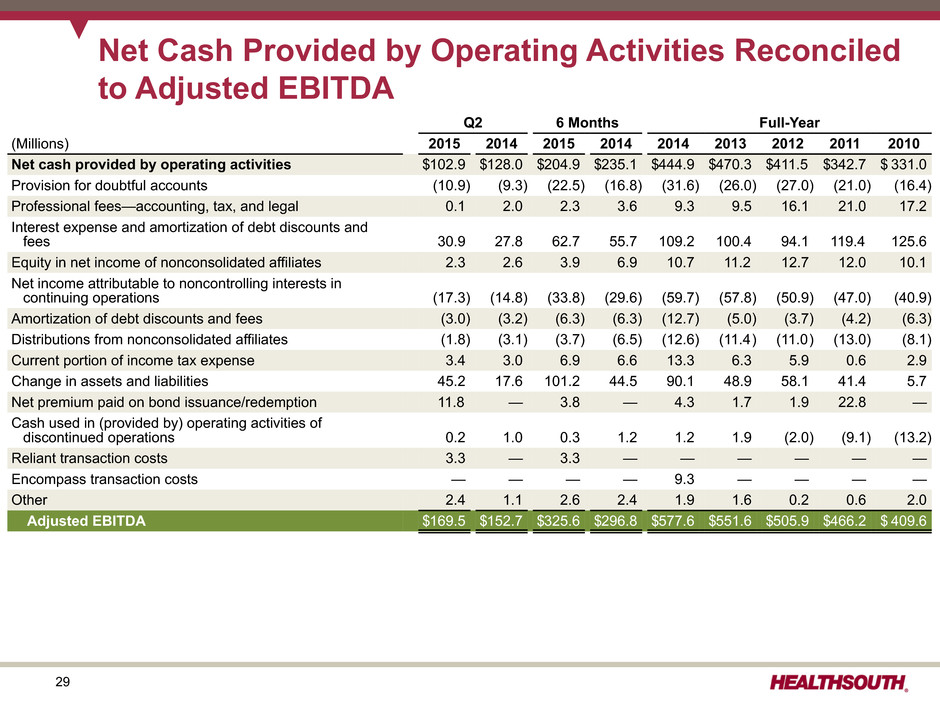
29 Net Cash Provided by Operating Activities Reconciled to Adjusted EBITDA Q2 6 Months Full-Year (Millions) 2015 2014 2015 2014 2014 2013 2012 2011 2010 Net cash provided by operating activities $102.9 $128.0 $204.9 $235.1 $444.9 $470.3 $411.5 $342.7 $ 331.0 Provision for doubtful accounts (10.9) (9.3) (22.5) (16.8) (31.6) (26.0) (27.0) (21.0) (16.4) Professional fees—accounting, tax, and legal 0.1 2.0 2.3 3.6 9.3 9.5 16.1 21.0 17.2 Interest expense and amortization of debt discounts and fees 30.9 27.8 62.7 55.7 109.2 100.4 94.1 119.4 125.6 Equity in net income of nonconsolidated affiliates 2.3 2.6 3.9 6.9 10.7 11.2 12.7 12.0 10.1 Net income attributable to noncontrolling interests in continuing operations (17.3) (14.8) (33.8) (29.6) (59.7) (57.8) (50.9) (47.0) (40.9) Amortization of debt discounts and fees (3.0) (3.2) (6.3) (6.3) (12.7) (5.0) (3.7) (4.2) (6.3) Distributions from nonconsolidated affiliates (1.8) (3.1) (3.7) (6.5) (12.6) (11.4) (11.0) (13.0) (8.1) Current portion of income tax expense 3.4 3.0 6.9 6.6 13.3 6.3 5.9 0.6 2.9 Change in assets and liabilities 45.2 17.6 101.2 44.5 90.1 48.9 58.1 41.4 5.7 Net premium paid on bond issuance/redemption 11.8 — 3.8 — 4.3 1.7 1.9 22.8 — Cash used in (provided by) operating activities of discontinued operations 0.2 1.0 0.3 1.2 1.2 1.9 (2.0) (9.1) (13.2) Reliant transaction costs 3.3 — 3.3 — — — — — — Encompass transaction costs — — — — 9.3 — — — — Other 2.4 1.1 2.6 2.4 1.9 1.6 0.2 0.6 2.0 Adjusted EBITDA $169.5 $152.7 $325.6 $296.8 $577.6 $551.6 $505.9 $466.2 $ 409.6

30 Growth
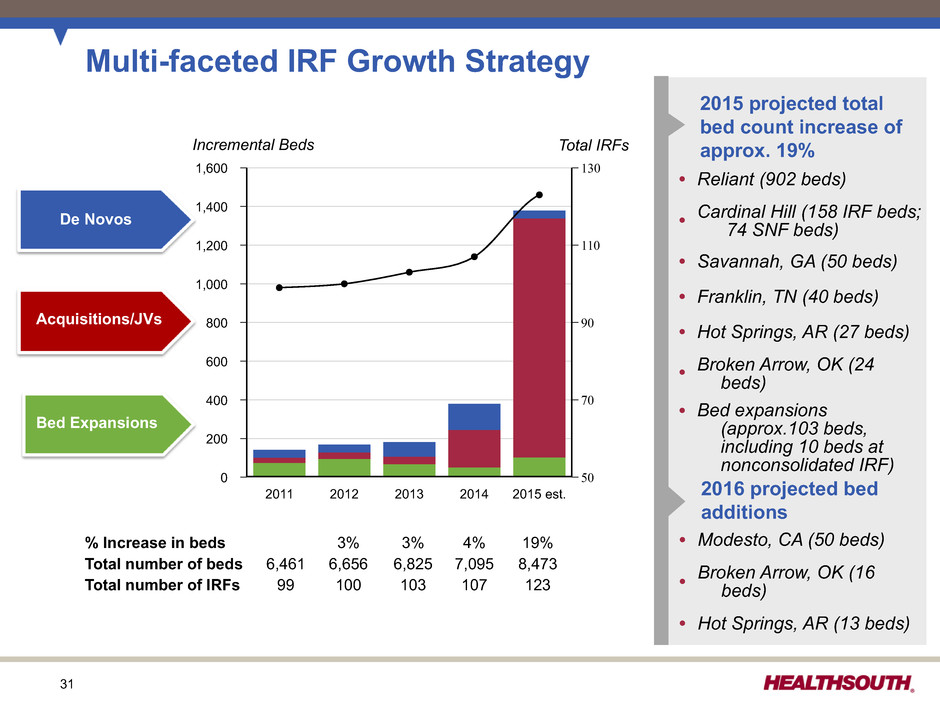
31 % Increase in beds 3% 3% 4% 19% Total number of beds 6,461 6,656 6,825 7,095 8,473 Total number of IRFs 99 100 103 107 123 1,600 1,400 1,200 1,000 800 600 400 200 0 130 110 90 70 50 2011 2012 2013 2014 2015 est. Multi-faceted IRF Growth Strategy 2015 projected total bed count increase of approx. 19% Ÿ Reliant (902 beds) Ÿ Cardinal Hill (158 IRF beds;74 SNF beds) Ÿ Savannah, GA (50 beds) Ÿ Franklin, TN (40 beds) Ÿ Hot Springs, AR (27 beds) Ÿ Broken Arrow, OK (24beds) Ÿ Bed expansions (approx.103 beds, including 10 beds at nonconsolidated IRF) De Novos Acquisitions/JVs Bed Expansions Total IRFsIncremental Beds 2016 projected bed additions Ÿ Modesto, CA (50 beds) Ÿ Broken Arrow, OK (16beds) Ÿ Hot Springs, AR (13 beds)
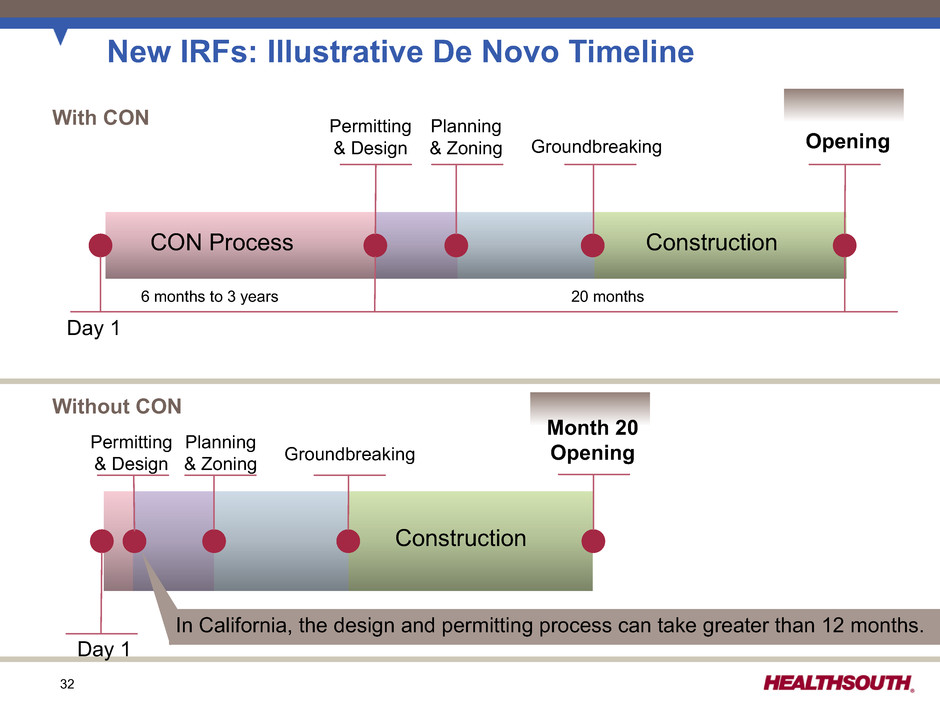
32 New IRFs: Illustrative De Novo Timeline Day 1 With CON Permitting & Design Planning & Zoning Groundbreaking Permitting & Design Planning & Zoning Groundbreaking Day 1 Without CON 6 months to 3 years 20 months CON Process Construction Construction Opening Month 20 Opening In California, the design and permitting process can take greater than 12 months.
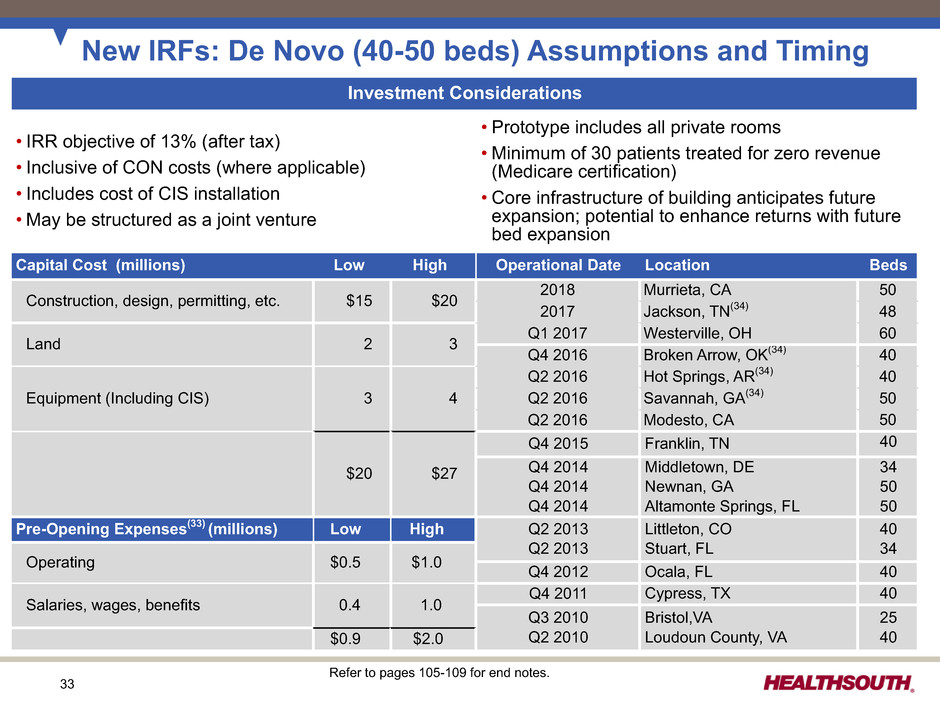
33 Investment Considerations • IRR objective of 13% (after tax) • Inclusive of CON costs (where applicable) • Includes cost of CIS installation • May be structured as a joint venture • Prototype includes all private rooms • Minimum of 30 patients treated for zero revenue (Medicare certification) • Core infrastructure of building anticipates future expansion; potential to enhance returns with future bed expansion Capital Cost (millions) Low High Operational Date Location Beds Construction, design, permitting, etc. $15 $20 2018 Murrieta, CA 502017 Jackson, TN(34) 48 Land 2 3 Q1 2017 Westerville, OH 60Q4 2016 Broken Arrow, OK(34) 40 Equipment (Including CIS) 3 4 Q2 2016 Hot Springs, AR(34) 40 Q2 2016 Savannah, GA(34) 50 Q2 2016 Modesto, CA 50 $20 $27 Q4 2015 Franklin, TN 40 Q4 2014 Q4 2014 Q4 2014 Middletown, DE Newnan, GA Altamonte Springs, FL 34 50 50 Pre-Opening Expenses(33) (millions) Low High Q2 2013 Q2 2013 Littleton, CO Stuart, FL 40 34 Operating $0.5 $1.0 Q4 2012 Ocala, FL 40 Salaries, wages, benefits 0.4 1.0 Q4 2011 Cypress, TX 40 Q3 2010 Q2 2010 Bristol,VA Loudoun County, VA 25 40$0.9 $2.0 New IRFs: De Novo (40-50 beds) Assumptions and Timing Refer to pages 105-109 for end notes.
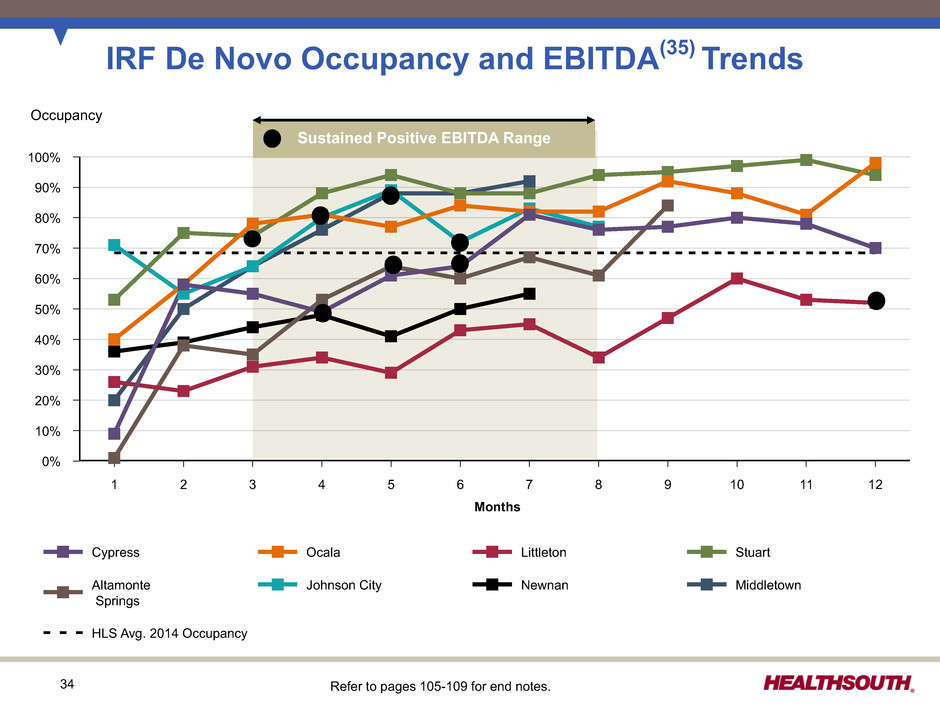
34 Cypress Ocala Littleton Stuart Altamonte Springs Johnson City Newnan Middletown HLS Avg. 2014 Occupancy 100% 90% 80% 70% 60% 50% 40% 30% 20% 10% 0% 1 2 3 4 5 6 7 8 9 10 11 12 Months IRF De Novo Occupancy and EBITDA(35) Trends Occupancy Sustained Positive EBITDA Range Refer to pages 105-109 for end notes.
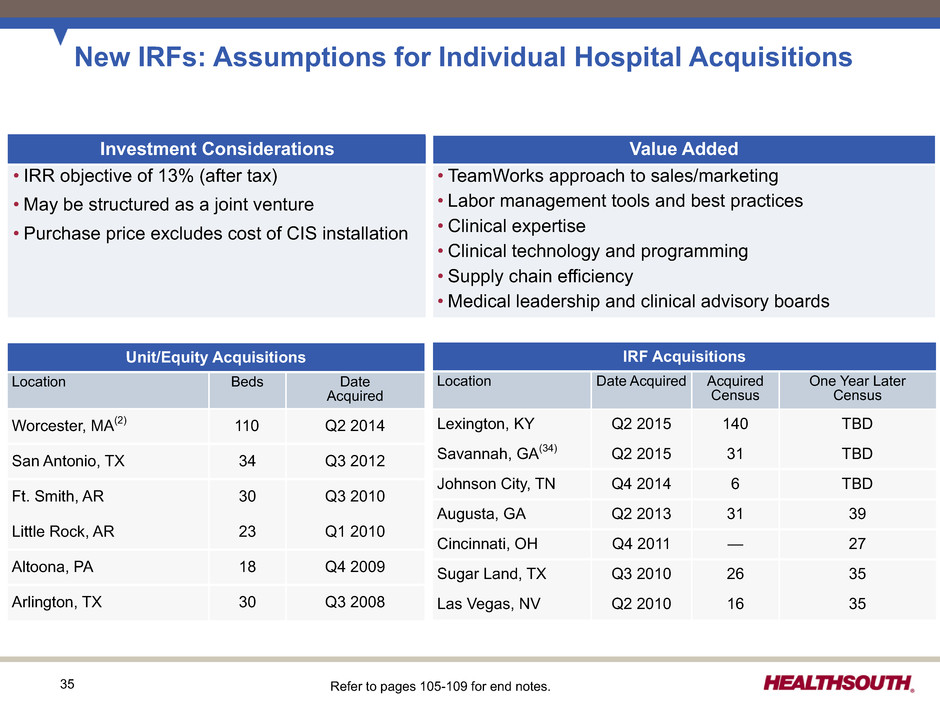
35 New IRFs: Assumptions for Individual Hospital Acquisitions Unit/Equity Acquisitions Location Beds Date Acquired Worcester, MA(2) 110 Q2 2014 San Antonio, TX 34 Q3 2012 Ft. Smith, AR 30 Q3 2010 Little Rock, AR 23 Q1 2010 Altoona, PA 18 Q4 2009 Arlington, TX 30 Q3 2008 IRF Acquisitions Location Date Acquired Acquired Census One Year Later Census Lexington, KY Q2 2015 140 TBD Savannah, GA(34) Q2 2015 31 TBD Johnson City, TN Q4 2014 6 TBD Augusta, GA Q2 2013 31 39 Cincinnati, OH Q4 2011 — 27 Sugar Land, TX Q3 2010 26 35 Las Vegas, NV Q2 2010 16 35 Investment Considerations Value Added • IRR objective of 13% (after tax) • May be structured as a joint venture • Purchase price excludes cost of CIS installation • TeamWorks approach to sales/marketing • Labor management tools and best practices • Clinical expertise • Clinical technology and programming • Supply chain efficiency • Medical leadership and clinical advisory boards Refer to pages 105-109 for end notes.
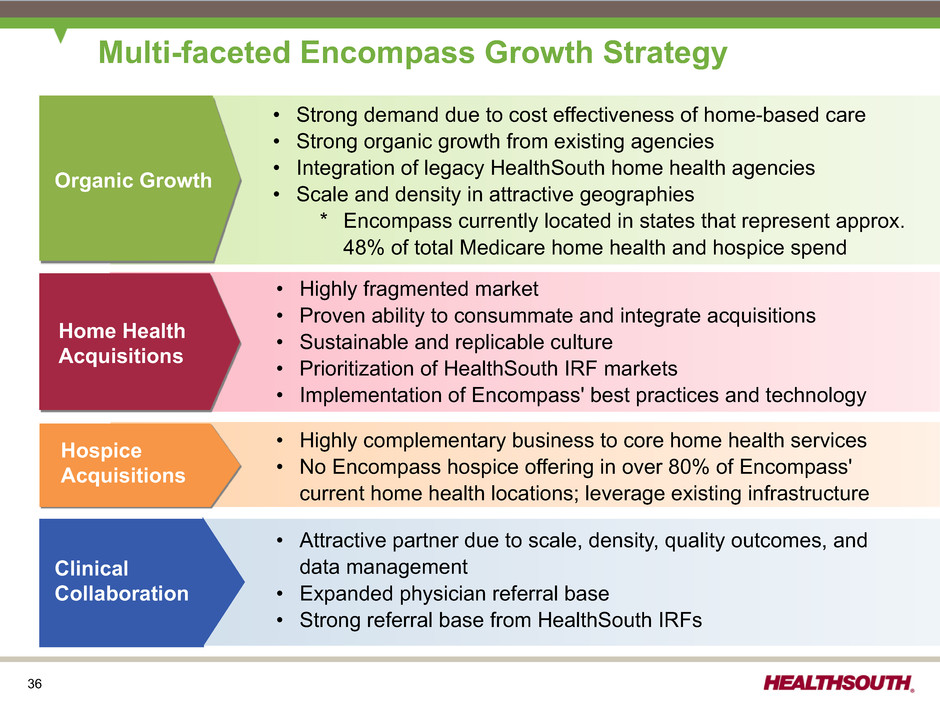
36 Organic Growth • Strong demand due to cost effectiveness of home-based care • Strong organic growth from existing agencies • Integration of legacy HealthSouth home health agencies • Scale and density in attractive geographies * Encompass currently located in states that represent approx. 48% of total Medicare home health and hospice spend • Attractive partner due to scale, density, quality outcomes, and data management • Expanded physician referral base • Strong referral base from HealthSouth IRFs Cost Assessment • Highly fragmented market • Proven ability to consummate and integrate acquisitions • Sustainable and replicable culture • Prioritization of HealthSouth IRF markets • Implementation of Encompass' best practices and technology Home Health Acquisitions Hospice Acquisitions Clinical Collaboration Multi-faceted Encompass Growth Strategy • Highly complementary business to core home health services • No Encompass hospice offering in over 80% of Encompass' current home health locations; leverage existing infrastructure
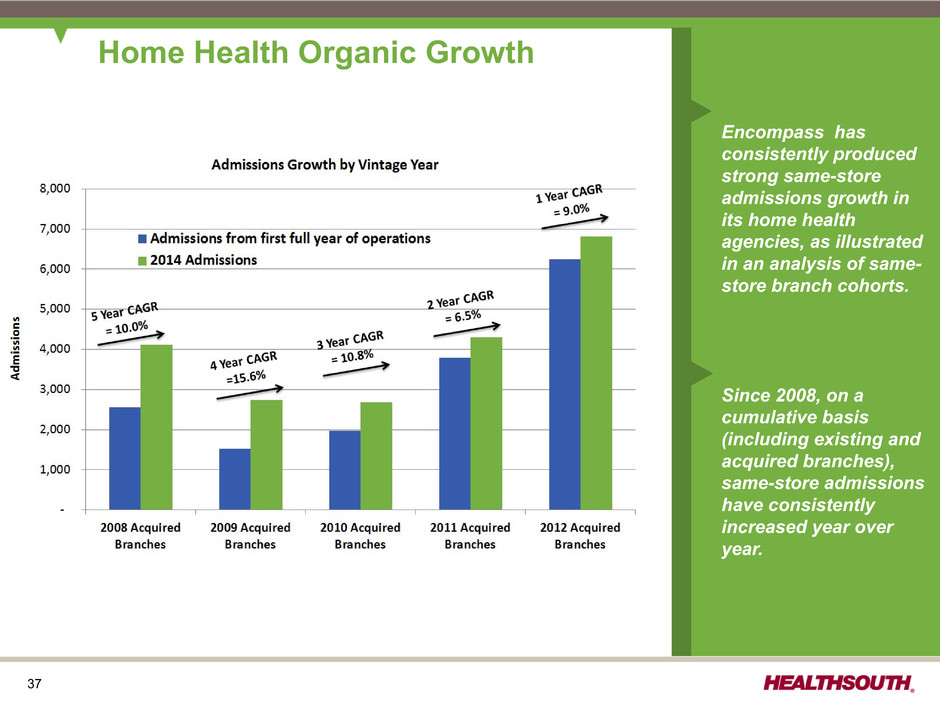
37 Home Health Organic Growth Encompass has consistently produced strong same-store admissions growth in its home health agencies, as illustrated in an analysis of same- store branch cohorts. Since 2008, on a cumulative basis (including existing and acquired branches), same-store admissions have consistently increased year over year.
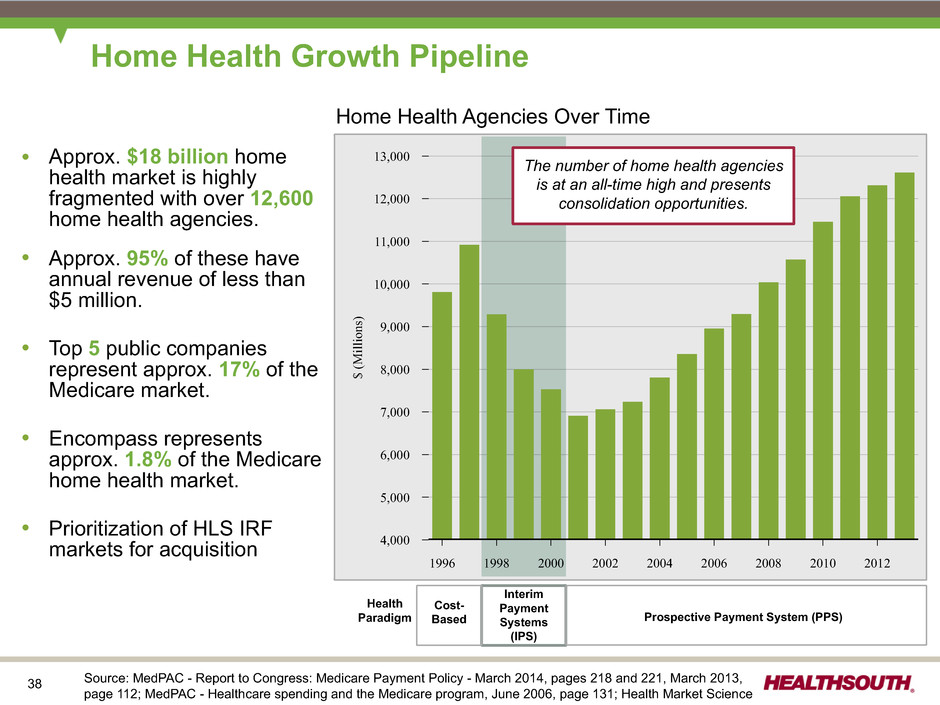
38 13,000 12,000 11,000 10,000 9,000 8,000 7,000 6,000 5,000 4,000 $ (M ill io ns ) 1996 1998 2000 2002 2004 2006 2008 2010 2012 Home Health Growth Pipeline Ÿ Approx. $18 billion home health market is highly fragmented with over 12,600 home health agencies. Ÿ Approx. 95% of these have annual revenue of less than $5 million. Ÿ Top 5 public companies represent approx. 17% of the Medicare market. Ÿ Encompass represents approx. 1.8% of the Medicare home health market. Ÿ Prioritization of HLS IRF markets for acquisition Home Health Agencies Over Time Health Paradigm Cost- Based Interim Payment Systems (IPS) Prospective Payment System (PPS) The number of home health agencies is at an all-time high and presents consolidation opportunities. Source: MedPAC - Report to Congress: Medicare Payment Policy - March 2014, pages 218 and 221, March 2013, page 112; MedPAC - Healthcare spending and the Medicare program, June 2006, page 131; Health Market Science
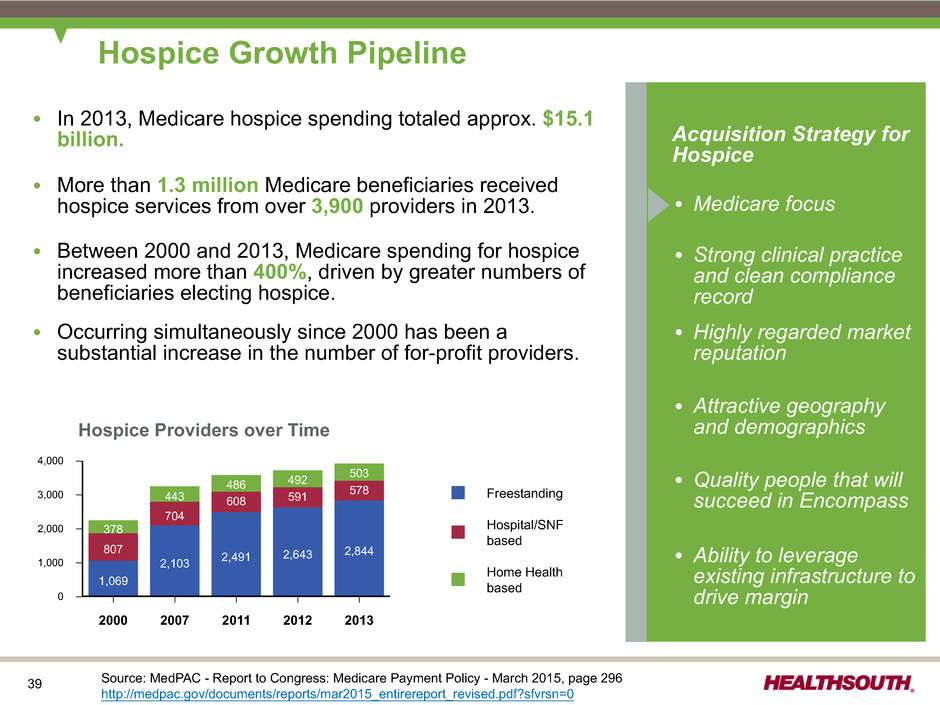
39 Hospice Growth Pipeline Ÿ In 2013, Medicare hospice spending totaled approx. $15.1 billion. Ÿ More than 1.3 million Medicare beneficiaries received hospice services from over 3,900 providers in 2013. Ÿ Between 2000 and 2013, Medicare spending for hospice increased more than 400%, driven by greater numbers of beneficiaries electing hospice. Ÿ Occurring simultaneously since 2000 has been a substantial increase in the number of for-profit providers. Acquisition Strategy for Hospice Ÿ Medicare focus Ÿ Strong clinical practice and clean compliance record Ÿ Highly regarded market reputation Ÿ Attractive geography and demographics Ÿ Quality people that will succeed in Encompass Ÿ Ability to leverage existing infrastructure to drive margin Freestanding Hospital/SNF based Home Health based 4,000 3,000 2,000 1,000 0 2000 2007 2011 2012 2013 1,069 2,103 2,491 2,643 2,844807 704 608 591 578 378 443 486 492 503 Hospice Providers over Time Source: MedPAC - Report to Congress: Medicare Payment Policy - March 2015, page 296 http://medpac.gov/documents/reports/mar2015_entirereport_revised.pdf?sfvrsn=0
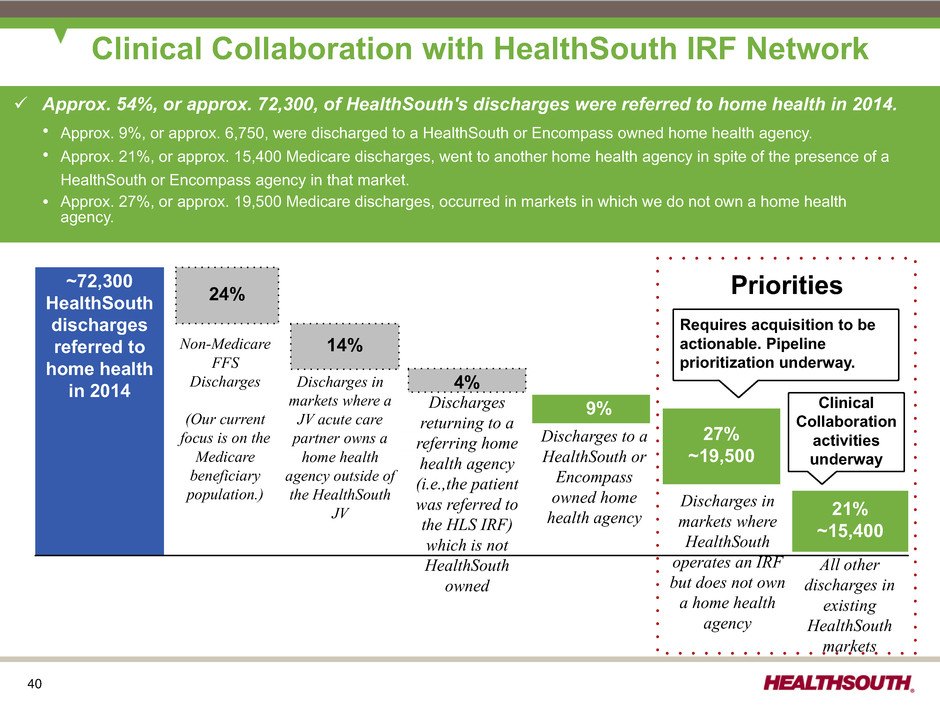
40 HealthSouth 70% non-overlap 24% Clinical Collaboration with HealthSouth IRF Network ~72,300 HealthSouth discharges referred to home health in 2014 Non-Medicare FFS Discharges (Our current focus is on the Medicare beneficiary population.) 14% 4%Discharges in markets where a JV acute care partner owns a home health agency outside of the HealthSouth JV Discharges returning to a referring home health agency (i.e.,the patient was referred to the HLS IRF) which is not HealthSouth owned 9% 27% ~19,500 21% ~15,400 Discharges to a HealthSouth or Encompass owned home health agency Discharges in markets where HealthSouth operates an IRF but does not own a home health agency All other discharges in existing HealthSouth markets Priorities Requires acquisition to be actionable. Pipeline prioritization underway. Clinical Collaboration activities underway ü Approx. 54%, or approx. 72,300, of HealthSouth's discharges were referred to home health in 2014. Ÿ Approx. 9%, or approx. 6,750, were discharged to a HealthSouth or Encompass owned home health agency. Ÿ Approx. 21%, or approx. 15,400 Medicare discharges, went to another home health agency in spite of the presence of a HealthSouth or Encompass agency in that market. Ÿ Approx. 27%, or approx. 19,500 Medicare discharges, occurred in markets in which we do not own a home health agency.

41 • In Q2 2014, Encompass was selected as Premier’s exclusive preferred home health provider. • Premier ACO includes approx. 20,000 covered lives in north Texas and southern Oklahoma. • Limited overlap in referral base results in virtually no cannibalization of existing business. Example of Clinical Collaboration Model: Premier ACO Partnership Overview: • Exclusive preferred home health and hospice provider • Care coordination and transitional care services on the most at-risk patient population • In addition to revenue from servicing ACO patients, Encompass has the potential to receive a portion of the overall ACO cost savings, as calculated by Medicare. Encompass role: Source: http://www.premierphc.com/PremierNewsDetail.aspx?id=26
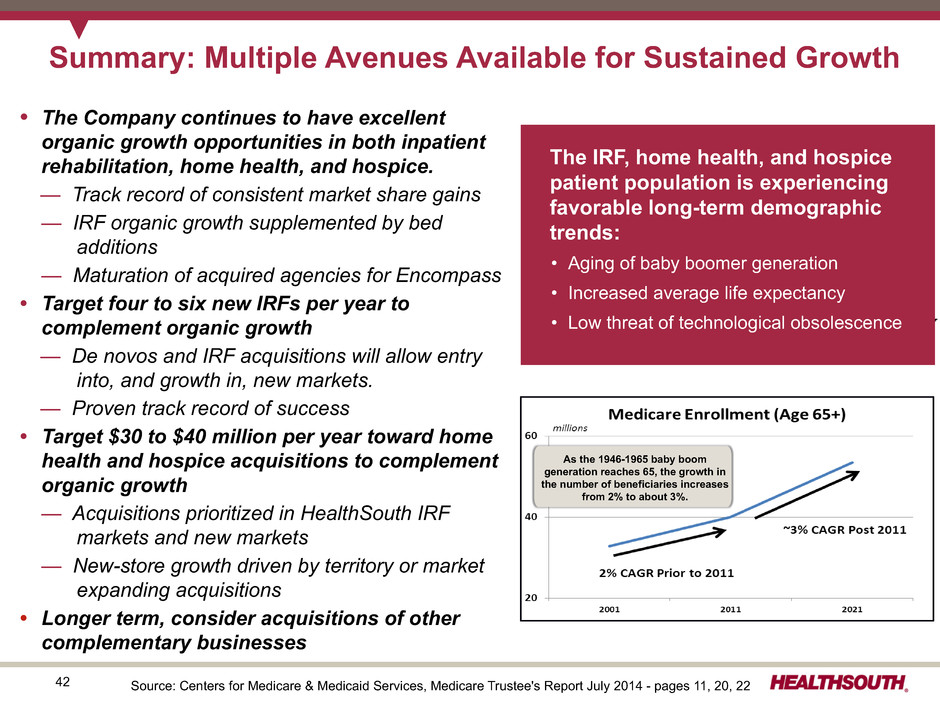
42 Summary: Multiple Avenues Available for Sustained Growth • The Company continues to have excellent organic growth opportunities in both inpatient rehabilitation, home health, and hospice. — Track record of consistent market share gains — IRF organic growth supplemented by bed additions — Maturation of acquired agencies for Encompass • Target four to six new IRFs per year to complement organic growth — De novos and IRF acquisitions will allow entry into, and growth in, new markets. — Proven track record of success • Target $30 to $40 million per year toward home health and hospice acquisitions to complement organic growth — Acquisitions prioritized in HealthSouth IRF markets and new markets — New-store growth driven by territory or market expanding acquisitions • Longer term, consider acquisitions of other complementary businesses As the 1946-1965 baby boom generation reaches 65, the growth in the number of beneficiaries increases from 2% to about 3%. Source: Centers for Medicare & Medicaid Services, Medicare Trustee's Report July 2014 - pages 11, 20, 22 The IRF, home health, and hospice patient population is experiencing favorable long-term demographic trends: • Aging of baby boomer generation • Increased average life expectancy • Low threat of technological obsolescence

43 Capital Structure
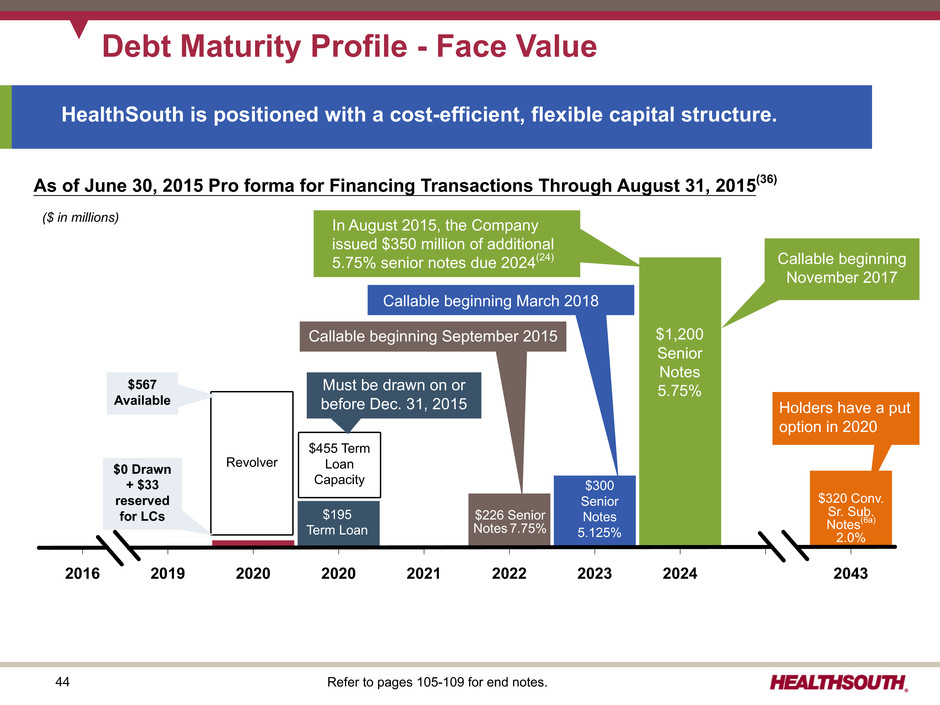
44 Refer to pages 105-109 for end notes. 2016 2019 2020 2020 2021 2022 2023 2024 2043 $300 Senior Notes 5.125% $1,200 Senior Notes 5.75% $320 Conv. Sr. Sub. Notes(6a) 2.0% $226 Senior Notes 7.75% Revolver$0 Drawn + $33 reserved for LCs Holders have a put option in 2020 Debt Maturity Profile - Face Value Callable beginning September 2015 ($ in millions) $567 Available $195 Term Loan Callable beginning November 2017 HealthSouth is positioned with a cost-efficient, flexible capital structure. Callable beginning March 2018 In August 2015, the Company issued $350 million of additional 5.75% senior notes due 2024(24) $455 Term Loan Capacity As of June 30, 2015 Pro forma for Financing Transactions Through August 31, 2015(36) Must be drawn on or before Dec. 31, 2015
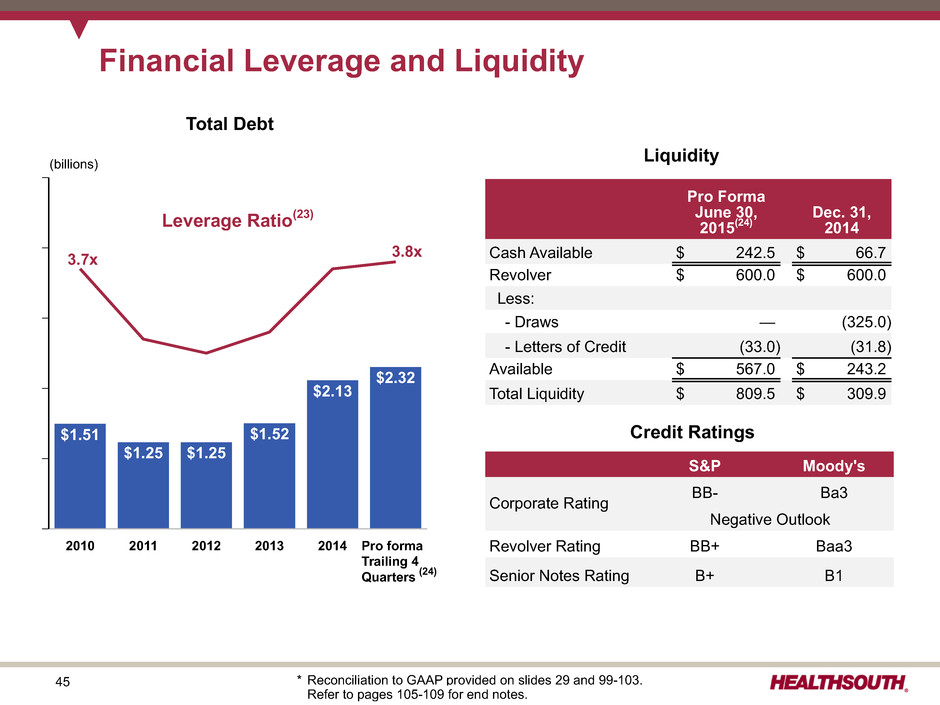
45 S&P Moody's Corporate Rating BB- Ba3 Negative Outlook Revolver Rating BB+ Baa3 Senior Notes Rating B+ B1 Financial Leverage and Liquidity (1) Liquidity Credit Ratings 2010 2011 2012 2013 2014 Pro forma Trailing 4 Quarters $1.51 $1.25 $1.25 $1.52 $2.13 $2.32 (billions) Leverage Ratio(23) Total Debt 3.7x 3.8x Pro Forma June 30, 2015(24) Dec. 31, 2014 Cash Available $ 242.5 $ 66.7 Revolver $ 600.0 $ 600.0 Less: - Draws — (325.0) - Letters of Credit (33.0) (31.8) Available $ 567.0 $ 243.2 Total Liquidity $ 809.5 $ 309.9 (24) * Reconciliation to GAAP provided on slides 29 and 99-103. Refer to pages 105-109 for end notes.
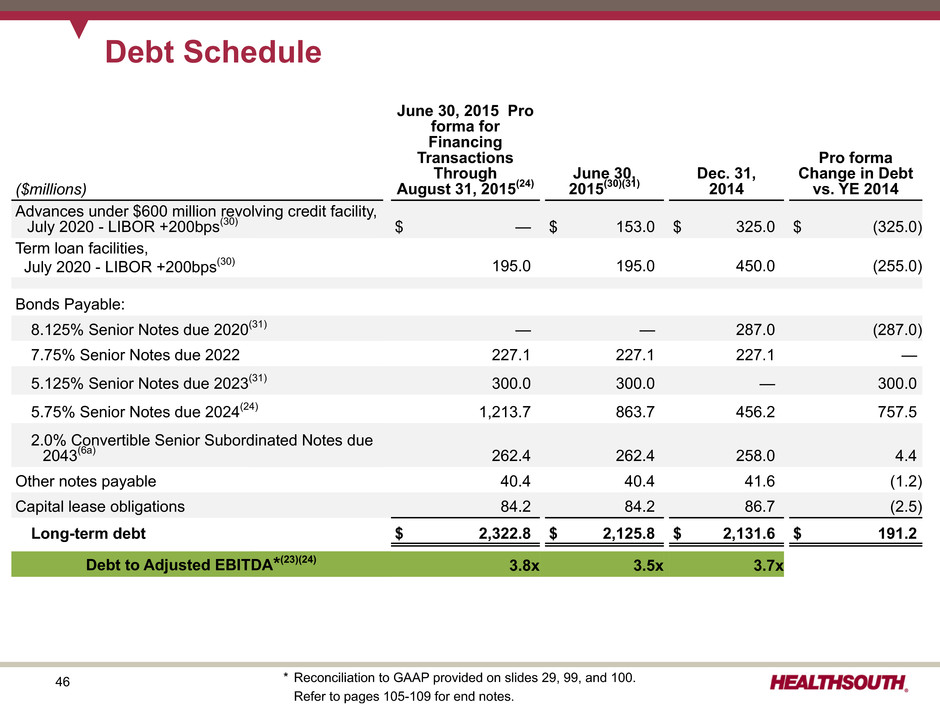
46 * Reconciliation to GAAP provided on slides 29, 99, and 100. Refer to pages 105-109 for end notes. Debt Schedule June 30, 2015 Pro forma for Financing Transactions Through August 31, 2015(24) June 30, 2015(30)(31) Dec. 31, 2014 Pro forma Change in Debt vs. YE 2014($millions) Advances under $600 million revolving credit facility, July 2020 - LIBOR +200bps(30) $ — $ 153.0 $ 325.0 $ (325.0) Term loan facilities, July 2020 - LIBOR +200bps(30) 195.0 195.0 450.0 (255.0) Bonds Payable: 8.125% Senior Notes due 2020(31) — — 287.0 (287.0) 7.75% Senior Notes due 2022 227.1 227.1 227.1 — 5.125% Senior Notes due 2023(31) 300.0 300.0 — 300.0 5.75% Senior Notes due 2024(24) 1,213.7 863.7 456.2 757.5 2.0% Convertible Senior Subordinated Notes due 2043(6a) 262.4 262.4 258.0 4.4 Other notes payable 40.4 40.4 41.6 (1.2) Capital lease obligations 84.2 84.2 86.7 (2.5) Long-term debt $ 2,322.8 $ 2,125.8 $ 2,131.6 $ 191.2 Debt to Adjusted EBITDA*(23)(24) 3.8x 3.5x 3.7x
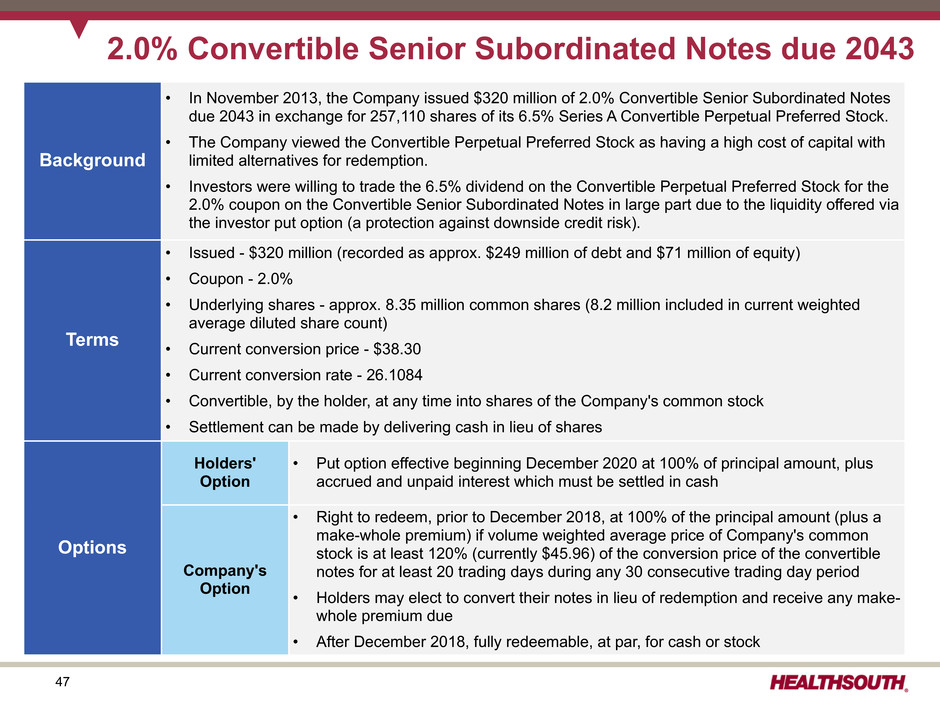
47 2.0% Convertible Senior Subordinated Notes due 2043 Background • In November 2013, the Company issued $320 million of 2.0% Convertible Senior Subordinated Notes due 2043 in exchange for 257,110 shares of its 6.5% Series A Convertible Perpetual Preferred Stock. • The Company viewed the Convertible Perpetual Preferred Stock as having a high cost of capital with limited alternatives for redemption. • Investors were willing to trade the 6.5% dividend on the Convertible Perpetual Preferred Stock for the 2.0% coupon on the Convertible Senior Subordinated Notes in large part due to the liquidity offered via the investor put option (a protection against downside credit risk). Terms • Issued - $320 million (recorded as approx. $249 million of debt and $71 million of equity) • Coupon - 2.0% • Underlying shares - approx. 8.35 million common shares (8.2 million included in current weighted average diluted share count) • Current conversion price - $38.30 • Current conversion rate - 26.1084 • Convertible, by the holder, at any time into shares of the Company's common stock • Settlement can be made by delivering cash in lieu of shares Options Holders' Option • Put option effective beginning December 2020 at 100% of principal amount, plus accrued and unpaid interest which must be settled in cash Company's Option • Right to redeem, prior to December 2018, at 100% of the principal amount (plus a make-whole premium) if volume weighted average price of Company's common stock is at least 120% (currently $45.96) of the conversion price of the convertible notes for at least 20 trading days during any 30 consecutive trading day period • Holders may elect to convert their notes in lieu of redemption and receive any make- whole premium due • After December 2018, fully redeemable, at par, for cash or stock
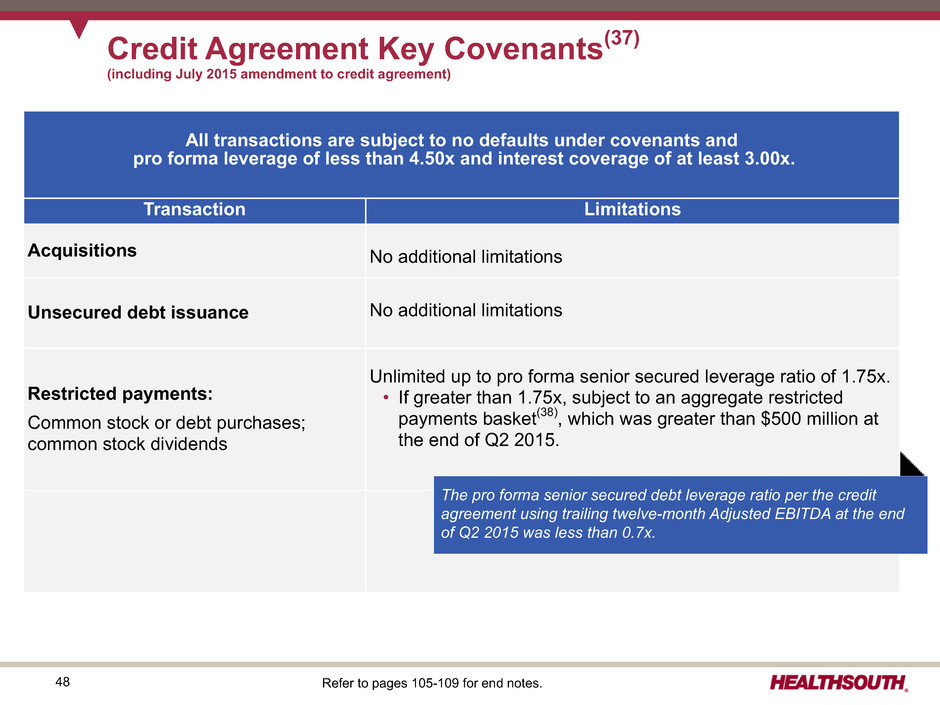
48 Credit Agreement Key Covenants(37) (including July 2015 amendment to credit agreement) All transactions are subject to no defaults under covenants and pro forma leverage of less than 4.50x and interest coverage of at least 3.00x. Transaction Limitations Acquisitions No additional limitations Unsecured debt issuance No additional limitations Restricted payments: Common stock or debt purchases; common stock dividends Unlimited up to pro forma senior secured leverage ratio of 1.75x. • If greater than 1.75x, subject to an aggregate restricted payments basket(38), which was greater than $500 million at the end of Q2 2015. The pro forma senior secured debt leverage ratio per the credit agreement using trailing twelve-month Adjusted EBITDA at the end of Q2 2015 was less than 0.7x. Refer to pages 105-109 for end notes.
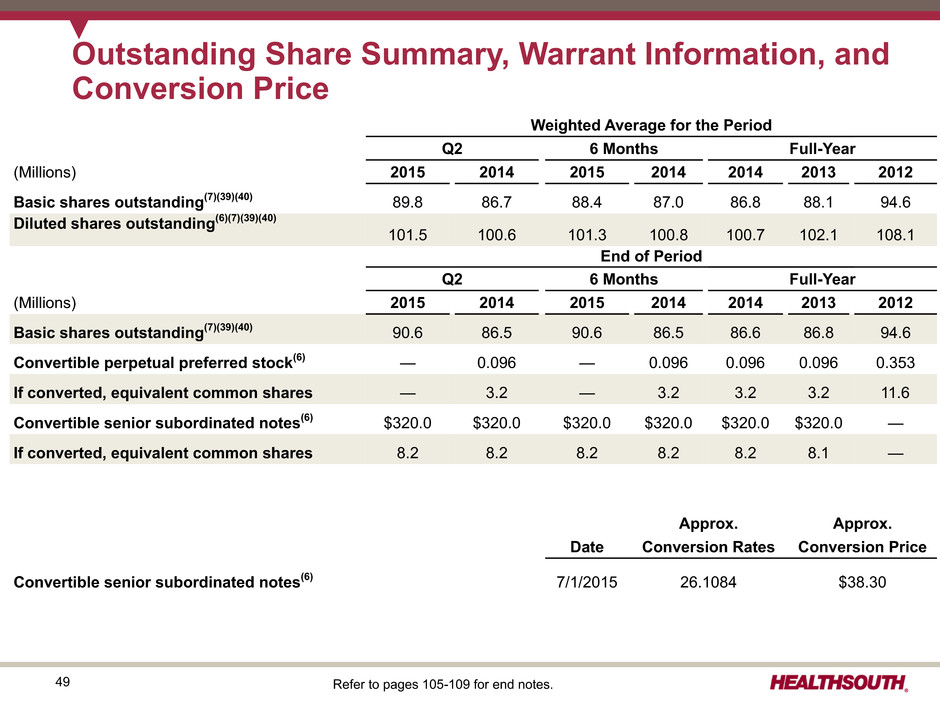
49 Outstanding Share Summary, Warrant Information, and Conversion Price Weighted Average for the Period Q2 6 Months Full-Year (Millions) 2015 2014 2015 2014 2014 2013 2012 Basic shares outstanding(7)(39)(40) 89.8 86.7 88.4 87.0 86.8 88.1 94.6 Diluted shares outstanding(6)(7)(39)(40) 101.5 100.6 101.3 100.8 100.7 102.1 108.1 End of Period Q2 6 Months Full-Year (Millions) 2015 2014 2015 2014 2014 2013 2012 Basic shares outstanding(7)(39)(40) 90.6 86.5 90.6 86.5 86.6 86.8 94.6 Convertible perpetual preferred stock(6) — 0.096 — 0.096 0.096 0.096 0.353 If converted, equivalent common shares — 3.2 — 3.2 3.2 3.2 11.6 Convertible senior subordinated notes(6) $320.0 $320.0 $320.0 $320.0 $320.0 $320.0 — If converted, equivalent common shares 8.2 8.2 8.2 8.2 8.2 8.1 — Approx. Approx. Date Conversion Rates Conversion Price Convertible senior subordinated notes(6) 7/1/2015 26.1084 $38.30 Refer to pages 105-109 for end notes.
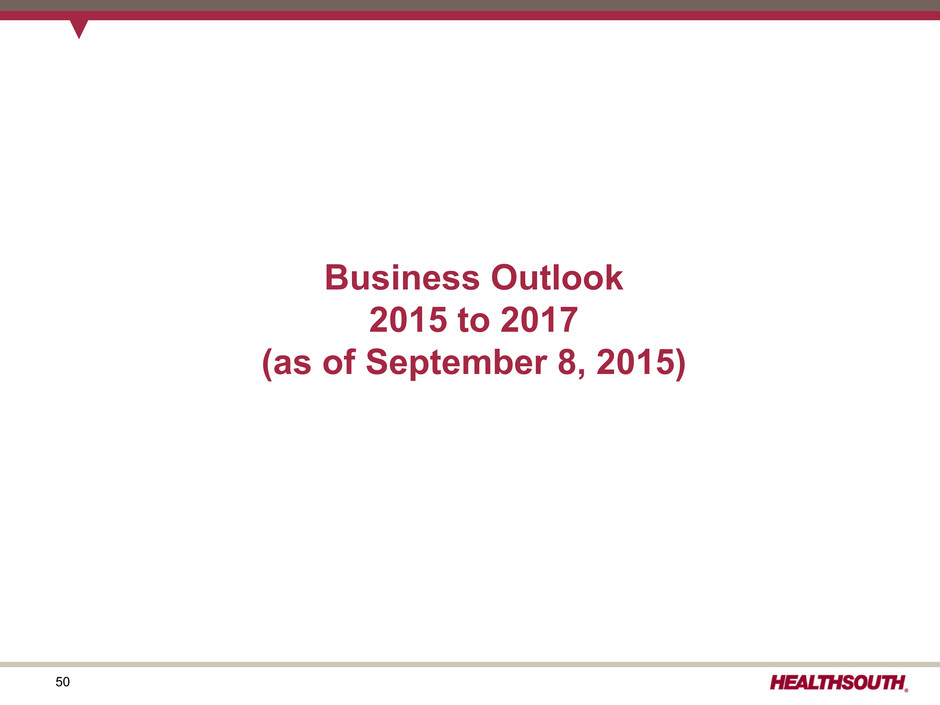
50 Business Outlook 2015 to 2017 (as of September 8, 2015)
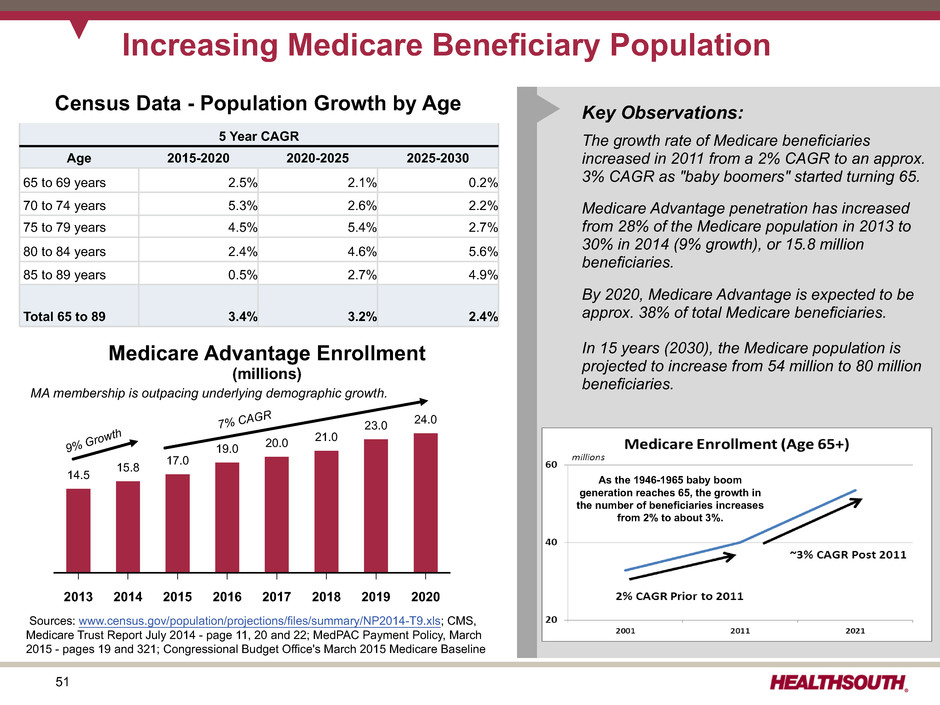
51 5 Year CAGR Age 2015-2020 2020-2025 2025-2030 65 to 69 years 2.5% 2.1% 0.2% 70 to 74 years 5.3% 2.6% 2.2% 75 to 79 years 4.5% 5.4% 2.7% 80 to 84 years 2.4% 4.6% 5.6% 85 to 89 years 0.5% 2.7% 4.9% Total 65 to 89 3.4% 3.2% 2.4% Key Observations: The growth rate of Medicare beneficiaries increased in 2011 from a 2% CAGR to an approx. 3% CAGR as "baby boomers" started turning 65. Medicare Advantage penetration has increased from 28% of the Medicare population in 2013 to 30% in 2014 (9% growth), or 15.8 million beneficiaries. By 2020, Medicare Advantage is expected to be approx. 38% of total Medicare beneficiaries. In 15 years (2030), the Medicare population is projected to increase from 54 million to 80 million beneficiaries. Increasing Medicare Beneficiary Population Medicare Advantage Enrollment (millions) Census Data - Population Growth by Age 2013 2014 2015 2016 2017 2018 2019 2020 14.5 15.8 17.0 19.0 20.0 21.0 23.0 24.0 MA membership is outpacing underlying demographic growth. 9% Growt h 7% CAG R Sources: www.census.gov/population/projections/files/summary/NP2014-T9.xls; CMS, Medicare Trust Report July 2014 - page 11, 20 and 22; MedPAC Payment Policy, March 2015 - pages 19 and 321; Congressional Budget Office's March 2015 Medicare Baseline As the 1946-1965 baby boom generation reaches 65, the growth in the number of beneficiaries increases from 2% to about 3%.

52 Present Future Current Trends Point to an Integrated Post-Acute Delivery Model Inpatient Rehabilitation Facilites Long-Term Acute Care Hospitals Home Health Skilled Nursing Facilities Hospice Value-Based Payments Collaborative Care Models Site-Neutral Payments Facility-Based Post Acute Services • Full range: low acuity->high acuity • 24/7 nursing coverage • Eliminates payment silos Home-Based Post-Acute Services • More care in the home (lowest cost setting) • Differentiator: Capable of caring for high-acuity, poly-chronic patients
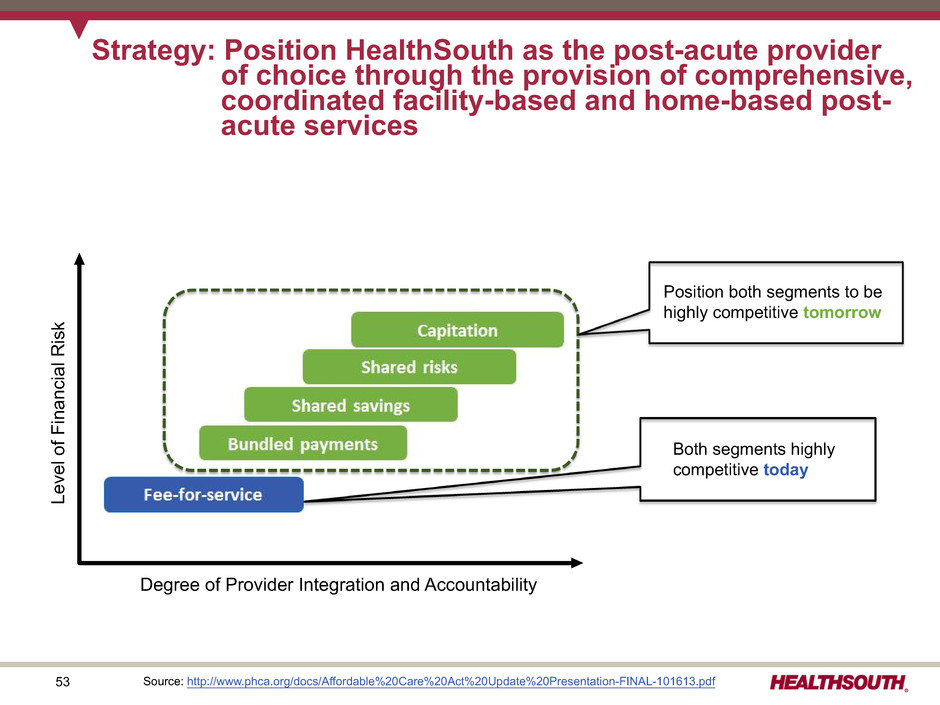
53 Strategy: Position HealthSouth as the post-acute provider of choice through the provision of comprehensive, coordinated facility-based and home-based post- acute services Source: http://www.phca.org/docs/Affordable%20Care%20Act%20Update%20Presentation-FINAL-101613.pdf Degree of Provider Integration and Accountability Level of Financial Ris k Both segments highly competitive today Position both segments to be highly competitive tomorrow
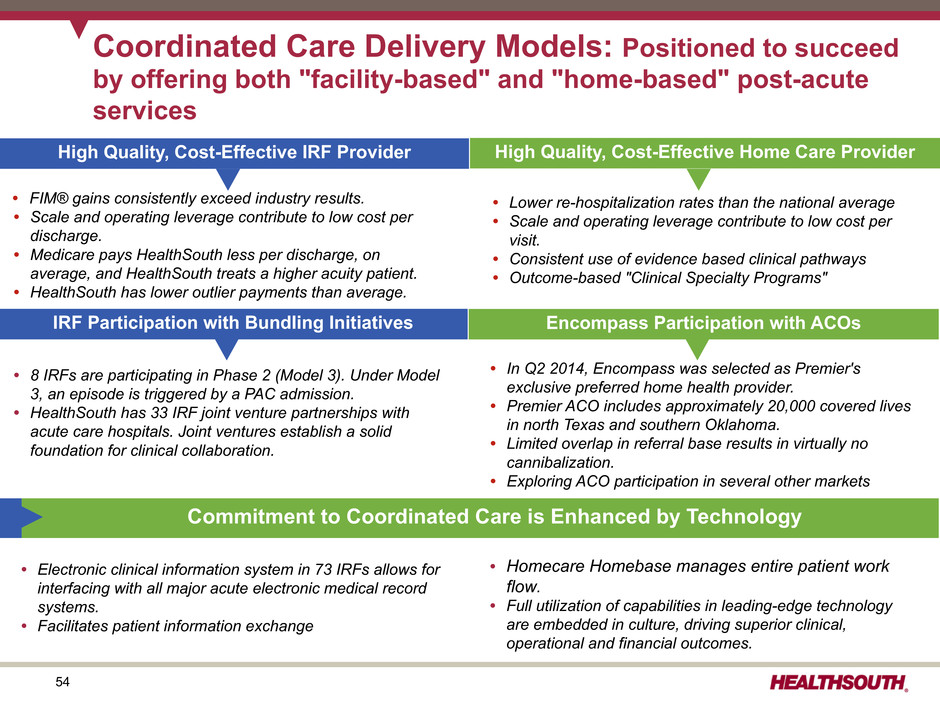
54 • Homecare Homebase manages entire patient work flow. • Full utilization of capabilities in leading-edge technology are embedded in culture, driving superior clinical, operational and financial outcomes. • Electronic clinical information system in 73 IRFs allows for interfacing with all major acute electronic medical record systems. • Facilitates patient information exchange Coordinated Care Delivery Models: Positioned to succeed by offering both "facility-based" and "home-based" post-acute services • Lower re-hospitalization rates than the national average • Scale and operating leverage contribute to low cost per visit. • Consistent use of evidence based clinical pathways • Outcome-based "Clinical Specialty Programs" • FIM® gains consistently exceed industry results. • Scale and operating leverage contribute to low cost per discharge. • Medicare pays HealthSouth less per discharge, on average, and HealthSouth treats a higher acuity patient. • HealthSouth has lower outlier payments than average. • 8 IRFs are participating in Phase 2 (Model 3). Under Model 3, an episode is triggered by a PAC admission. • HealthSouth has 33 IRF joint venture partnerships with acute care hospitals. Joint ventures establish a solid foundation for clinical collaboration. • In Q2 2014, Encompass was selected as Premier's exclusive preferred home health provider. • Premier ACO includes approximately 20,000 covered lives in north Texas and southern Oklahoma. • Limited overlap in referral base results in virtually no cannibalization. • Exploring ACO participation in several other markets Commitment to Coordinated Care is Enhanced by Technology High Quality, Cost-Effective IRF Provider High Quality, Cost-Effective Home Care Provider IRF Participation with Bundling Initiatives Encompass Participation with ACOs
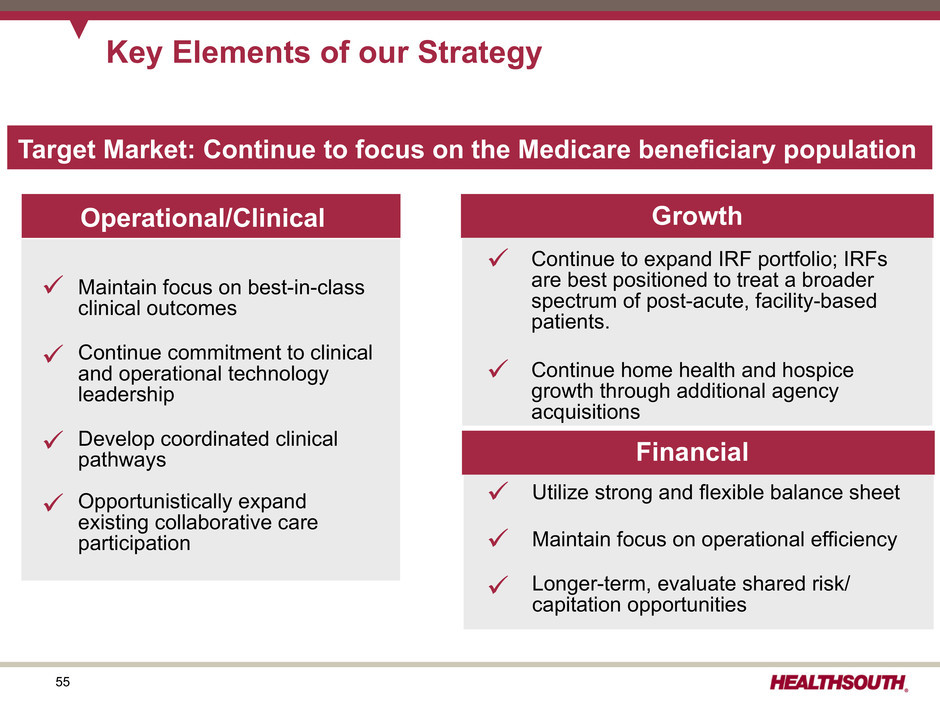
55 Key Elements of our Strategy Target Market: Continue to focus on the Medicare beneficiary population Operational/Clinical Growth Financial ü Maintain focus on best-in-class clinical outcomes ü Continue commitment to clinicaland operational technology leadership ü Develop coordinated clinicalpathways ü Opportunistically expandexisting collaborative care participation ü Continue to expand IRF portfolio; IRFs are best positioned to treat a broader spectrum of post-acute, facility-based patients. ü Continue home health and hospice growth through additional agency acquisitions ü Utilize strong and flexible balance sheet ü Maintain focus on operational efficiency ü Longer-term, evaluate shared risk/capitation opportunities
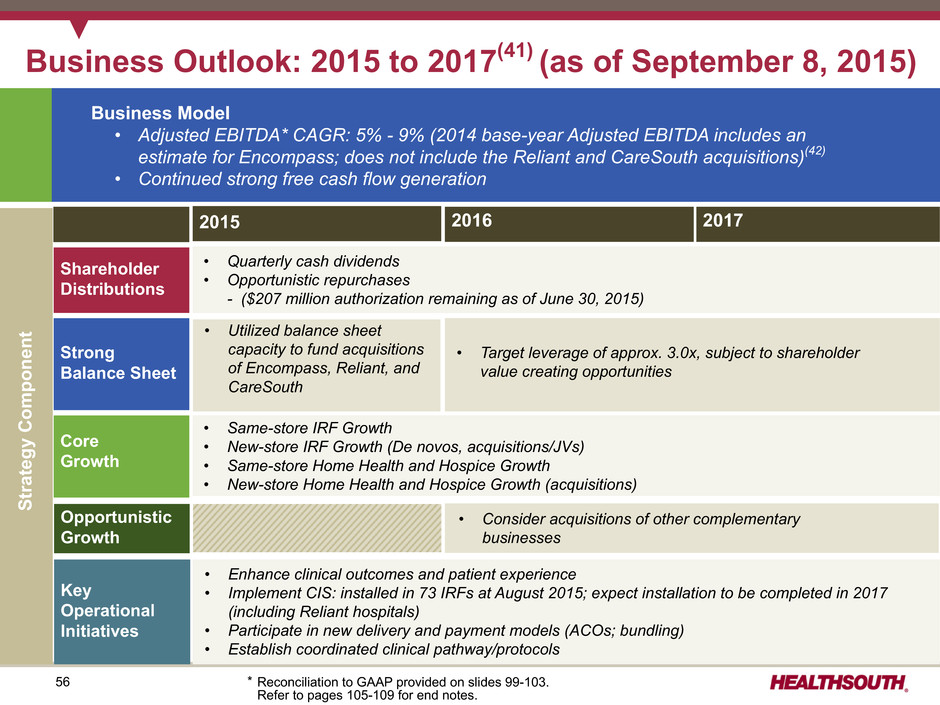
56 • Same-store IRF Growth • New-store IRF Growth (De novos, acquisitions/JVs) • Same-store Home Health and Hospice Growth • New-store Home Health and Hospice Growth (acquisitions) Core Growth Strong Balance Sheet Key Operational Initiatives Shareholder Distributions Opportunistic Growth Business Outlook: 2015 to 2017(41) (as of September 8, 2015) 2015 2016 2017 Business Model • Adjusted EBITDA* CAGR: 5% - 9% (2014 base-year Adjusted EBITDA includes an estimate for Encompass; does not include the Reliant and CareSouth acquisitions)(42) • Continued strong free cash flow generation • Quarterly cash dividends • Opportunistic repurchases - ($207 million authorization remaining as of June 30, 2015) • Consider acquisitions of other complementary businesses • Enhance clinical outcomes and patient experience • Implement CIS: installed in 73 IRFs at August 2015; expect installation to be completed in 2017 (including Reliant hospitals) • Participate in new delivery and payment models (ACOs; bundling) • Establish coordinated clinical pathway/protocols • Target leverage of approx. 3.0x, subject to shareholder value creating opportunities Strategy Componen t * Reconciliation to GAAP provided on slides 99-103. Refer to pages 105-109 for end notes. • Utilized balance sheet capacity to fund acquisitions of Encompass, Reliant, and CareSouth
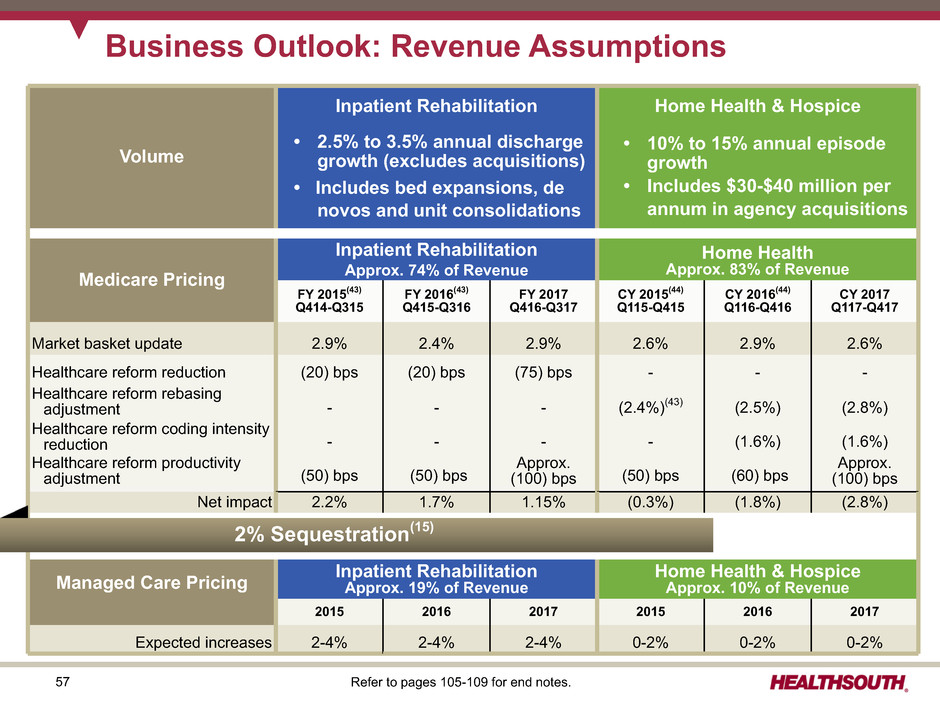
57 • 10% to15% annual episode growth • Includes $35-$40 million per annum in agency acquisitions Volume Inpatient Rehabilitation Home Health & Hospice Medicare Pricing Inpatient Rehabilitation Approx. 74% of Revenue Home Health Approx. 83% of Revenue FY 2015(43) Q414-Q315 FY 2016(43) Q415-Q316 FY 2017 Q416-Q317 CY 2015(44) Q115-Q415 CY 2016(44) Q116-Q416 CY 2017 Q117-Q417 Market basket update 2.9% 2.4% 2.9% 2.6% 2.9% 2.6% Healthcare reform reduction (20) bps (20) bps (75) bps - - - Healthcare reform rebasing adjustment - - - (2.4%)(43) (2.5%) (2.8%) Healthcare reform coding intensity reduction - - - - (1.6%) (1.6%) Healthcare reform productivity adjustment (50) bps (50) bps Approx. (100) bps (50) bps (60) bps Approx. (100) bps Net impact 2.2% 1.7% 1.15% (0.3%) (1.8%) (2.8%) Managed Care Pricing Inpatient Rehabilitation Approx. 19% of Revenue Home Health & Hospice Approx. 10% of Revenue 2015 2016 2017 2015 2016 2017 Expected increases 2-4% 2-4% 2-4% 0-2% 0-2% 0-2% Business Outlook: Revenue Assumptions 2% Sequestration(15) • 2.5% to 3.5% annual discharge growth (excludes acquisitions) • Includes bed expansions, de novos and unit consolidations • 10% to 15% annual episode growth • Includes $30-$40 million per annum in agency acquisitions Refer to pages 105-109 for end notes.
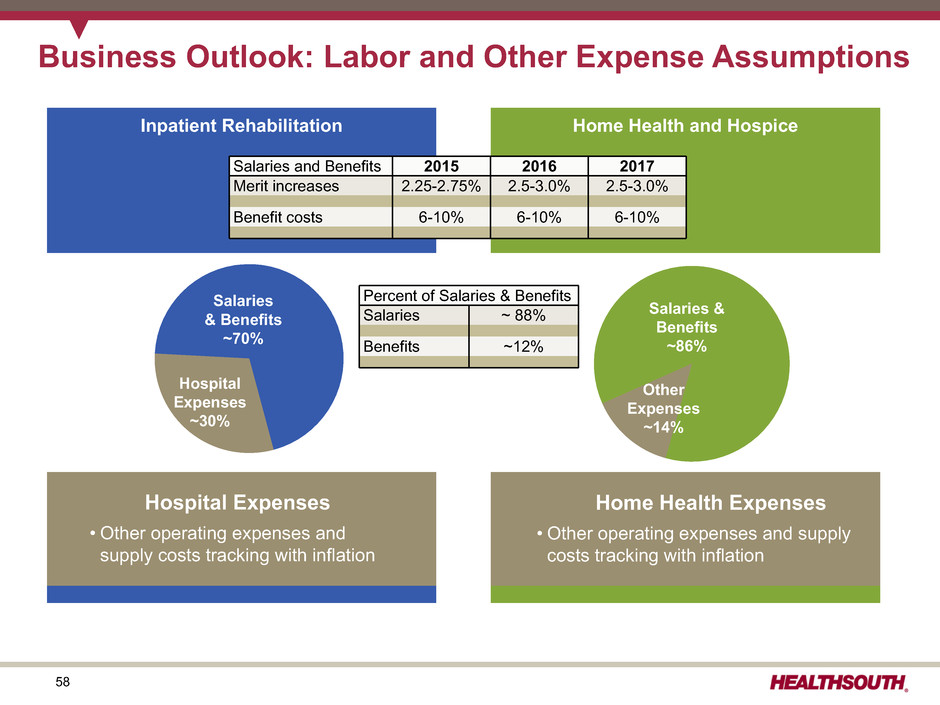
58 Inpatient Rehabilitation Home Health and Hospice Business Outlook: Labor and Other Expense Assumptions Salaries & Benefits ~70% Hospital Expenses ~30% Salaries and Benefits 2015 2016 2017 Merit increases 2.25-2.75% 2.5-3.0% 2.5-3.0% Benefit costs 6-10% 6-10% 6-10% Hospital Expenses • Other operating expenses and supply costs tracking with inflation Salaries & Benefits ~86% Other Expenses ~14% Home Health Expenses • Other operating expenses and supply costs tracking with inflation Percent of Salaries & Benefits Salaries ~ 88% Benefits ~12%
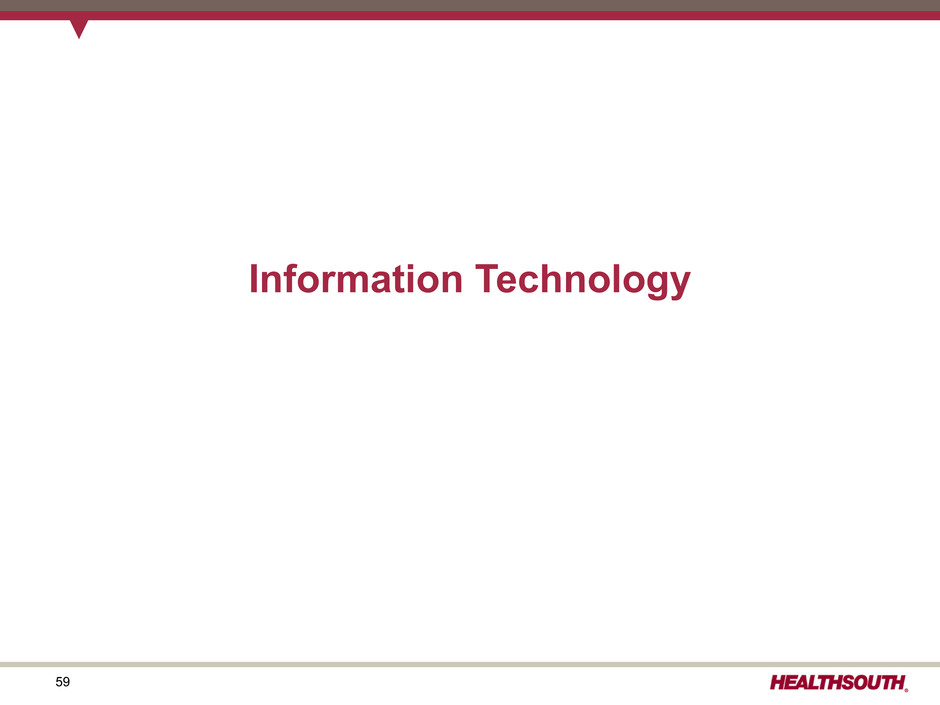
59 Information Technology
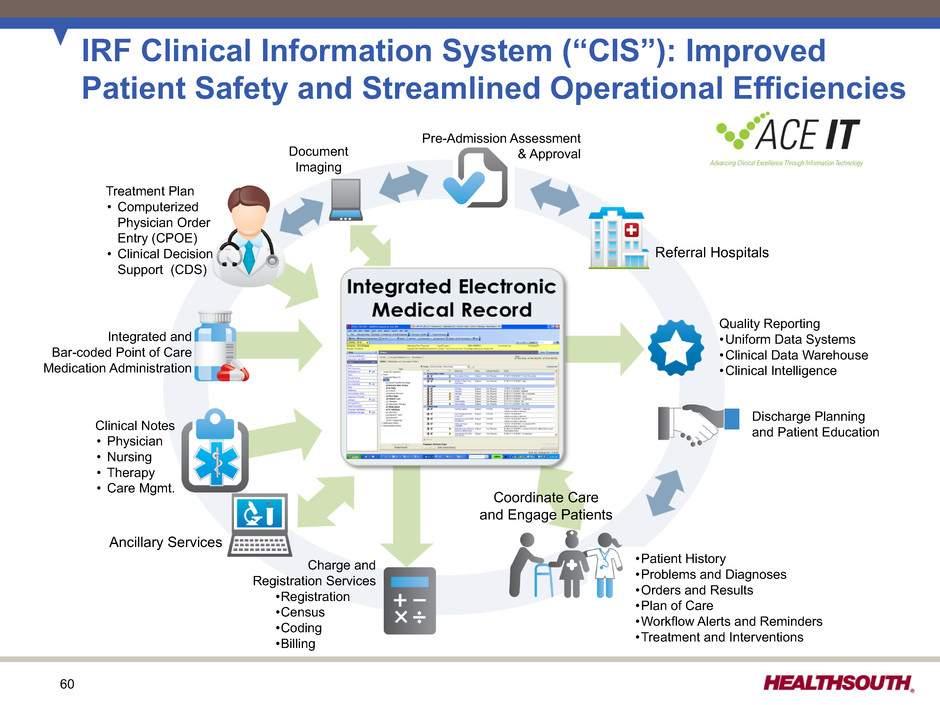
60 IRF Clinical Information System (“CIS”): Improved Patient Safety and Streamlined Operational Efficiencies Pre-Admission Assessment & Approval Discharge Planning and Patient Education •Patient History •Problems and Diagnoses •Orders and Results •Plan of Care •Workflow Alerts and Reminders •Treatment and Interventions Document Imaging Charge and Registration Services •Registration •Census •Coding •Billing Quality Reporting •Uniform Data Systems •Clinical Data Warehouse •Clinical Intelligence Referral Hospitals Ancillary Services Clinical Notes • Physician • Nursing • Therapy • Care Mgmt. Integrated and Bar-coded Point of Care Medication Administration Treatment Plan • Computerized Physician Order Entry (CPOE) • Clinical Decision Support (CDS) Coordinate Care and Engage Patients
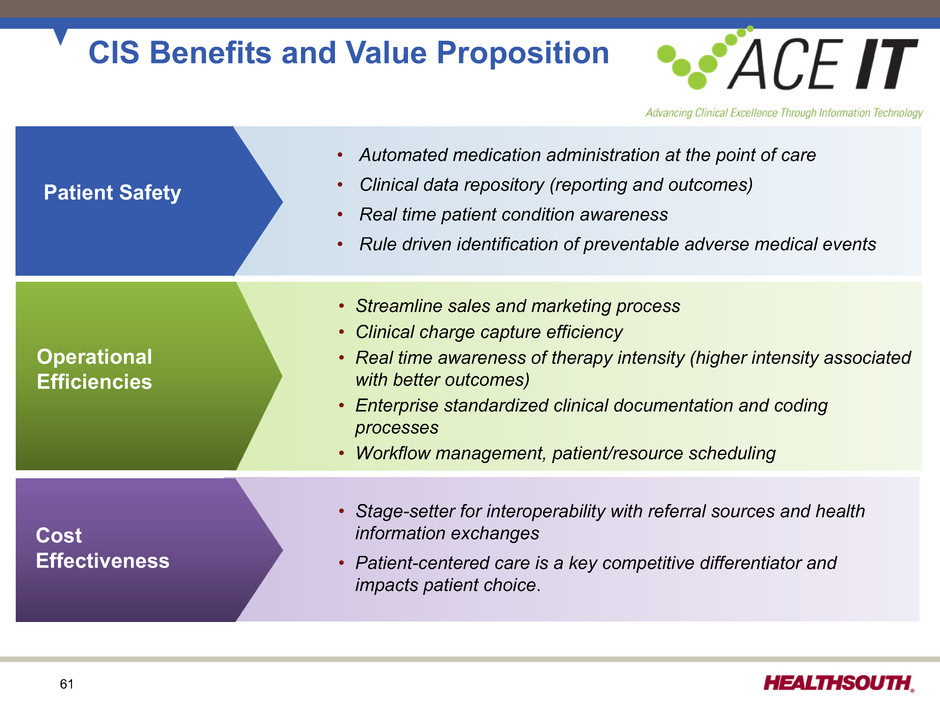
61 CIS Benefits and Value Proposition Operational Efficiencies Cost Effectiveness • Automated medication administration at the point of care • Clinical data repository (reporting and outcomes) • Real time patient condition awareness • Rule driven identification of preventable adverse medical events • Streamline sales and marketing process • Clinical charge capture efficiency • Real time awareness of therapy intensity (higher intensity associated with better outcomes) • Enterprise standardized clinical documentation and coding processes • Workflow management, patient/resource scheduling • Stage-setter for interoperability with referral sources and health information exchanges • Patient-centered care is a key competitive differentiator and impacts patient choice. Patient Safety
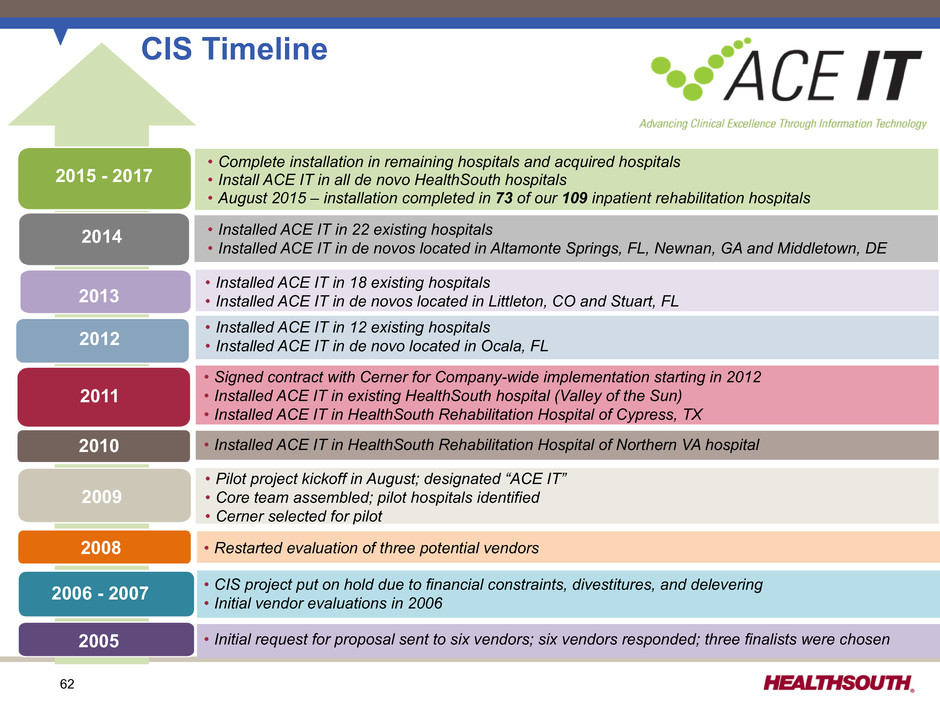
62 • Installed ACE IT in HealthSouth Rehabilitation Hospital of Northern VA hospital • Pilot project kickoff in August; designated “ACE IT” • Core team assembled; pilot hospitals identified • Cerner selected for pilot • Signed contract with Cerner for Company-wide implementation starting in 2012 • Installed ACE IT in existing HealthSouth hospital (Valley of the Sun) • Installed ACE IT in HealthSouth Rehabilitation Hospital of Cypress, TX • Installed ACE IT in 12 existing hospitals • Installed ACE IT in de novo located in Ocala, FL • Complete installation in remaining hospitals and acquired hospitals • Install ACE IT in all de novo HealthSouth hospitals • August 2015 – installation completed in 73 of our 109 inpatient rehabilitation hospitals CIS Timeline • Restarted evaluation of three potential vendors • CIS project put on hold due to financial constraints, divestitures, and delevering • Initial vendor evaluations in 2006 • Initial request for proposal sent to six vendors; six vendors responded; three finalists were chosen • Installed ACE IT in 18 existing hospitals • Installed ACE IT in de novos located in Littleton, CO and Stuart, FL 2015 - 2017 2013 2012 2011 2010 2009 2008 2006 - 2007 2005 2014 • Installed ACE IT in 22 existing hospitals• Installed ACE IT in de novos located in Altamonte Springs, FL, Newnan, GA and Middletown, DE
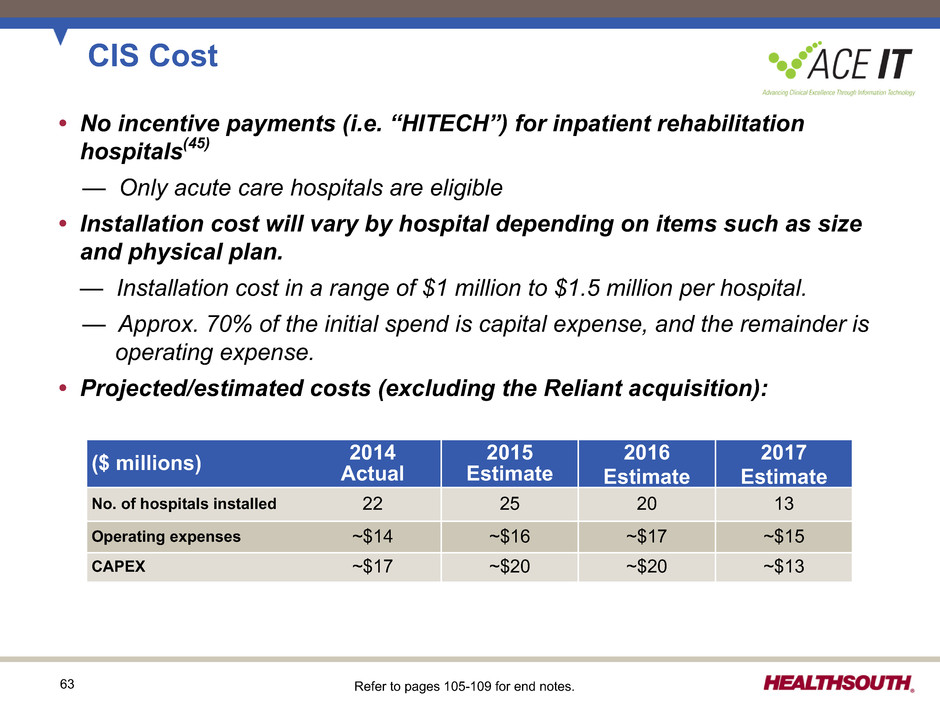
63 CIS Cost • No incentive payments (i.e. “HITECH”) for inpatient rehabilitation hospitals(45) — Only acute care hospitals are eligible • Installation cost will vary by hospital depending on items such as size and physical plan. — Installation cost in a range of $1 million to $1.5 million per hospital. — Approx. 70% of the initial spend is capital expense, and the remainder is operating expense. • Projected/estimated costs (excluding the Reliant acquisition): ($ millions) 2014Actual 2015 Estimate 2016 Estimate 2017 Estimate No. of hospitals installed 22 25 20 13 Operating expenses ~$14 ~$16 ~$17 ~$15 CAPEX ~$17 ~$20 ~$20 ~$13 Refer to pages 105-109 for end notes.
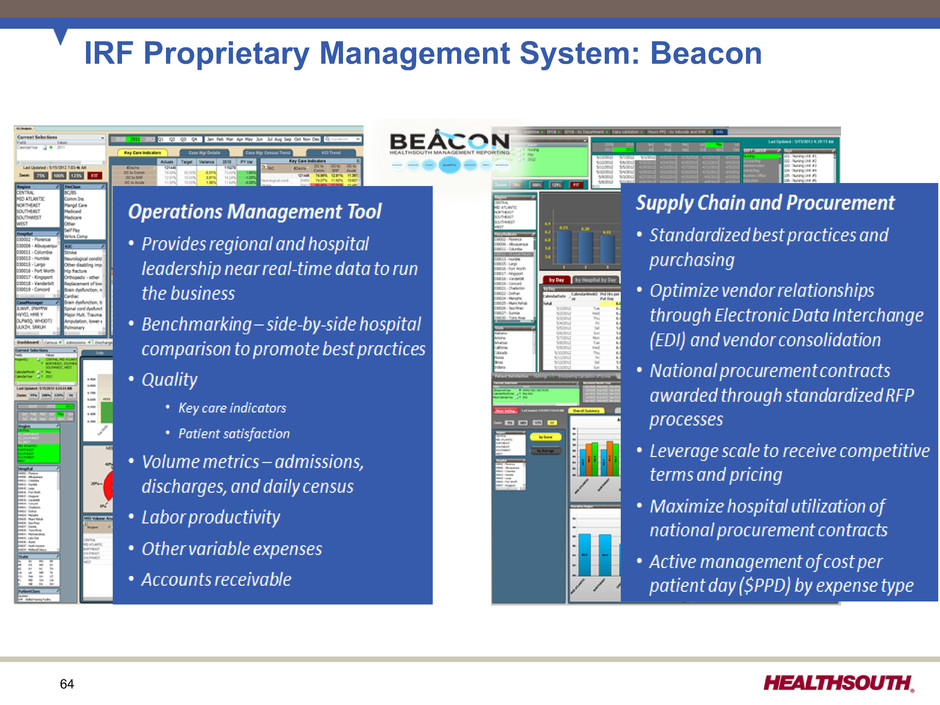
64 IRF Proprietary Management System: Beacon
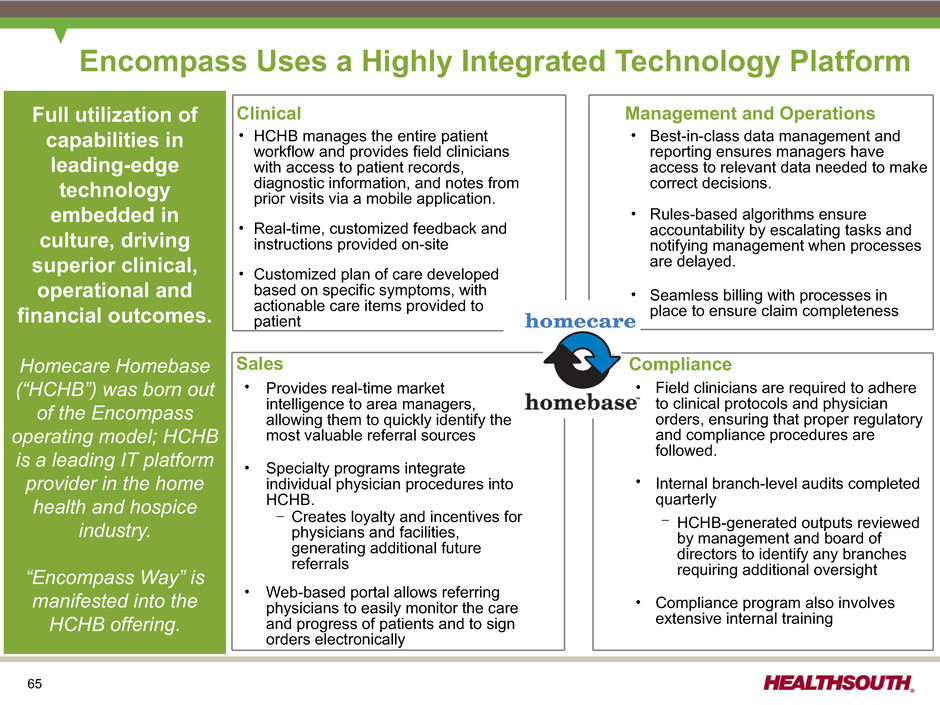
65 Encompass Uses a Highly Integrated Technology Platform Clinical Ÿ HCHB manages the entire patient workflow and provides field clinicians with access to patient records, diagnostic information, and notes from prior visits via a mobile application. Ÿ Real-time, customized feedback and instructions provided on-site Ÿ Customized plan of care developed based on specific symptoms, with actionable care items provided to patient Sales Ÿ Provides real-time market intelligence to area managers, allowing them to quickly identify the most valuable referral sources Ÿ Specialty programs integrate individual physician procedures into HCHB. – Creates loyalty and incentives for physicians and facilities, generating additional future referrals Ÿ Web-based portal allows referring physicians to easily monitor the care and progress of patients and to sign orders electronically Compliance Ÿ Field clinicians are required to adhere to clinical protocols and physician orders, ensuring that proper regulatory and compliance procedures are followed. Ÿ Internal branch-level audits completed quarterly – HCHB-generated outputs reviewed by management and board of directors to identify any branches requiring additional oversight Ÿ Compliance program also involves extensive internal training Management and Operations Ÿ Best-in-class data management and reporting ensures managers have access to relevant data needed to make correct decisions. Ÿ Rules-based algorithms ensure accountability by escalating tasks and notifying management when processes are delayed. Ÿ Seamless billing with processes in place to ensure claim completeness Full utilization of capabilities in leading-edge technology embedded in culture, driving superior clinical, operational and financial outcomes. Homecare Homebase (“HCHB”) was born out of the Encompass operating model; HCHB is a leading IT platform provider in the home health and hospice industry. “Encompass Way” is manifested into the HCHB offering.
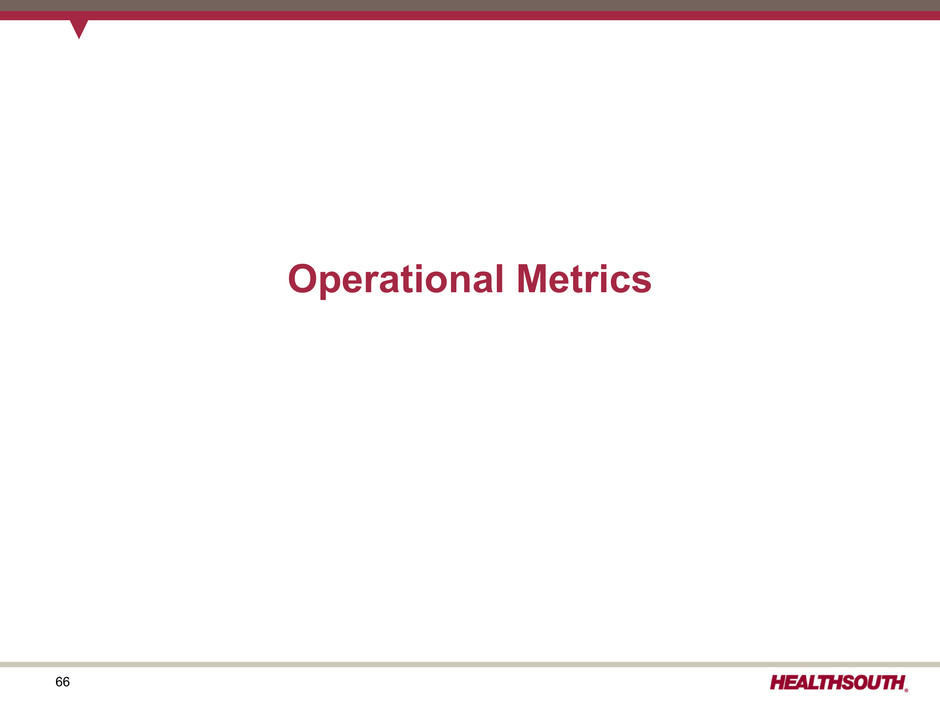
66 Operational Metrics
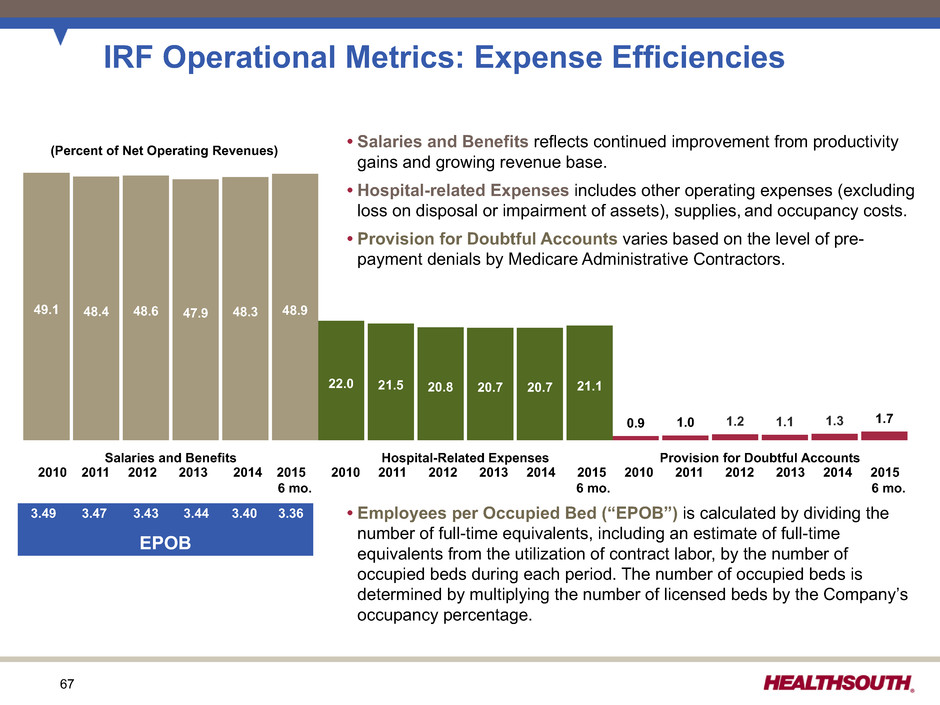
67 Salaries and Benefits Hospital-Related Expenses Provision for Doubtful Accounts 49.1 22.0 0.9 48.4 21.5 1.0 48.6 20.8 1.2 47.9 20.7 1.1 48.3 20.7 1.3 48.9 21.1 1.7 • Salaries and Benefits reflects continued improvement from productivity gains and growing revenue base. • Hospital-related Expenses includes other operating expenses (excluding loss on disposal or impairment of assets), supplies, and occupancy costs. • Provision for Doubtful Accounts varies based on the level of pre- payment denials by Medicare Administrative Contractors. • Employees per Occupied Bed (“EPOB”) is calculated by dividing the number of full-time equivalents, including an estimate of full-time equivalents from the utilization of contract labor, by the number of occupied beds during each period. The number of occupied beds is determined by multiplying the number of licensed beds by the Company’s occupancy percentage. IRF Operational Metrics: Expense Efficiencies 2010 2011 2012 2013 2014 2015 2010 2011 2012 2013 2014 2015 2010 2011 2012 2013 2014 2015 6 mo. 6 mo. 6 mo. 3.49 3.47 3.43 3.44 3.40 3.36 EPOB (Percent of Net Operating Revenues)
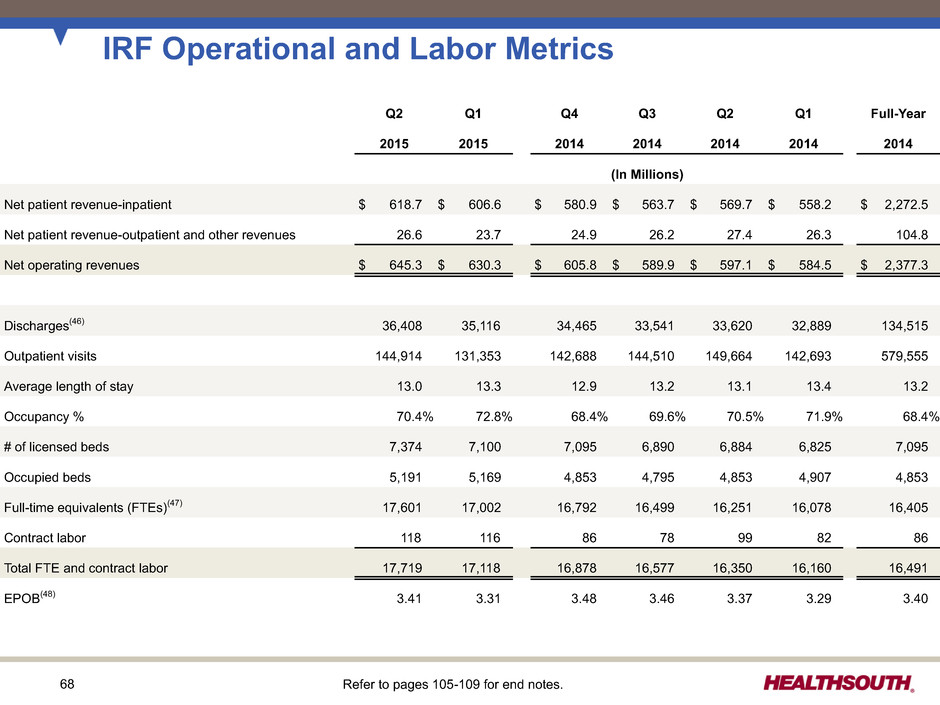
68 IRF Operational and Labor Metrics Refer to pages 105-109 for end notes. Q2 Q1 Q4 Q3 Q2 Q1 Full-Year 2015 2015 2014 2014 2014 2014 2014 (In Millions) Net patient revenue-inpatient $ 618.7 $ 606.6 $ 580.9 $ 563.7 $ 569.7 $ 558.2 $ 2,272.5 Net patient revenue-outpatient and other revenues 26.6 23.7 24.9 26.2 27.4 26.3 104.8 Net operating revenues $ 645.3 $ 630.3 $ 605.8 $ 589.9 $ 597.1 $ 584.5 $ 2,377.3 Discharges(46) 36,408 35,116 34,465 33,541 33,620 32,889 134,515 Outpatient visits 144,914 131,353 142,688 144,510 149,664 142,693 579,555 Average length of stay 13.0 13.3 12.9 13.2 13.1 13.4 13.2 Occupancy % 70.4% 72.8% 68.4% 69.6% 70.5% 71.9% 68.4% # of licensed beds 7,374 7,100 7,095 6,890 6,884 6,825 7,095 Occupied beds 5,191 5,169 4,853 4,795 4,853 4,907 4,853 Full-time equivalents (FTEs)(47) 17,601 17,002 16,792 16,499 16,251 16,078 16,405 Contract labor 118 116 86 78 99 82 86 Total FTE and contract labor 17,719 17,118 16,878 16,577 16,350 16,160 16,491 EPOB(48) 3.41 3.31 3.48 3.46 3.37 3.29 3.40
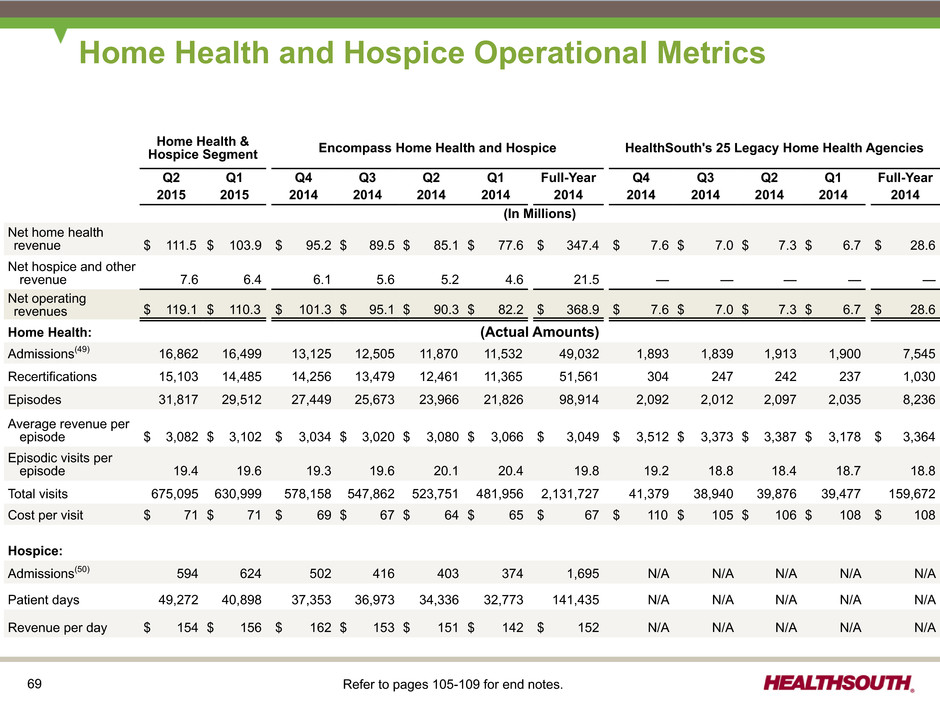
69 Home Health & Hospice Segment Encompass Home Health and Hospice HealthSouth's 25 Legacy Home Health Agencies Q2 Q1 Q4 Q3 Q2 Q1 Full-Year Q4 Q3 Q2 Q1 Full-Year 2015 2015 2014 2014 2014 2014 2014 2014 2014 2014 2014 2014 (In Millions) Net home health revenue $ 111.5 $ 103.9 $ 95.2 $ 89.5 $ 85.1 $ 77.6 $ 347.4 $ 7.6 $ 7.0 $ 7.3 $ 6.7 $ 28.6 Net hospice and other revenue 7.6 6.4 6.1 5.6 5.2 4.6 21.5 — — — — — Net operating revenues $ 119.1 $ 110.3 $ 101.3 $ 95.1 $ 90.3 $ 82.2 $ 368.9 $ 7.6 $ 7.0 $ 7.3 $ 6.7 $ 28.6 Home Health: (Actual Amounts) Admissions(49) 16,862 16,499 13,125 12,505 11,870 11,532 49,032 1,893 1,839 1,913 1,900 7,545 Recertifications 15,103 14,485 14,256 13,479 12,461 11,365 51,561 304 247 242 237 1,030 Episodes 31,817 29,512 27,449 25,673 23,966 21,826 98,914 2,092 2,012 2,097 2,035 8,236 Average revenue per episode $ 3,082 $ 3,102 $ 3,034 $ 3,020 $ 3,080 $ 3,066 $ 3,049 $ 3,512 $ 3,373 $ 3,387 $ 3,178 $ 3,364 Episodic visits per episode 19.4 19.6 19.3 19.6 20.1 20.4 19.8 19.2 18.8 18.4 18.7 18.8 Total visits 675,095 630,999 578,158 547,862 523,751 481,956 2,131,727 41,379 38,940 39,876 39,477 159,672 Cost per visit $ 71 $ 71 $ 69 $ 67 $ 64 $ 65 $ 67 $ 110 $ 105 $ 106 $ 108 $ 108 Hospice: Admissions(50) 594 624 502 416 403 374 1,695 N/A N/A N/A N/A N/A Patient days 49,272 40,898 37,353 36,973 34,336 32,773 141,435 N/A N/A N/A N/A N/A Revenue per day $ 154 $ 156 $ 162 $ 153 $ 151 $ 142 $ 152 N/A N/A N/A N/A N/A Home Health and Hospice Operational Metrics Refer to pages 105-109 for end notes.
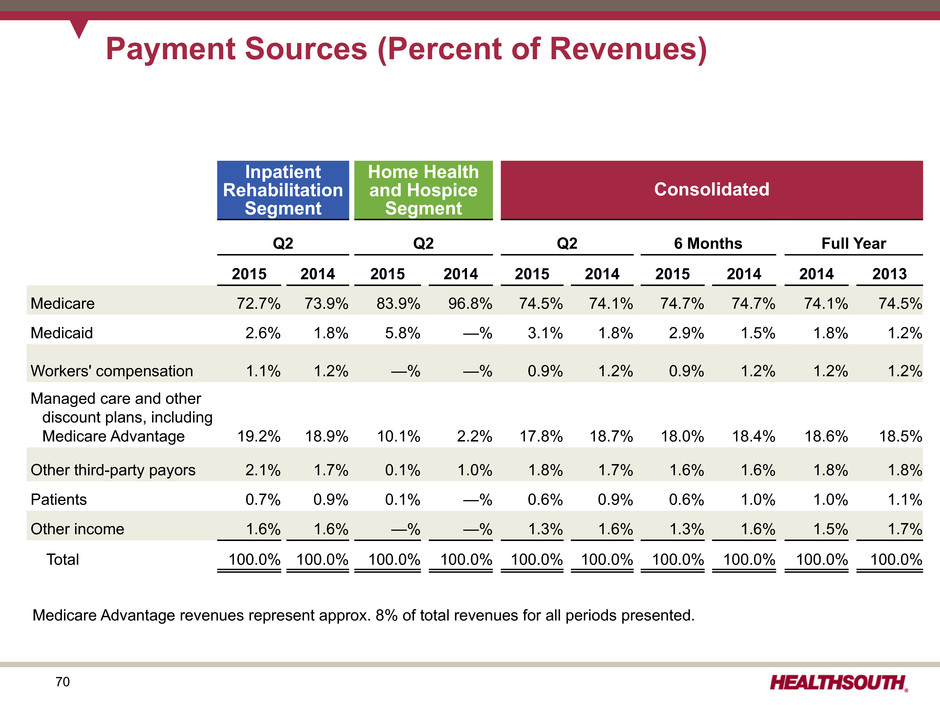
70 Payment Sources (Percent of Revenues) Inpatient Rehabilitation Segment Home Health and Hospice Segment Consolidated Q2 Q2 Q2 6 Months Full Year 2015 2014 2015 2014 2015 2014 2015 2014 2014 2013 Medicare 72.7% 73.9% 83.9% 96.8% 74.5% 74.1% 74.7% 74.7% 74.1% 74.5% Medicaid 2.6% 1.8% 5.8% —% 3.1% 1.8% 2.9% 1.5% 1.8% 1.2% Workers' compensation 1.1% 1.2% —% —% 0.9% 1.2% 0.9% 1.2% 1.2% 1.2% Managed care and other discount plans, including Medicare Advantage 19.2% 18.9% 10.1% 2.2% 17.8% 18.7% 18.0% 18.4% 18.6% 18.5% Other third-party payors 2.1% 1.7% 0.1% 1.0% 1.8% 1.7% 1.6% 1.6% 1.8% 1.8% Patients 0.7% 0.9% 0.1% —% 0.6% 0.9% 0.6% 1.0% 1.0% 1.1% Other income 1.6% 1.6% —% —% 1.3% 1.6% 1.3% 1.6% 1.5% 1.7% Total 100.0% 100.0% 100.0% 100.0% 100.0% 100.0% 100.0% 100.0% 100.0% 100.0% Medicare Advantage revenues represent approx. 8% of total revenues for all periods presented.
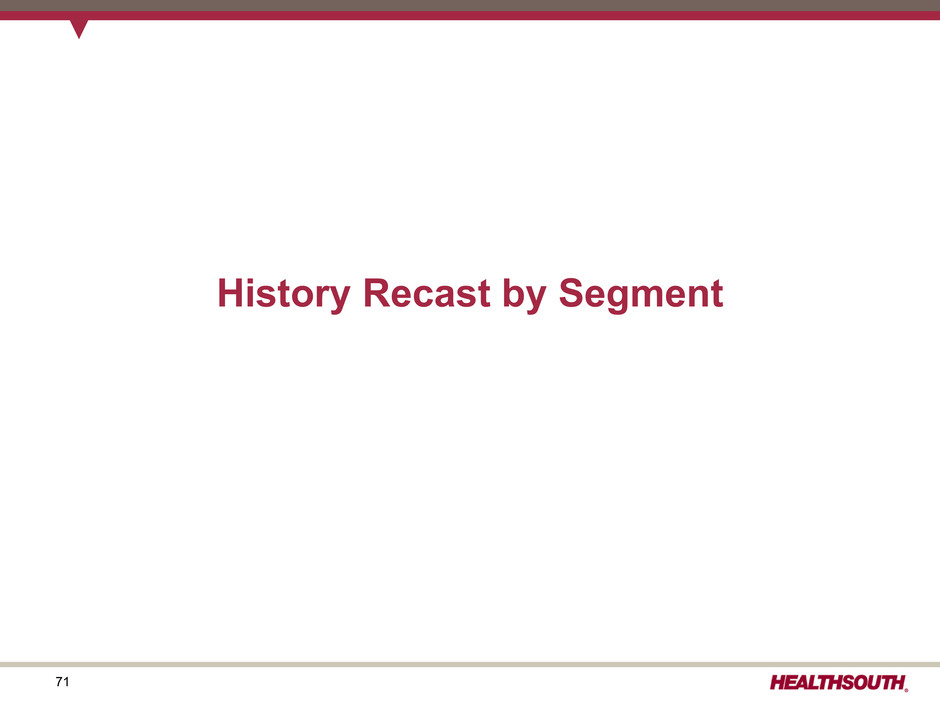
71 History Recast by Segment
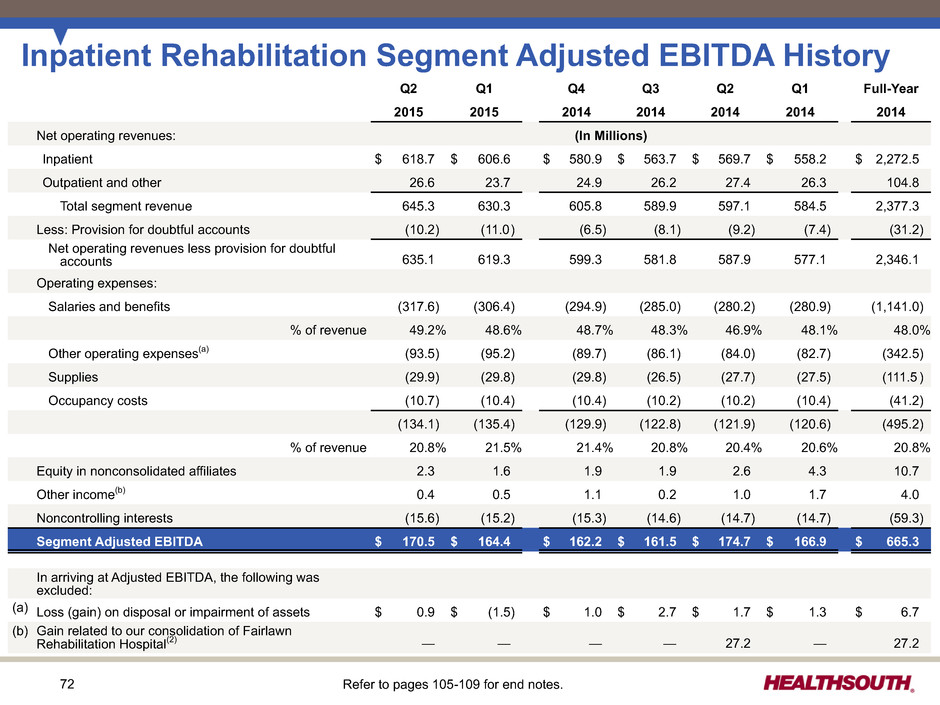
72 Inpatient Rehabilitation Segment Adjusted EBITDA History Q2 Q1 Q4 Q3 Q2 Q1 Full-Year 2015 2015 2014 2014 2014 2014 2014 Net operating revenues: (In Millions) Inpatient $ 618.7 $ 606.6 $ 580.9 $ 563.7 $ 569.7 $ 558.2 $ 2,272.5 Outpatient and other 26.6 23.7 24.9 26.2 27.4 26.3 104.8 Total segment revenue 645.3 630.3 605.8 589.9 597.1 584.5 2,377.3 Less: Provision for doubtful accounts (10.2) (11.0) (6.5) (8.1) (9.2) (7.4) (31.2) Net operating revenues less provision for doubtful accounts 635.1 619.3 599.3 581.8 587.9 577.1 2,346.1 Operating expenses: Salaries and benefits (317.6) (306.4) (294.9) (285.0) (280.2) (280.9) (1,141.0) % of revenue 49.2% 48.6% 48.7% 48.3% 46.9% 48.1% 48.0% Other operating expenses(a) (93.5) (95.2) (89.7) (86.1) (84.0) (82.7) (342.5) Supplies (29.9) (29.8) (29.8) (26.5) (27.7) (27.5) (111.5 ) Occupancy costs (10.7) (10.4) (10.4) (10.2) (10.2) (10.4) (41.2) (134.1) (135.4) (129.9) (122.8) (121.9) (120.6) (495.2) % of revenue 20.8% 21.5% 21.4% 20.8% 20.4% 20.6% 20.8% Equity in nonconsolidated affiliates 2.3 1.6 1.9 1.9 2.6 4.3 10.7 Other income(b) 0.4 0.5 1.1 0.2 1.0 1.7 4.0 Noncontrolling interests (15.6) (15.2) (15.3) (14.6) (14.7) (14.7) (59.3) Segment Adjusted EBITDA $ 170.5 $ 164.4 $ 162.2 $ 161.5 $ 174.7 $ 166.9 $ 665.3 In arriving at Adjusted EBITDA, the following was excluded: (a) Loss (gain) on disposal or impairment of assets $ 0.9 $ (1.5) $ 1.0 $ 2.7 $ 1.7 $ 1.3 $ 6.7 (b) Gain related to our consolidation of Fairlawn Rehabilitation Hospital(2) — — — — 27.2 — 27.2 Refer to pages 105-109 for end notes.
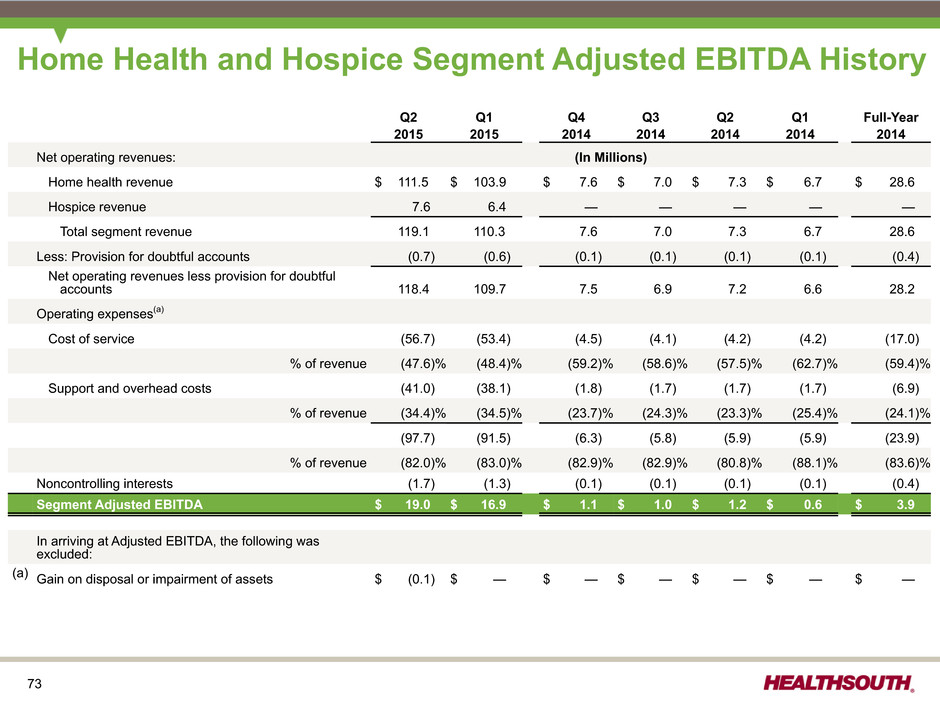
73 Home Health and Hospice Segment Adjusted EBITDA History Q2 Q1 Q4 Q3 Q2 Q1 Full-Year 2015 2015 2014 2014 2014 2014 2014 Net operating revenues: (In Millions) Home health revenue $ 111.5 $ 103.9 $ 7.6 $ 7.0 $ 7.3 $ 6.7 $ 28.6 Hospice revenue 7.6 6.4 — — — — — Total segment revenue 119.1 110.3 7.6 7.0 7.3 6.7 28.6 Less: Provision for doubtful accounts (0.7) (0.6) (0.1) (0.1) (0.1) (0.1) (0.4) Net operating revenues less provision for doubtful accounts 118.4 109.7 7.5 6.9 7.2 6.6 28.2 Operating expenses(a) Cost of service (56.7) (53.4) (4.5) (4.1) (4.2) (4.2) (17.0) % of revenue (47.6)% (48.4)% (59.2)% (58.6)% (57.5)% (62.7)% (59.4)% Support and overhead costs (41.0) (38.1) (1.8) (1.7) (1.7) (1.7) (6.9) % of revenue (34.4)% (34.5)% (23.7)% (24.3)% (23.3)% (25.4)% (24.1)% (97.7) (91.5) (6.3) (5.8) (5.9) (5.9) (23.9) % of revenue (82.0)% (83.0)% (82.9)% (82.9)% (80.8)% (88.1)% (83.6)% Noncontrolling interests (1.7) (1.3) (0.1) (0.1) (0.1) (0.1) (0.4) Segment Adjusted EBITDA $ 19.0 $ 16.9 $ 1.1 $ 1.0 $ 1.2 $ 0.6 $ 3.9 In arriving at Adjusted EBITDA, the following was excluded: (a) Gain on disposal or impairment of assets $ (0.1) $ — $ — $ — $ — $ — $ —
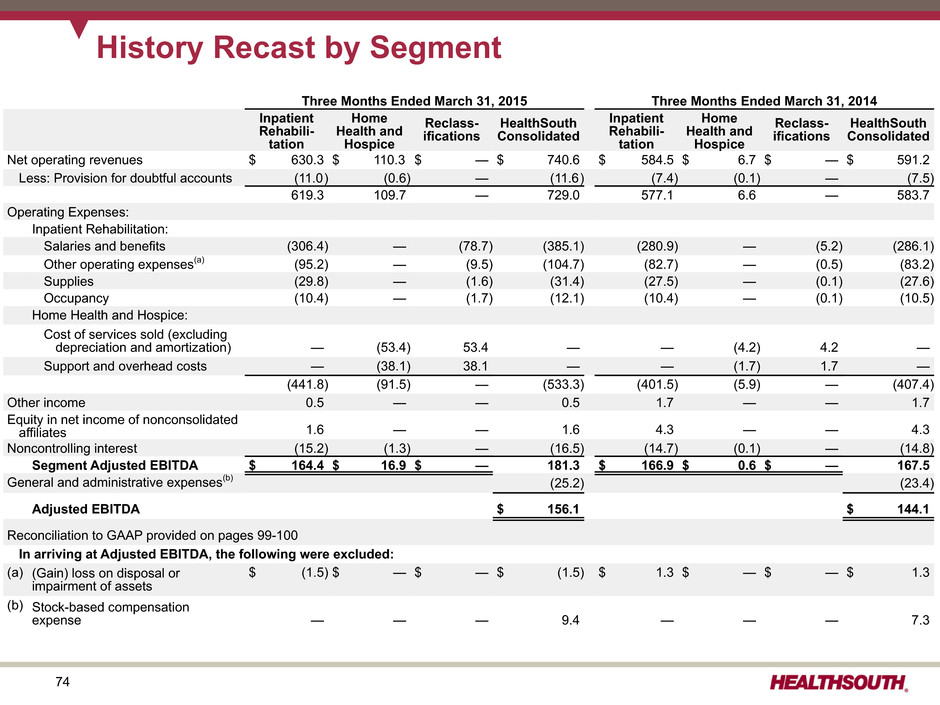
74 History Recast by Segment (9.4) Three Months Ended March 31, 2015 Three Months Ended March 31, 2014 Inpatient Rehabili- tation Home Health and Hospice Reclass- ifications HealthSouth Consolidated Inpatient Rehabili- tation Home Health and Hospice Reclass- ifications HealthSouth Consolidated Net operating revenues $ 630.3 $ 110.3 $ — $ 740.6 $ 584.5 $ 6.7 $ — $ 591.2 Less: Provision for doubtful accounts (11.0) (0.6) — (11.6) (7.4) (0.1) — (7.5) 619.3 109.7 — 729.0 577.1 6.6 — 583.7 Operating Expenses: Inpatient Rehabilitation: Salaries and benefits (306.4) — (78.7) (385.1) (280.9) — (5.2) (286.1) Other operating expenses(a) (95.2) — (9.5) (104.7) (82.7) — (0.5) (83.2) Supplies (29.8) — (1.6) (31.4) (27.5) — (0.1) (27.6) Occupancy (10.4) — (1.7) (12.1) (10.4) — (0.1) (10.5) Home Health and Hospice: Cost of services sold (excluding depreciation and amortization) — (53.4) 53.4 — — (4.2) 4.2 — Support and overhead costs — (38.1) 38.1 — — (1.7) 1.7 — (441.8) (91.5) — (533.3) (401.5) (5.9) — (407.4) Other income 0.5 — — 0.5 1.7 — — 1.7 Equity in net income of nonconsolidated affiliates 1.6 — — 1.6 4.3 — — 4.3 Noncontrolling interest (15.2) (1.3) — (16.5) (14.7) (0.1) — (14.8) Segment Adjusted EBITDA $ 164.4 $ 16.9 $ — 181.3 $ 166.9 $ 0.6 $ — 167.5 General and administrative expenses(b) (25.2) (23.4) Adjusted EBITDA $ 156.1 $ 144.1 Reconciliation to GAAP provided on pages 99-100 In arriving at Adjusted EBITDA, the following were excluded: (a) (Gain) loss on disposal or impairment of assets $ (1.5) $ — $ — $ (1.5) $ 1.3 $ — $ — $ 1.3 (b) Stock-based compensation expense — — — 9.4 — — — 7.3
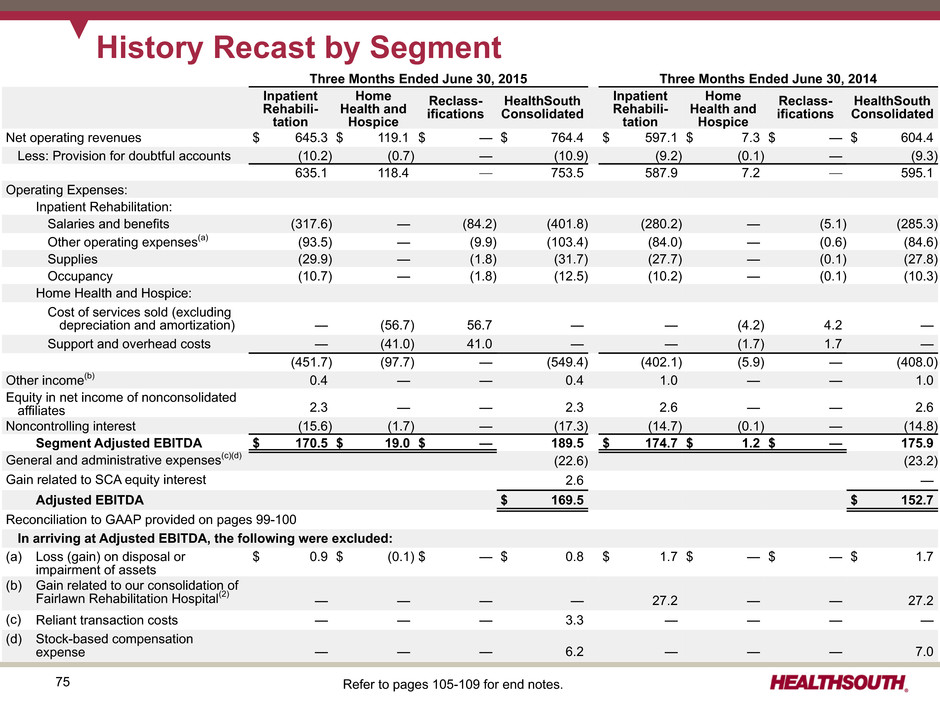
75 History Recast by Segment Three Months Ended June 30, 2015 Three Months Ended June 30, 2014 Inpatient Rehabili- tation Home Health and Hospice Reclass- ifications HealthSouth Consolidated Inpatient Rehabili- tation Home Health and Hospice Reclass- ifications HealthSouth Consolidated Net operating revenues $ 645.3 $ 119.1 $ — $ 764.4 $ 597.1 $ 7.3 $ — $ 604.4 Less: Provision for doubtful accounts (10.2) (0.7) — (10.9) (9.2) (0.1) — (9.3) 635.1 118.4 — 753.5 587.9 7.2 — 595.1 Operating Expenses: Inpatient Rehabilitation: Salaries and benefits (317.6) — (84.2) (401.8) (280.2) — (5.1) (285.3) Other operating expenses(a) (93.5) — (9.9) (103.4) (84.0) — (0.6) (84.6) Supplies (29.9) — (1.8) (31.7) (27.7) — (0.1) (27.8) Occupancy (10.7) — (1.8) (12.5) (10.2) — (0.1) (10.3) Home Health and Hospice: Cost of services sold (excluding depreciation and amortization) — (56.7) 56.7 — — (4.2) 4.2 — Support and overhead costs — (41.0) 41.0 — — (1.7) 1.7 — (451.7) (97.7) — (549.4) (402.1) (5.9) — (408.0) Other income(b) 0.4 — — 0.4 1.0 — — 1.0 Equity in net income of nonconsolidated affiliates 2.3 — — 2.3 2.6 — — 2.6 Noncontrolling interest (15.6) (1.7) — (17.3) (14.7) (0.1) — (14.8) Segment Adjusted EBITDA $ 170.5 $ 19.0 $ — 189.5 $ 174.7 $ 1.2 $ — 175.9 General and administrative expenses(c)(d) (22.6) (23.2) Gain related to SCA equity interest 2.6 — Adjusted EBITDA $ 169.5 $ 152.7 Reconciliation to GAAP provided on pages 99-100 In arriving at Adjusted EBITDA, the following were excluded: (a) Loss (gain) on disposal or impairment of assets $ 0.9 $ (0.1) $ — $ 0.8 $ 1.7 $ — $ — $ 1.7 (b) Gain related to our consolidation of Fairlawn Rehabilitation Hospital(2) — — — — 27.2 — — 27.2 (c) Reliant transaction costs — — — 3.3 — — — — (d) Stock-based compensation expense — — — 6.2 — — — 7.0 Refer to pages 105-109 for end notes.
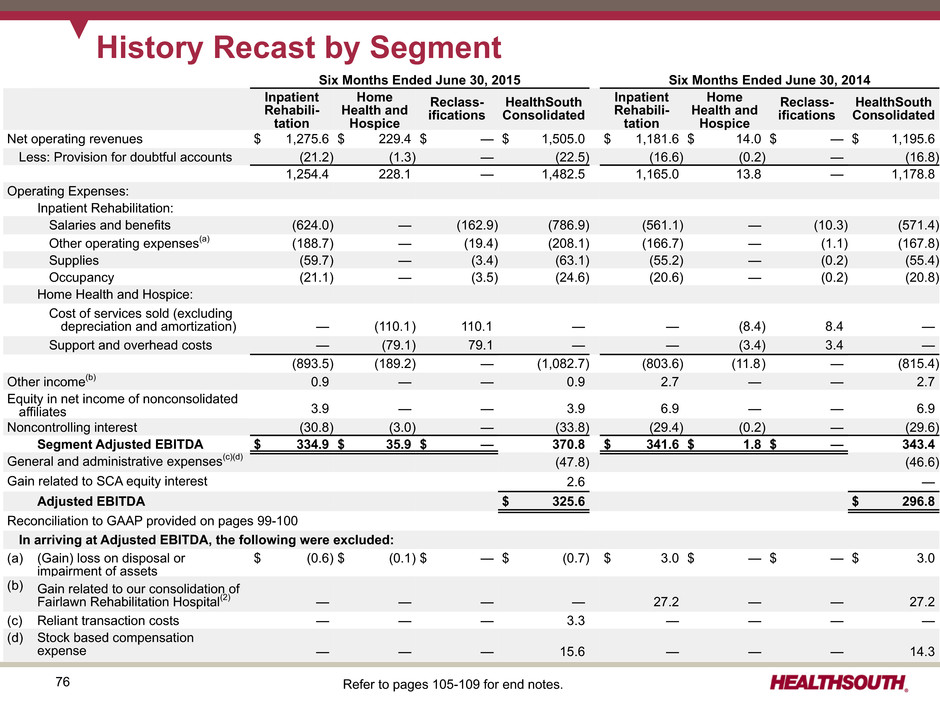
76 History Recast by Segment Six Months Ended June 30, 2015 Six Months Ended June 30, 2014 Inpatient Rehabili- tation Home Health and Hospice Reclass- ifications HealthSouth Consolidated Inpatient Rehabili- tation Home Health and Hospice Reclass- ifications HealthSouth Consolidated Net operating revenues $ 1,275.6 $ 229.4 $ — $ 1,505.0 $ 1,181.6 $ 14.0 $ — $ 1,195.6 Less: Provision for doubtful accounts (21.2) (1.3) — (22.5) (16.6) (0.2) — (16.8) 1,254.4 228.1 — 1,482.5 1,165.0 13.8 — 1,178.8 Operating Expenses: Inpatient Rehabilitation: Salaries and benefits (624.0) — (162.9) (786.9) (561.1) — (10.3) (571.4) Other operating expenses(a) (188.7) — (19.4) (208.1) (166.7) — (1.1) (167.8) Supplies (59.7) — (3.4) (63.1) (55.2) — (0.2) (55.4) Occupancy (21.1) — (3.5) (24.6) (20.6) — (0.2) (20.8) Home Health and Hospice: Cost of services sold (excluding depreciation and amortization) — (110.1) 110.1 — — (8.4) 8.4 — Support and overhead costs — (79.1) 79.1 — — (3.4) 3.4 — (893.5) (189.2) — (1,082.7) (803.6) (11.8) — (815.4) Other income(b) 0.9 — — 0.9 2.7 — — 2.7 Equity in net income of nonconsolidated affiliates 3.9 — — 3.9 6.9 — — 6.9 Noncontrolling interest (30.8) (3.0) — (33.8) (29.4) (0.2) — (29.6) Segment Adjusted EBITDA $ 334.9 $ 35.9 $ — 370.8 $ 341.6 $ 1.8 $ — 343.4 General and administrative expenses(c)(d) (47.8) (46.6) Gain related to SCA equity interest 2.6 — Adjusted EBITDA $ 325.6 $ 296.8 Reconciliation to GAAP provided on pages 99-100 In arriving at Adjusted EBITDA, the following were excluded: (a) (Gain) loss on disposal or impairment of assets $ (0.6) $ (0.1) $ — $ (0.7) $ 3.0 $ — $ — $ 3.0 (b) Gain related to our consolidation of Fairlawn Rehabilitation Hospital(2) — — — — 27.2 — — 27.2 (c) Reliant transaction costs — — — 3.3 — — — — (d) Stock based compensation expense — — — 15.6 — — — 14.3 Refer to pages 105-109 for end notes.
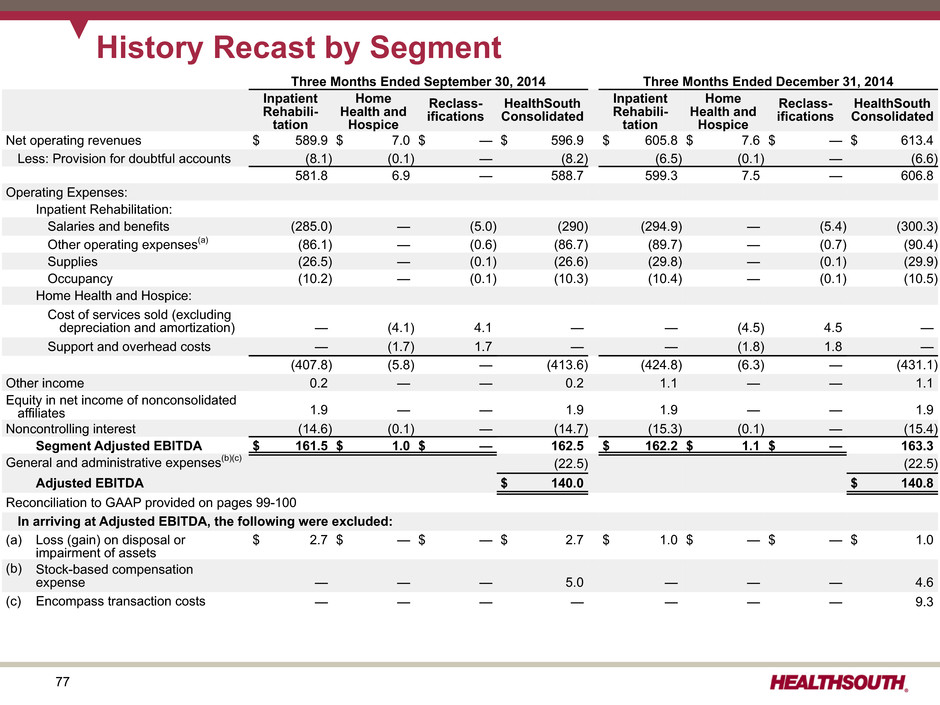
77 History Recast by Segment Three Months Ended September 30, 2014 Three Months Ended December 31, 2014 Inpatient Rehabili- tation Home Health and Hospice Reclass- ifications HealthSouth Consolidated Inpatient Rehabili- tation Home Health and Hospice Reclass- ifications HealthSouth Consolidated Net operating revenues $ 589.9 $ 7.0 $ — $ 596.9 $ 605.8 $ 7.6 $ — $ 613.4 Less: Provision for doubtful accounts (8.1) (0.1) — (8.2) (6.5) (0.1) — (6.6) 581.8 6.9 — 588.7 599.3 7.5 — 606.8 Operating Expenses: Inpatient Rehabilitation: Salaries and benefits (285.0) — (5.0) (290) (294.9) — (5.4) (300.3) Other operating expenses(a) (86.1) — (0.6) (86.7) (89.7) — (0.7) (90.4) Supplies (26.5) — (0.1) (26.6) (29.8) — (0.1) (29.9) Occupancy (10.2) — (0.1) (10.3) (10.4) — (0.1) (10.5) Home Health and Hospice: Cost of services sold (excluding depreciation and amortization) — (4.1) 4.1 — — (4.5) 4.5 — Support and overhead costs — (1.7) 1.7 — — (1.8) 1.8 — (407.8) (5.8) — (413.6) (424.8) (6.3) — (431.1) Other income 0.2 — — 0.2 1.1 — — 1.1 Equity in net income of nonconsolidated affiliates 1.9 — — 1.9 1.9 — — 1.9 Noncontrolling interest (14.6) (0.1) — (14.7) (15.3) (0.1) — (15.4) Segment Adjusted EBITDA $ 161.5 $ 1.0 $ — 162.5 $ 162.2 $ 1.1 $ — 163.3 General and administrative expenses(b)(c) (22.5) (22.5) Adjusted EBITDA $ 140.0 $ 140.8 Reconciliation to GAAP provided on pages 99-100 In arriving at Adjusted EBITDA, the following were excluded: (a) Loss (gain) on disposal or impairment of assets $ 2.7 $ — $ — $ 2.7 $ 1.0 $ — $ — $ 1.0 (b) Stock-based compensation expense — — — 5.0 — — — 4.6 (c) Encompass transaction costs — — — — — — — 9.3
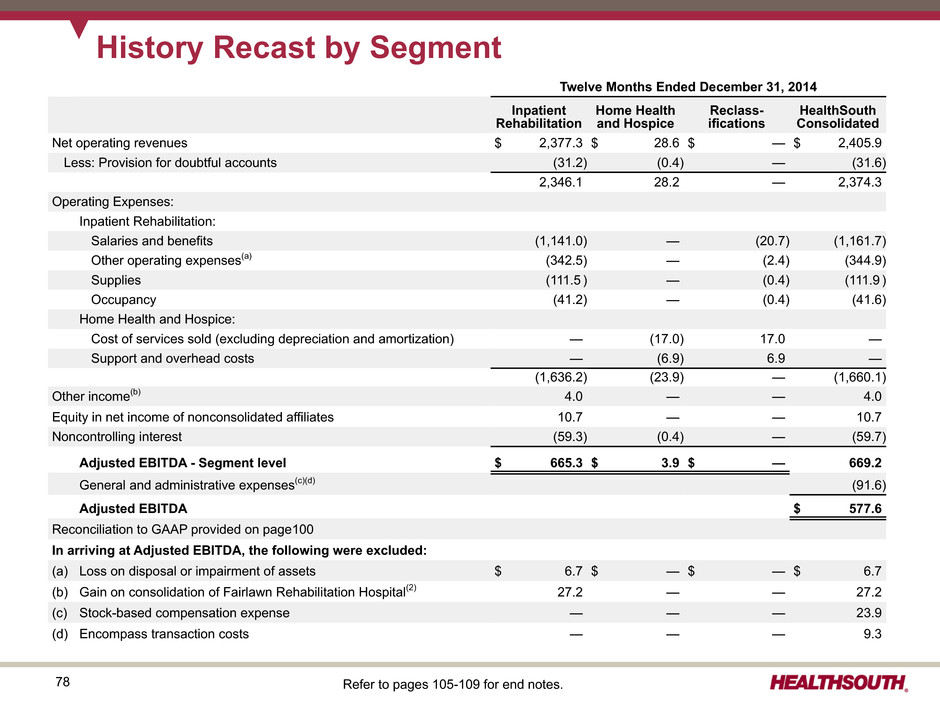
78 Twelve Months Ended December 31, 2014 Inpatient Rehabilitation Home Health and Hospice Reclass- ifications HealthSouth Consolidated Net operating revenues $ 2,377.3 $ 28.6 $ — $ 2,405.9 Less: Provision for doubtful accounts (31.2) (0.4) — (31.6) 2,346.1 28.2 — 2,374.3 Operating Expenses: Inpatient Rehabilitation: Salaries and benefits (1,141.0) — (20.7) (1,161.7) Other operating expenses(a) (342.5) — (2.4) (344.9) Supplies (111.5 ) — (0.4) (111.9 ) Occupancy (41.2) — (0.4) (41.6) Home Health and Hospice: Cost of services sold (excluding depreciation and amortization) — (17.0) 17.0 — Support and overhead costs — (6.9) 6.9 — (1,636.2) (23.9) — (1,660.1) Other income(b) 4.0 — — 4.0 Equity in net income of nonconsolidated affiliates 10.7 — — 10.7 Noncontrolling interest (59.3) (0.4) — (59.7) Adjusted EBITDA - Segment level $ 665.3 $ 3.9 $ — 669.2 General and administrative expenses(c)(d) (91.6) Adjusted EBITDA $ 577.6 Reconciliation to GAAP provided on page100 In arriving at Adjusted EBITDA, the following were excluded: (a) Loss on disposal or impairment of assets $ 6.7 $ — $ — $ 6.7 (b) Gain on consolidation of Fairlawn Rehabilitation Hospital(2) 27.2 — — 27.2 (c) Stock-based compensation expense — — — 23.9 (d) Encompass transaction costs — — — 9.3 History Recast by Segment Refer to pages 105-109 for end notes.
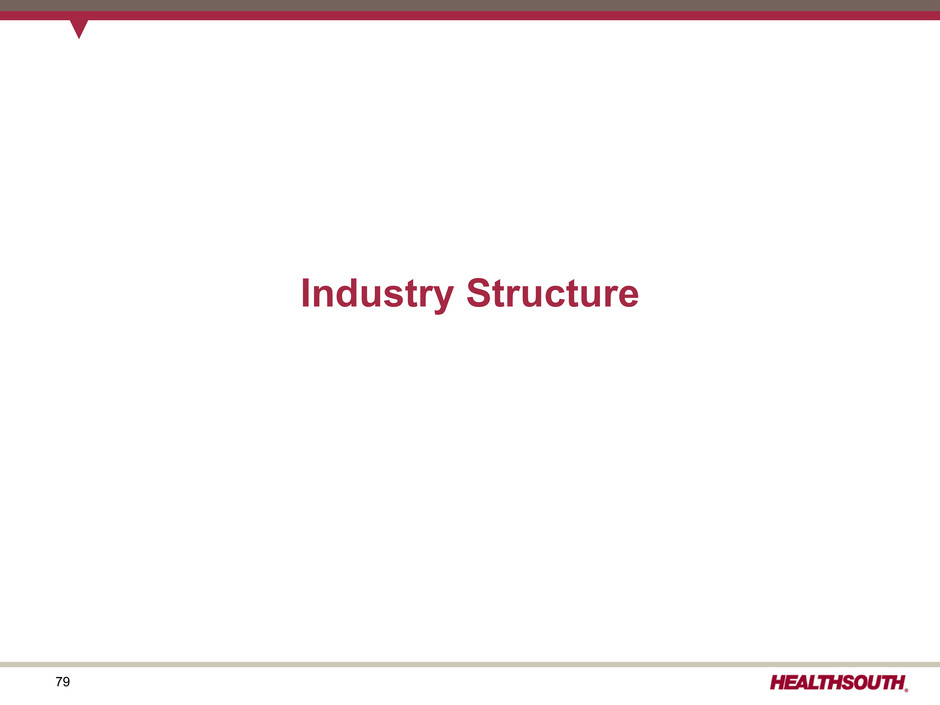
79 Industry Structure
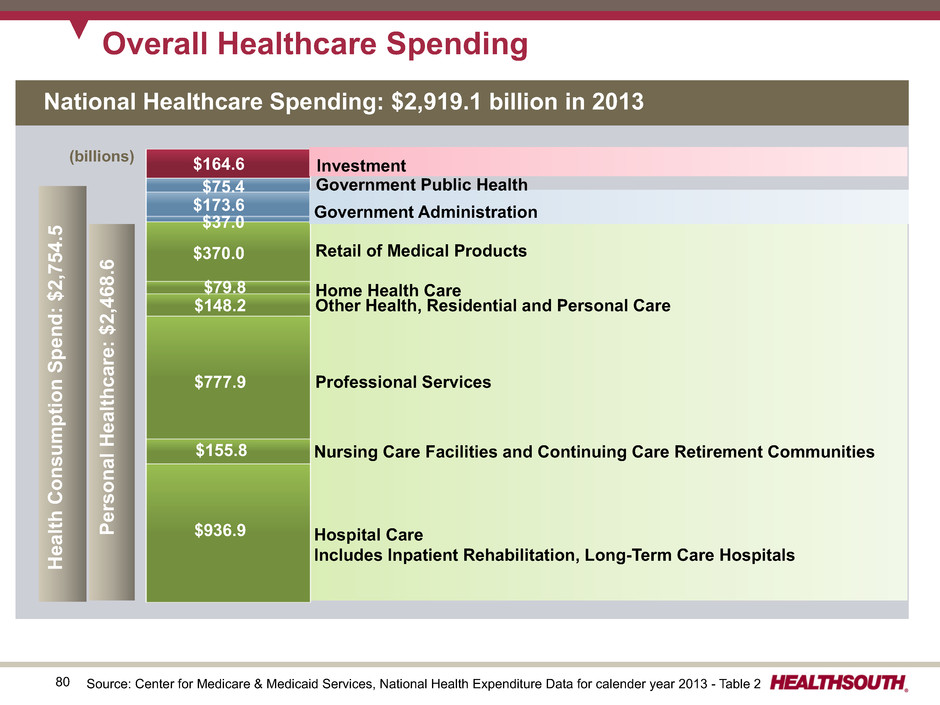
80 Overall Healthcare Spending Hospital Care Includes Inpatient Rehabilitation, Long-Term Care Hospitals $777.9 $148.2 $79.8 $370.0 Nursing Care Facilities and Continuing Care Retirement Communities Professional Services Other Health, Residential and Personal Care Home Health Care Retail of Medical Products $37.0 $173.6 $75.4 $164.6(billions) Health Consumption Spend: $2,754.5 Personal Healthcare: $2,468. 6 Investment Net Cost of Health Insurance Government Public Health Government Administration $936.9 $155.8 Source: Center for Medicare & Medicaid Services, National Health Expenditure Data for calender year 2013 - Table 2 National Healthcare Spending: $2,919.1 billion in 2013

81 Medicare 2013 Spending = $582.9 Billion $ 28.4B Skilled Nursing $136.8B Inpatient Hospital(51) $68.6B Physician Payments $41.8B Outpatient Hospital $18.4B Home Health $69.3B Other Services(52) $145.9B Medicare Managed Care $69.3B Outpatient Rx $6.8B (1%) Inpatient Rehabilitation Hospitals (Included in Inpatient Hospitals) 12% 3% 7% 12% 12% 25% 24% Medicare Part A Medicare Part B Medicare Parts A&B Medicare Part C Medicare Part D 5% Source: Centers for Medicare & Medicaid Services, Medicare Trustee’s Report July 2014 – page 11 and MedPAC, Medicare Payment Policy, March 2015 Refer to pages 105-109 for end notes.
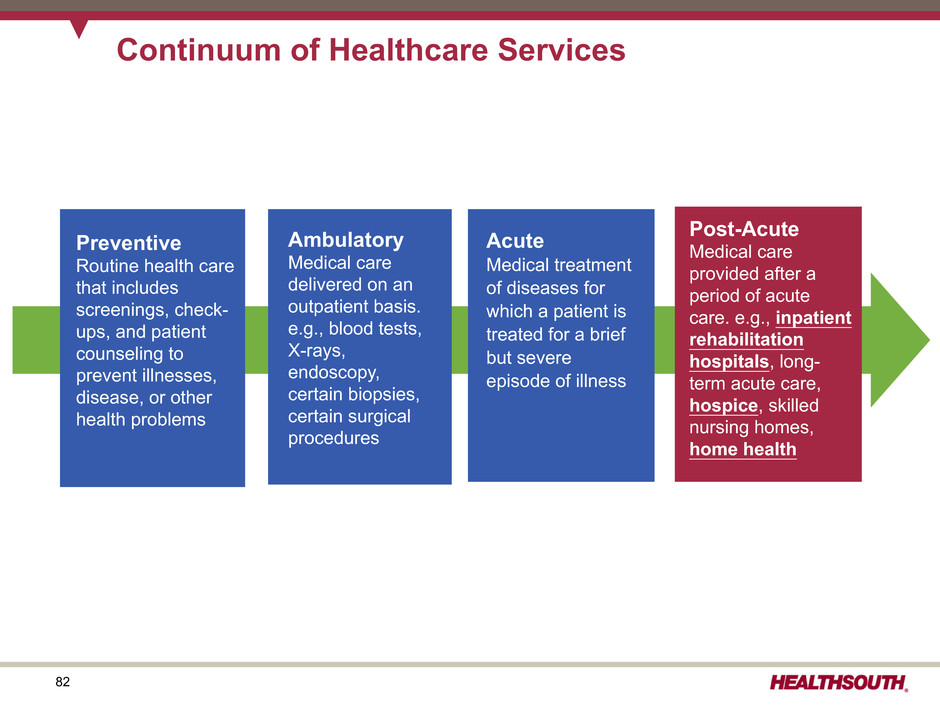
82 Continuum of Healthcare Services Preventive Routine health care that includes screenings, check- ups, and patient counseling to prevent illnesses, disease, or other health problems Acute Medical treatment of diseases for which a patient is treated for a brief but severe episode of illness Ambulatory Medical care delivered on an outpatient basis. e.g., blood tests, X-rays, endoscopy, certain biopsies, certain surgical procedures Post-Acute Medical care provided after a period of acute care. e.g., inpatient rehabilitation hospitals, long- term acute care, hospice, skilled nursing homes, home health
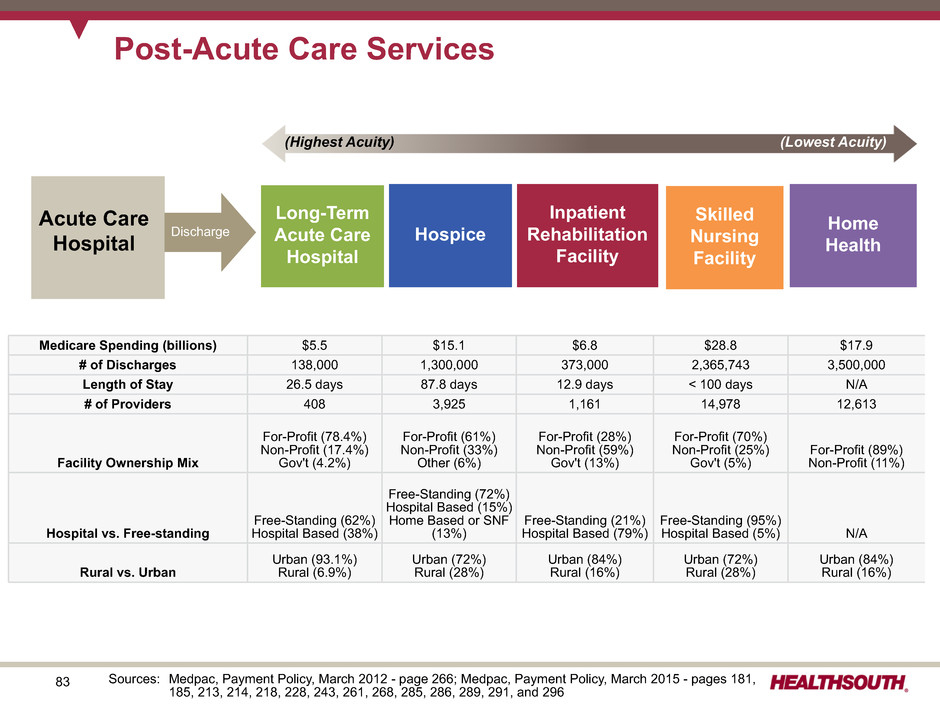
83 Post-Acute Care Services Acute Care Hospital Home HealthHospice Long-Term Acute Care Hospital Inpatient Rehabilitation Facility Skilled Nursing Facility Discharge Medicare Spending (billions) $5.5 $15.1 $6.8 $28.8 $17.9 # of Discharges 138,000 1,300,000 373,000 2,365,743 3,500,000 Length of Stay 26.5 days 87.8 days 12.9 days < 100 days N/A # of Providers 408 3,925 1,161 14,978 12,613 Facility Ownership Mix For-Profit (78.4%) Non-Profit (17.4%) Gov't (4.2%) For-Profit (61%) Non-Profit (33%) Other (6%) For-Profit (28%) Non-Profit (59%) Gov't (13%) For-Profit (70%) Non-Profit (25%) Gov't (5%) For-Profit (89%) Non-Profit (11%) Hospital vs. Free-standing Free-Standing (62%) Hospital Based (38%) Free-Standing (72%) Hospital Based (15%) Home Based or SNF (13%) Free-Standing (21%) Hospital Based (79%) Free-Standing (95%) Hospital Based (5%) N/A Rural vs. Urban Urban (93.1%) Rural (6.9%) Urban (72%) Rural (28%) Urban (84%) Rural (16%) Urban (72%) Rural (28%) Urban (84%) Rural (16%) (Lowest Acuity)(Highest Acuity) Sources: Medpac, Payment Policy, March 2012 - page 266; Medpac, Payment Policy, March 2015 - pages 181, 185, 213, 214, 218, 228, 243, 261, 268, 285, 286, 289, 291, and 296
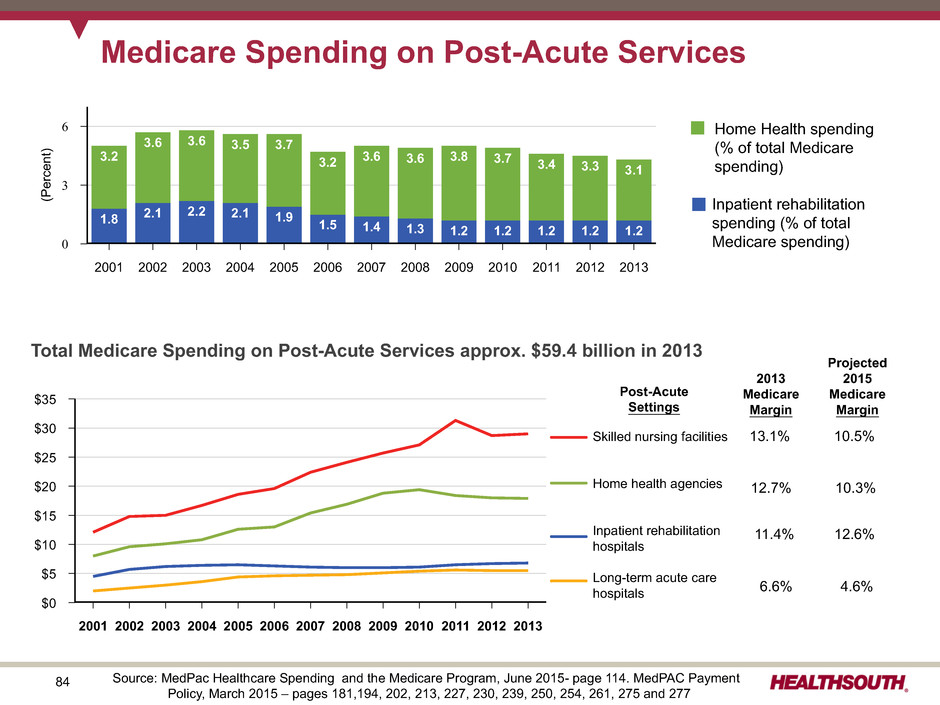
84 $35 $30 $25 $20 $15 $10 $5 $0 2001 2002 2003 2004 2005 2006 2007 2008 2009 2010 2011 2012 2013 Medicare Spending on Post-Acute Services Post-Acute Settings 2013 Medicare Margin Projected 2015 Medicare Margin Sources: (1) 13.1% 10.5% 12.7% 10.3% 11.4% 12.6% 6.6% 4.6% Skilled nursing facilities Home health agencies Inpatient rehabilitation hospitals Long-term acute care hospitals Inpatient rehabilitation spending (% of total Medicare spending) Source: MedPac Healthcare Spending and the Medicare Program, June 2015- page 114. MedPAC Payment Policy, March 2015 – pages 181,194, 202, 213, 227, 230, 239, 250, 254, 261, 275 and 277 6 3 0 (P er ce nt ) 2001 2002 2003 2004 2005 2006 2007 2008 2009 2010 2011 2012 2013 1.8 2.1 2.2 2.1 1.9 1.5 1.4 1.3 1.2 1.2 1.2 1.2 1.2 3.2 3.6 3.6 3.5 3.7 3.2 3.6 3.6 3.8 3.7 3.4 3.3 3.1 Home Health spending (% of total Medicare spending) Total Medicare Spending on Post-Acute Services approx. $59.4 billion in 2013
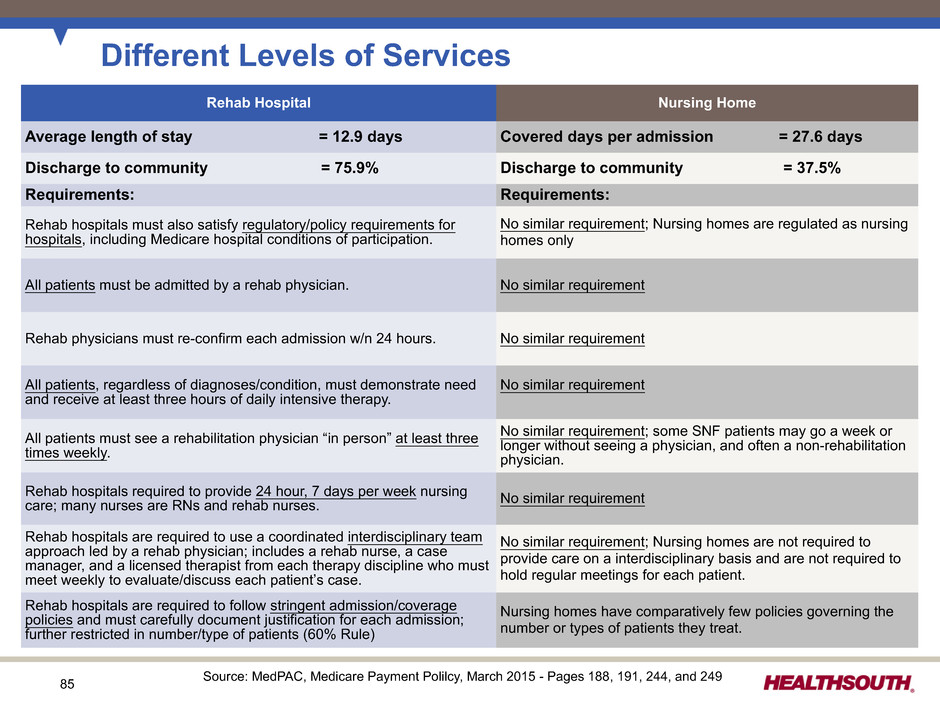
85 Different Levels of Services Rehab Hospital Nursing Home Average length of stay = 12.9 days Covered days per admission = 27.6 days Discharge to community = 75.9% Discharge to community = 37.5% Requirements: Requirements: Rehab hospitals must also satisfy regulatory/policy requirements for hospitals, including Medicare hospital conditions of participation. No similar requirement; Nursing homes are regulated as nursing homes only All patients must be admitted by a rehab physician. No similar requirement Rehab physicians must re-confirm each admission w/n 24 hours. No similar requirement All patients, regardless of diagnoses/condition, must demonstrate need and receive at least three hours of daily intensive therapy. No similar requirement All patients must see a rehabilitation physician “in person” at least three times weekly. No similar requirement; some SNF patients may go a week or longer without seeing a physician, and often a non-rehabilitation physician. Rehab hospitals required to provide 24 hour, 7 days per week nursing care; many nurses are RNs and rehab nurses. No similar requirement Rehab hospitals are required to use a coordinated interdisciplinary team approach led by a rehab physician; includes a rehab nurse, a case manager, and a licensed therapist from each therapy discipline who must meet weekly to evaluate/discuss each patient’s case. No similar requirement; Nursing homes are not required to provide care on a interdisciplinary basis and are not required to hold regular meetings for each patient. Rehab hospitals are required to follow stringent admission/coverage policies and must carefully document justification for each admission; further restricted in number/type of patients (60% Rule) Nursing homes have comparatively few policies governing the number or types of patients they treat. Source: MedPAC, Medicare Payment Polilcy, March 2015 - Pages 188, 191, 244, and 249
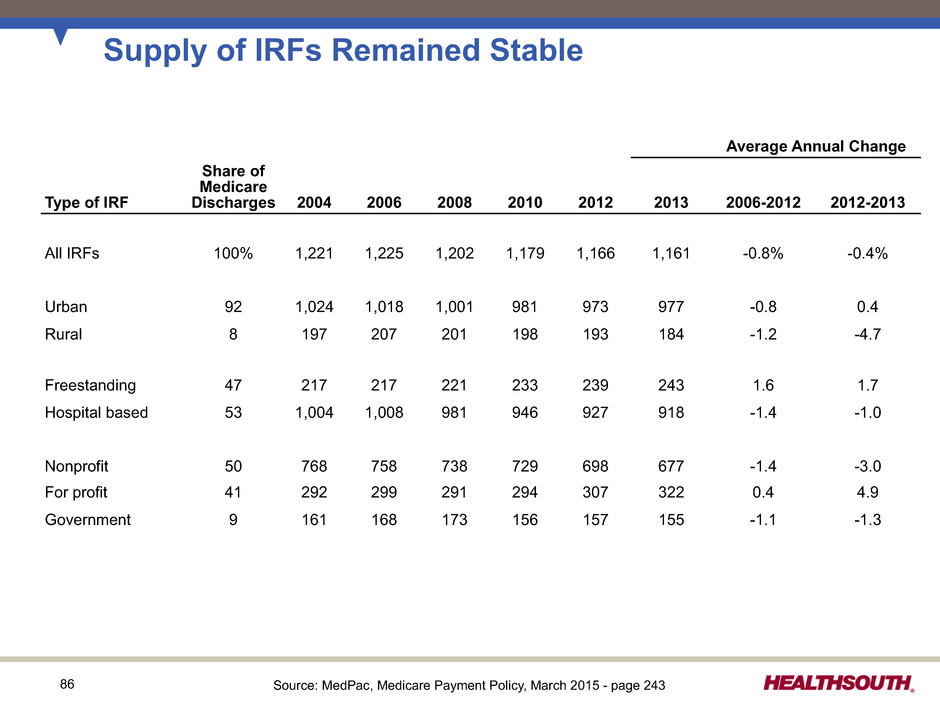
86 Supply of IRFs Remained Stable Average Annual Change Share of Medicare DischargesType of IRF 2004 2006 2008 2010 2012 2013 2006-2012 2012-2013 All IRFs 100% 1,221 1,225 1,202 1,179 1,166 1,161 -0.8% -0.4% Urban 92 1,024 1,018 1,001 981 973 977 -0.8 0.4 Rural 8 197 207 201 198 193 184 -1.2 -4.7 Freestanding 47 217 217 221 233 239 243 1.6 1.7 Hospital based 53 1,004 1,008 981 946 927 918 -1.4 -1.0 Nonprofit 50 768 758 738 729 698 677 -1.4 -3.0 For profit 41 292 299 291 294 307 322 0.4 4.9 Government 9 161 168 173 156 157 155 -1.1 -1.3 Source: MedPac, Medicare Payment Policy, March 2015 - page 243
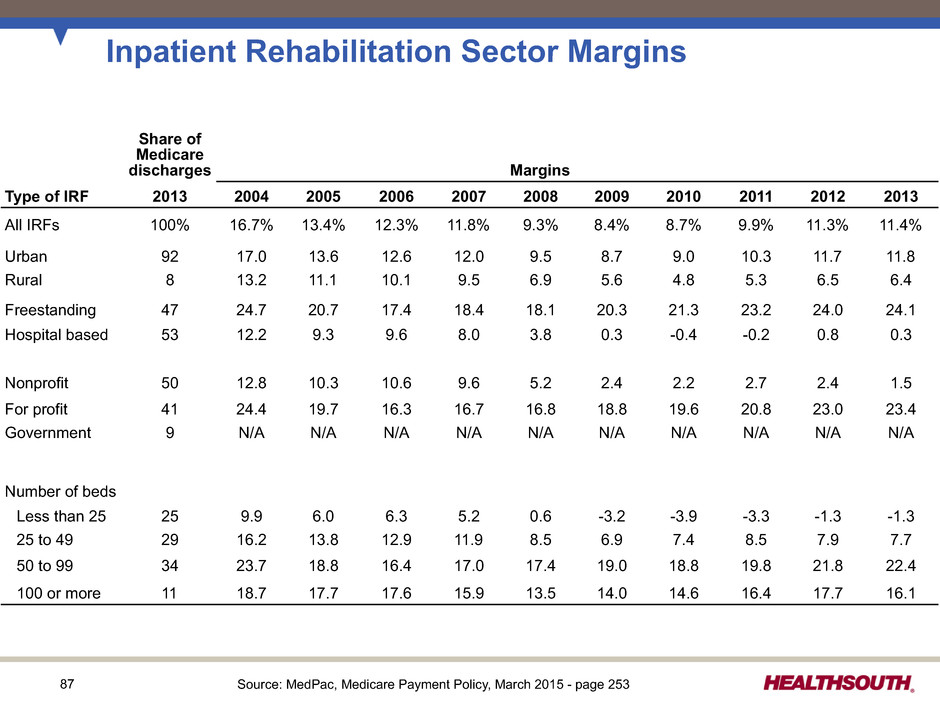
87 Inpatient Rehabilitation Sector Margins Share of Medicare discharges Margins Type of IRF 2013 2004 2005 2006 2007 2008 2009 2010 2011 2012 2013 All IRFs 100% 16.7% 13.4% 12.3% 11.8% 9.3% 8.4% 8.7% 9.9% 11.3% 11.4% Urban 92 17.0 13.6 12.6 12.0 9.5 8.7 9.0 10.3 11.7 11.8 Rural 8 13.2 11.1 10.1 9.5 6.9 5.6 4.8 5.3 6.5 6.4 Freestanding 47 24.7 20.7 17.4 18.4 18.1 20.3 21.3 23.2 24.0 24.1 Hospital based 53 12.2 9.3 9.6 8.0 3.8 0.3 -0.4 -0.2 0.8 0.3 Nonprofit 50 12.8 10.3 10.6 9.6 5.2 2.4 2.2 2.7 2.4 1.5 For profit 41 24.4 19.7 16.3 16.7 16.8 18.8 19.6 20.8 23.0 23.4 Government 9 N/A N/A N/A N/A N/A N/A N/A N/A N/A N/A Number of beds Less than 25 25 9.9 6.0 6.3 5.2 0.6 -3.2 -3.9 -3.3 -1.3 -1.3 25 to 49 29 16.2 13.8 12.9 11.9 8.5 6.9 7.4 8.5 7.9 7.7 50 to 99 34 23.7 18.8 16.4 17.0 17.4 19.0 18.8 19.8 21.8 22.4 100 or more 11 18.7 17.7 17.6 15.9 13.5 14.0 14.6 16.4 17.7 16.1 Source: MedPac, Medicare Payment Policy, March 2015 - page 253
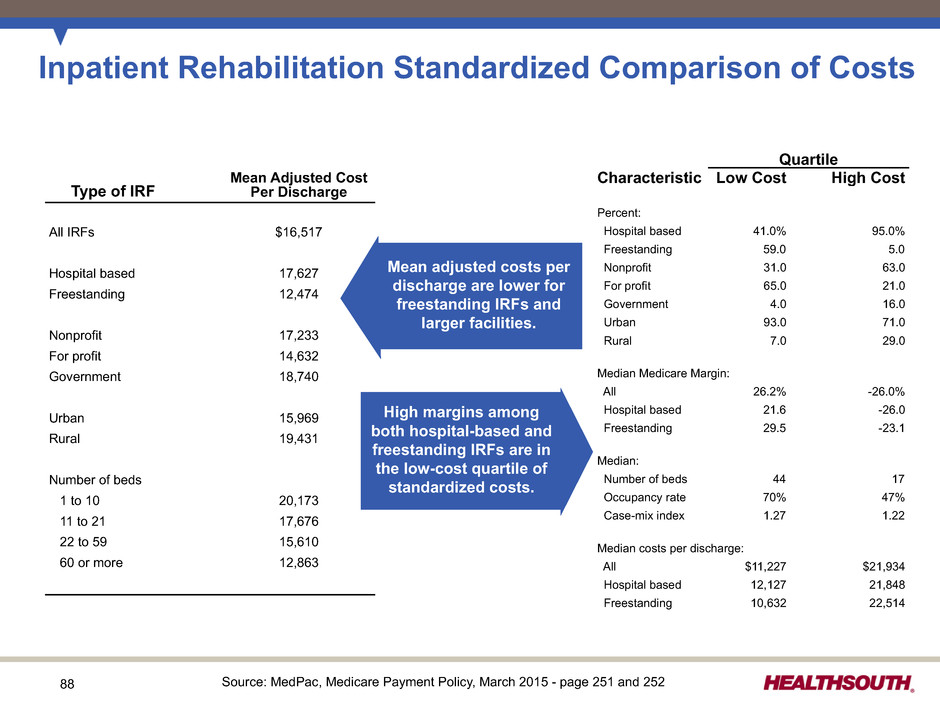
88 Inpatient Rehabilitation Standardized Comparison of Costs Type of IRF Mean Adjusted Cost Per Discharge All IRFs $16,517 Hospital based 17,627 Freestanding 12,474 Nonprofit 17,233 For profit 14,632 Government 18,740 Urban 15,969 Rural 19,431 Number of beds 1 to 10 20,173 11 to 21 17,676 22 to 59 15,610 60 or more 12,863 Quartile Characteristic Low Cost High Cost Percent: Hospital based 41.0% 95.0% Freestanding 59.0 5.0 Nonprofit 31.0 63.0 For profit 65.0 21.0 Government 4.0 16.0 Urban 93.0 71.0 Rural 7.0 29.0 Median Medicare Margin: All 26.2% -26.0% Hospital based 21.6 -26.0 Freestanding 29.5 -23.1 Median: Number of beds 44 17 Occupancy rate 70% 47% Case-mix index 1.27 1.22 Median costs per discharge: All $11,227 $21,934 Hospital based 12,127 21,848 Freestanding 10,632 22,514 Mean adjusted costs per discharge are lower for freestanding IRFs and larger facilities. High margins among both hospital-based and freestanding IRFs are in the low-cost quartile of standardized costs. Source: MedPac, Medicare Payment Policy, March 2015 - page 251 and 252
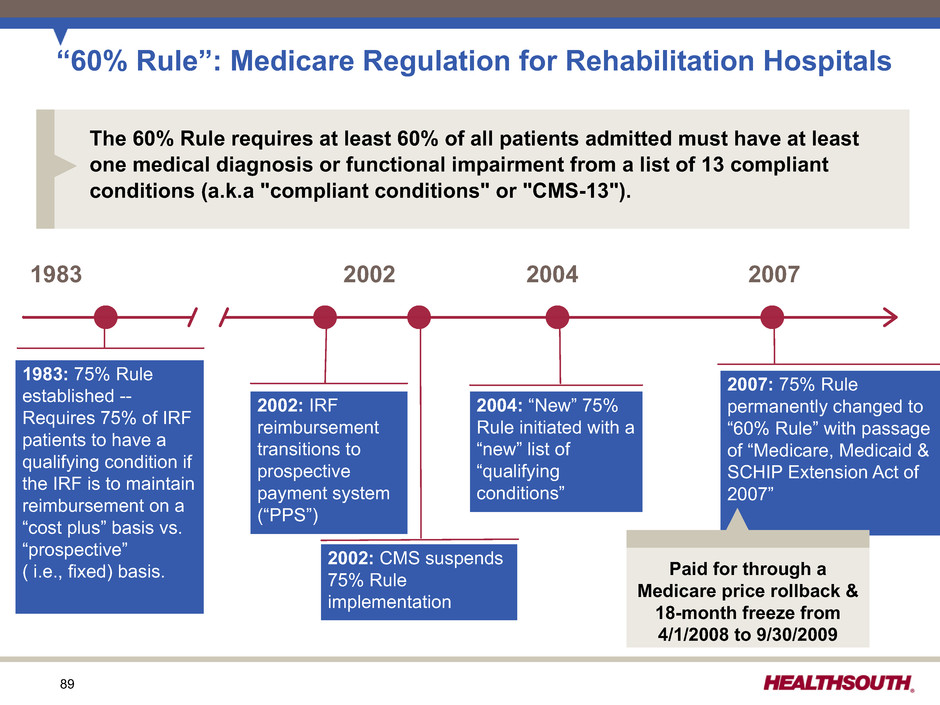
89 “60% Rule”: Medicare Regulation for Rehabilitation Hospitals 1983 1983: 75% Rule established -- Requires 75% of IRF patients to have a qualifying condition if the IRF is to maintain reimbursement on a “cost plus” basis vs. “prospective” ( i.e., fixed) basis. 2002 2004 2007 2002: IRF reimbursement transitions to prospective payment system (“PPS”) 2002: CMS suspends 75% Rule implementation 2004: “New” 75% Rule initiated with a “new” list of “qualifying conditions” 2007: 75% Rule permanently changed to “60% Rule” with passage of “Medicare, Medicaid & SCHIP Extension Act of 2007” Paid for through a Medicare price rollback & 18-month freeze from 4/1/2008 to 9/30/2009 The 60% Rule requires at least 60% of all patients admitted must have at least one medical diagnosis or functional impairment from a list of 13 compliant conditions (a.k.a "compliant conditions" or "CMS-13").
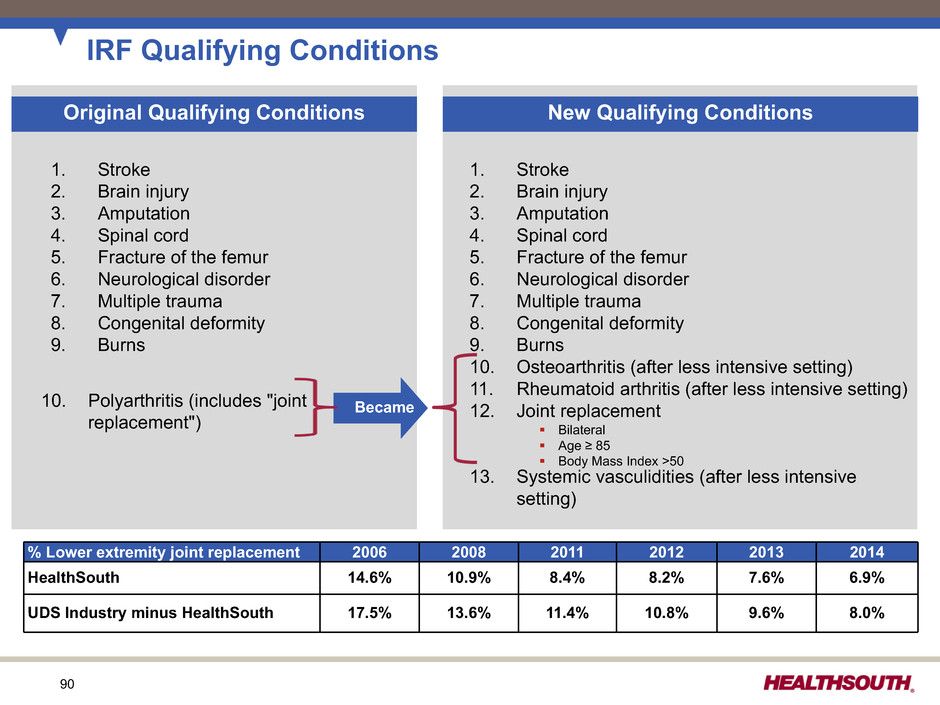
90 IRF Qualifying Conditions 1. Stroke 2. Brain injury 3. Amputation 4. Spinal cord 5. Fracture of the femur 6. Neurological disorder 7. Multiple trauma 8. Congenital deformity 9. Burns 10. Osteoarthritis (after less intensive setting) 11. Rheumatoid arthritis (after less intensive setting) 12. Joint replacement 13. Systemic vasculidities (after less intensive setting) % Lower extremity joint replacement 2006 2008 2011 2012 2013 2014 HealthSouth 14.6% 10.9% 8.4% 8.2% 7.6% 6.9% UDS Industry minus HealthSouth 17.5% 13.6% 11.4% 10.8% 9.6% 8.0% Became 1. Stroke 2. Brain injury 3. Amputation 4. Spinal cord 5. Fracture of the femur 6. Neurological disorder 7. Multiple trauma 8. Congenital deformity 9. Burns Original Qualifying Conditions New Qualifying Conditions § Bilateral § Age ≥ 85 § Body Mass Index >50 10. Polyarthritis (includes "joint replacement") Became
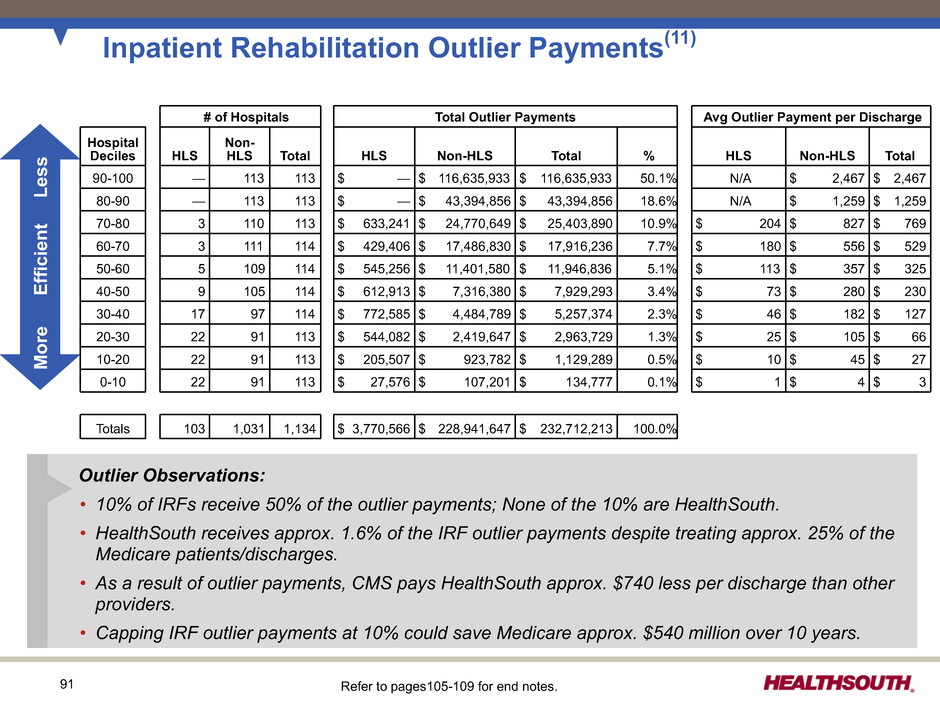
91 Inpatient Rehabilitation Outlier Payments(11) # of Hospitals Total Outlier Payments Avg Outlier Payment per Discharge Hospital Deciles HLS Non- HLS Total HLS Non-HLS Total % HLS Non-HLS Total 90-100 — 113 113 $ — $ 116,635,933 $ 116,635,933 50.1% N/A $ 2,467 $ 2,467 80-90 — 113 113 $ — $ 43,394,856 $ 43,394,856 18.6% N/A $ 1,259 $ 1,259 70-80 3 110 113 $ 633,241 $ 24,770,649 $ 25,403,890 10.9% $ 204 $ 827 $ 769 60-70 3 111 114 $ 429,406 $ 17,486,830 $ 17,916,236 7.7% $ 180 $ 556 $ 529 50-60 5 109 114 $ 545,256 $ 11,401,580 $ 11,946,836 5.1% $ 113 $ 357 $ 325 40-50 9 105 114 $ 612,913 $ 7,316,380 $ 7,929,293 3.4% $ 73 $ 280 $ 230 30-40 17 97 114 $ 772,585 $ 4,484,789 $ 5,257,374 2.3% $ 46 $ 182 $ 127 20-30 22 91 113 $ 544,082 $ 2,419,647 $ 2,963,729 1.3% $ 25 $ 105 $ 66 10-20 22 91 113 $ 205,507 $ 923,782 $ 1,129,289 0.5% $ 10 $ 45 $ 27 0-10 22 91 113 $ 27,576 $ 107,201 $ 134,777 0.1% $ 1 $ 4 $ 3 Totals 103 1,031 1,134 $ 3,770,566 $ 228,941,647 $ 232,712,213 100.0% Refer to pages105-109 for end notes. More Efficient Less Outlier Observations: • 10% of IRFs receive 50% of the outlier payments; None of the 10% are HealthSouth. • HealthSouth receives approx. 1.6% of the IRF outlier payments despite treating approx. 25% of the Medicare patients/discharges. • As a result of outlier payments, CMS pays HealthSouth approx. $740 less per discharge than other providers. • Capping IRF outlier payments at 10% could save Medicare approx. $540 million over 10 years.
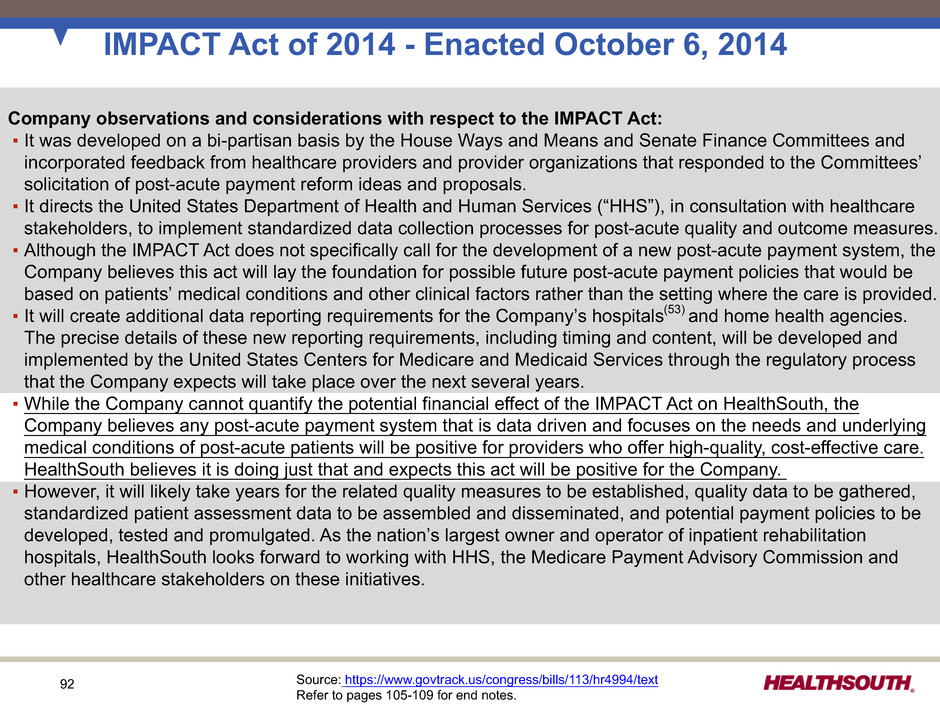
92 IMPACT Act of 2014 - Enacted October 6, 2014 Company observations and considerations with respect to the IMPACT Act: ▪ It was developed on a bi-partisan basis by the House Ways and Means and Senate Finance Committees and incorporated feedback from healthcare providers and provider organizations that responded to the Committees’ solicitation of post-acute payment reform ideas and proposals. ▪ It directs the United States Department of Health and Human Services (“HHS”), in consultation with healthcare stakeholders, to implement standardized data collection processes for post-acute quality and outcome measures. ▪ Although the IMPACT Act does not specifically call for the development of a new post-acute payment system, the Company believes this act will lay the foundation for possible future post-acute payment policies that would be based on patients’ medical conditions and other clinical factors rather than the setting where the care is provided. ▪ It will create additional data reporting requirements for the Company’s hospitals(53) and home health agencies. The precise details of these new reporting requirements, including timing and content, will be developed and implemented by the United States Centers for Medicare and Medicaid Services through the regulatory process that the Company expects will take place over the next several years. ▪ While the Company cannot quantify the potential financial effect of the IMPACT Act on HealthSouth, the Company believes any post-acute payment system that is data driven and focuses on the needs and underlying medical conditions of post-acute patients will be positive for providers who offer high-quality, cost-effective care. HealthSouth believes it is doing just that and expects this act will be positive for the Company. ▪ However, it will likely take years for the related quality measures to be established, quality data to be gathered, standardized patient assessment data to be assembled and disseminated, and potential payment policies to be developed, tested and promulgated. As the nation’s largest owner and operator of inpatient rehabilitation hospitals, HealthSouth looks forward to working with HHS, the Medicare Payment Advisory Commission and other healthcare stakeholders on these initiatives. Source: https://www.govtrack.us/congress/bills/113/hr4994/text Refer to pages 105-109 for end notes.
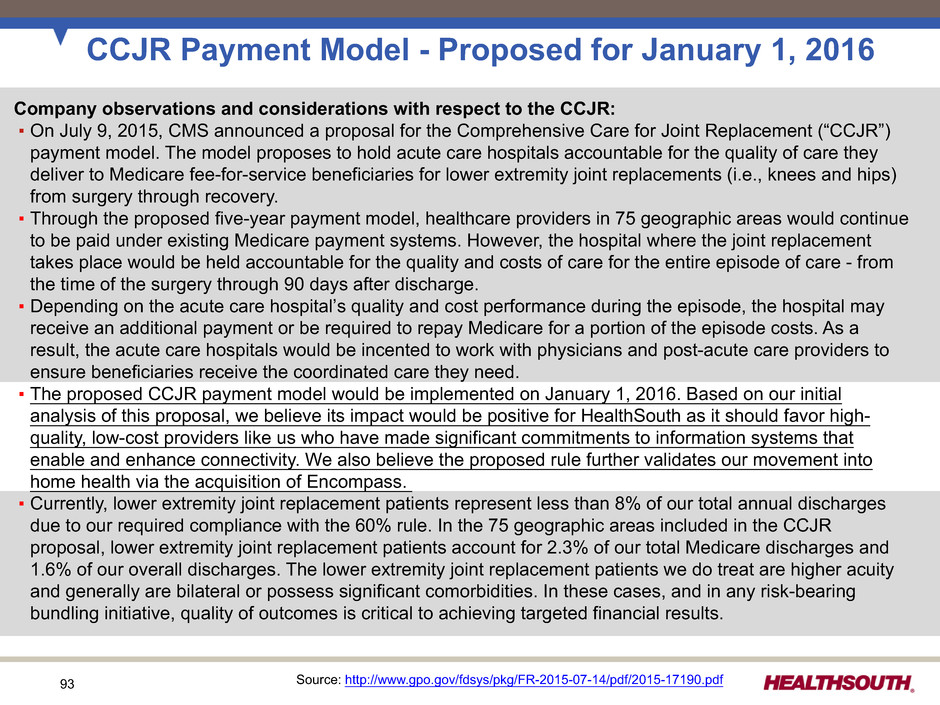
93 CCJR Payment Model - Proposed for January 1, 2016 Company observations and considerations with respect to the CCJR: ▪ On July 9, 2015, CMS announced a proposal for the Comprehensive Care for Joint Replacement (“CCJR”) payment model. The model proposes to hold acute care hospitals accountable for the quality of care they deliver to Medicare fee-for-service beneficiaries for lower extremity joint replacements (i.e., knees and hips) from surgery through recovery. ▪ Through the proposed five-year payment model, healthcare providers in 75 geographic areas would continue to be paid under existing Medicare payment systems. However, the hospital where the joint replacement takes place would be held accountable for the quality and costs of care for the entire episode of care - from the time of the surgery through 90 days after discharge. ▪ Depending on the acute care hospital’s quality and cost performance during the episode, the hospital may receive an additional payment or be required to repay Medicare for a portion of the episode costs. As a result, the acute care hospitals would be incented to work with physicians and post-acute care providers to ensure beneficiaries receive the coordinated care they need. ▪ The proposed CCJR payment model would be implemented on January 1, 2016. Based on our initial analysis of this proposal, we believe its impact would be positive for HealthSouth as it should favor high- quality, low-cost providers like us who have made significant commitments to information systems that enable and enhance connectivity. We also believe the proposed rule further validates our movement into home health via the acquisition of Encompass. ▪ Currently, lower extremity joint replacement patients represent less than 8% of our total annual discharges due to our required compliance with the 60% rule. In the 75 geographic areas included in the CCJR proposal, lower extremity joint replacement patients account for 2.3% of our total Medicare discharges and 1.6% of our overall discharges. The lower extremity joint replacement patients we do treat are higher acuity and generally are bilateral or possess significant comorbidities. In these cases, and in any risk-bearing bundling initiative, quality of outcomes is critical to achieving targeted financial results. Source: http://www.gpo.gov/fdsys/pkg/FR-2015-07-14/pdf/2015-17190.pdf
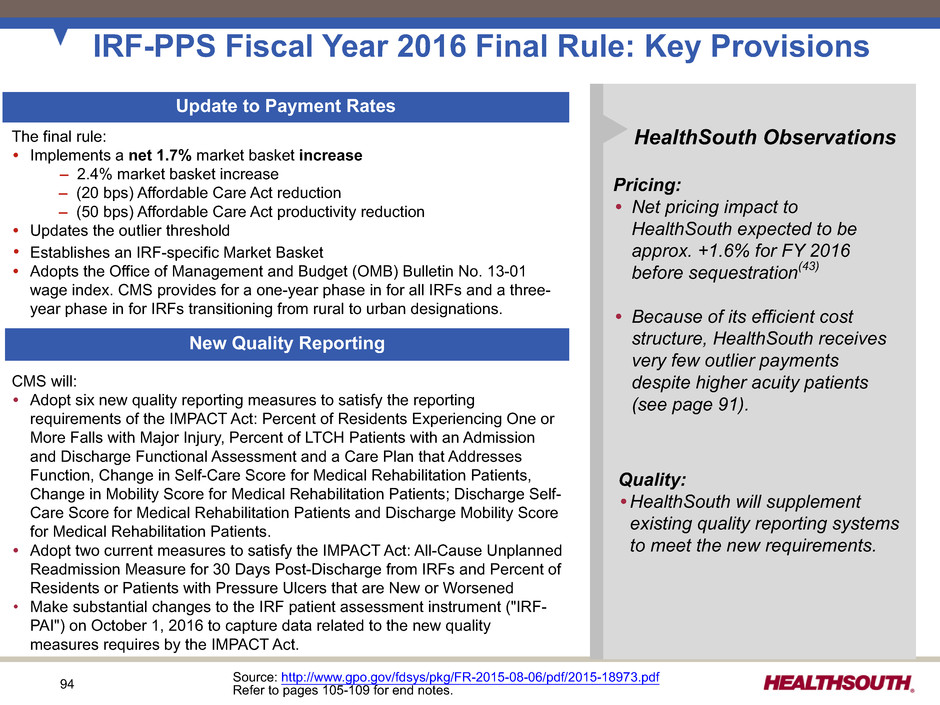
94 IRF-PPS Fiscal Year 2016 Final Rule: Key Provisions Source: http://www.gpo.gov/fdsys/pkg/FR-2015-08-06/pdf/2015-18973.pdf Refer to pages 105-109 for end notes. New Quality Reporting Update to Payment Rates HealthSouth Observations Pricing: • Net pricing impact to HealthSouth expected to be approx. +1.6% for FY 2016 before sequestration(43) • Because of its efficient cost structure, HealthSouth receives very few outlier payments despite higher acuity patients (see page 91). Quality: • HealthSouth will supplement existing quality reporting systems to meet the new requirements. The final rule: • Implements a net 1.7% market basket increase – 2.4% market basket increase – (20 bps) Affordable Care Act reduction – (50 bps) Affordable Care Act productivity reduction • Updates the outlier threshold • Establishes an IRF-specific Market Basket • Adopts the Office of Management and Budget (OMB) Bulletin No. 13-01 wage index. CMS provides for a one-year phase in for all IRFs and a three- year phase in for IRFs transitioning from rural to urban designations. CMS will: • Adopt six new quality reporting measures to satisfy the reporting requirements of the IMPACT Act: Percent of Residents Experiencing One or More Falls with Major Injury, Percent of LTCH Patients with an Admission and Discharge Functional Assessment and a Care Plan that Addresses Function, Change in Self-Care Score for Medical Rehabilitation Patients, Change in Mobility Score for Medical Rehabilitation Patients; Discharge Self- Care Score for Medical Rehabilitation Patients and Discharge Mobility Score for Medical Rehabilitation Patients. • Adopt two current measures to satisfy the IMPACT Act: All-Cause Unplanned Readmission Measure for 30 Days Post-Discharge from IRFs and Percent of Residents or Patients with Pressure Ulcers that are New or Worsened • Make substantial changes to the IRF patient assessment instrument ("IRF- PAI") on October 1, 2016 to capture data related to the new quality measures requires by the IMPACT Act.
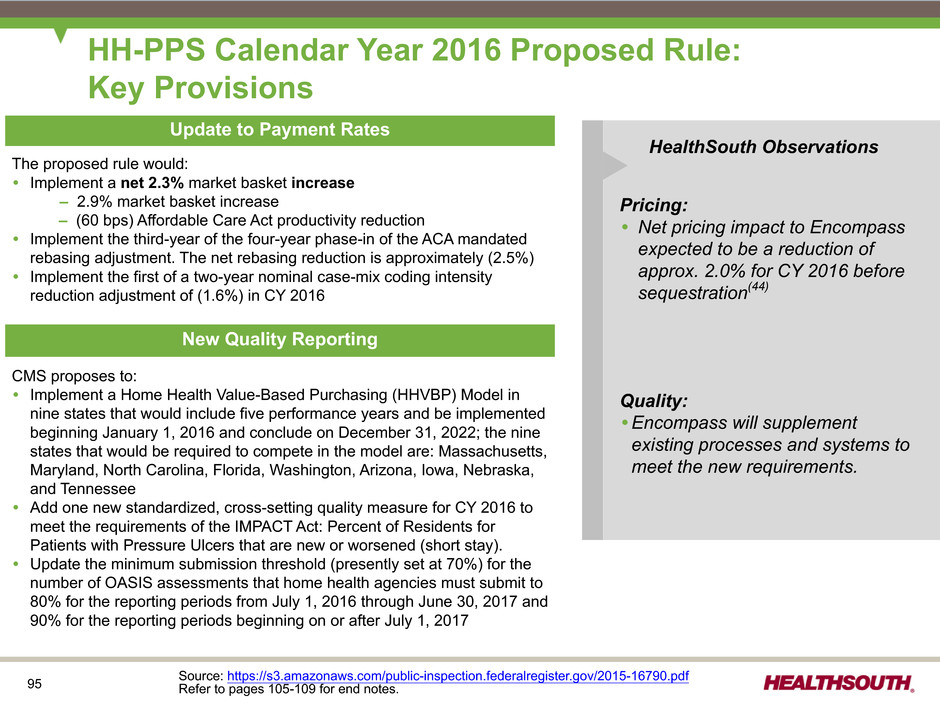
95 HH-PPS Calendar Year 2016 Proposed Rule: Key Provisions Source: https://s3.amazonaws.com/public-inspection.federalregister.gov/2015-16790.pdf Refer to pages 105-109 for end notes. New Quality Reporting Update to Payment Rates HealthSouth Observations Pricing: • Net pricing impact to Encompass expected to be a reduction of approx. 2.0% for CY 2016 before sequestration(44) Quality: • Encompass will supplement existing processes and systems to meet the new requirements. The proposed rule would: • Implement a net 2.3% market basket increase – 2.9% market basket increase – (60 bps) Affordable Care Act productivity reduction • Implement the third-year of the four-year phase-in of the ACA mandated rebasing adjustment. The net rebasing reduction is approximately (2.5%) • Implement the first of a two-year nominal case-mix coding intensity reduction adjustment of (1.6%) in CY 2016 CMS proposes to: • Implement a Home Health Value-Based Purchasing (HHVBP) Model in nine states that would include five performance years and be implemented beginning January 1, 2016 and conclude on December 31, 2022; the nine states that would be required to compete in the model are: Massachusetts, Maryland, North Carolina, Florida, Washington, Arizona, Iowa, Nebraska, and Tennessee • Add one new standardized, cross-setting quality measure for CY 2016 to meet the requirements of the IMPACT Act: Percent of Residents for Patients with Pressure Ulcers that are new or worsened (short stay). • Update the minimum submission threshold (presently set at 70%) for the number of OASIS assessments that home health agencies must submit to 80% for the reporting periods from July 1, 2016 through June 30, 2017 and 90% for the reporting periods beginning on or after July 1, 2017
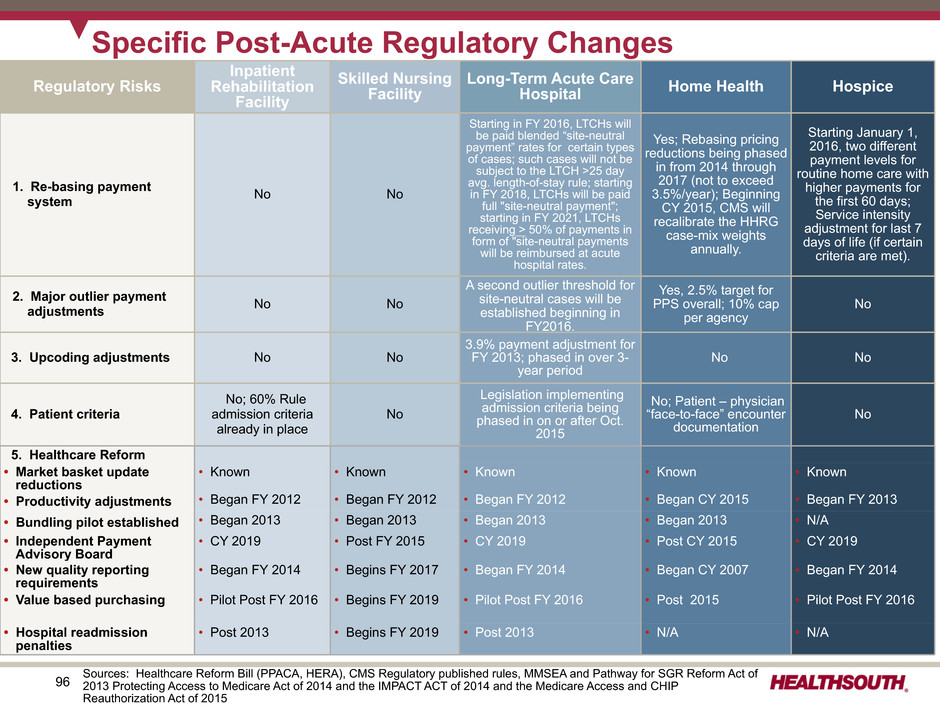
96 Specific Post-Acute Regulatory Changes Regulatory Risks Inpatient Rehabilitation Facility Skilled Nursing Facility Long-Term Acute Care Hospital Home Health Hospice 1. Re-basing payment system No No Starting in FY 2016, LTCHs will be paid blended “site-neutral payment” rates for certain types of cases; such cases will not be subject to the LTCH >25 day avg. length-of-stay rule; starting in FY 2018, LTCHs will be paid full "site-neutral payment"; starting in FY 2021, LTCHs receiving > 50% of payments in form of "site-neutral payments will be reimbursed at acute hospital rates. Yes; Rebasing pricing reductions being phased in from 2014 through 2017 (not to exceed 3.5%/year); Beginning CY 2015, CMS will recalibrate the HHRG case-mix weights annually. Starting January 1, 2016, two different payment levels for routine home care with higher payments for the first 60 days; Service intensity adjustment for last 7 days of life (if certain criteria are met). 2. Major outlier payment adjustments No No A second outlier threshold for site-neutral cases will be established beginning in FY2016. Yes, 2.5% target for PPS overall; 10% cap per agency No 3. Upcoding adjustments No No 3.9% payment adjustment for FY 2013; phased in over 3- year period No No 4. Patient criteria No; 60% Rule admission criteria already in place No Legislation implementing admission criteria being phased in on or after Oct. 2015 No; Patient – physician “face-to-face” encounter documentation No 5. Healthcare Reform • Market basket update reductions • Known • Known • Known • Known • Known • Productivity adjustments • Began FY 2012 • Began FY 2012 • Began FY 2012 • Began CY 2015 • Began FY 2013 • Bundling pilot established • Began 2013 • Began 2013 • Began 2013 • Began 2013 • N/A • Independent Payment Advisory Board • CY 2019 • Post FY 2015 • CY 2019 • Post CY 2015 • CY 2019 • New quality reporting requirements • Began FY 2014 • Begins FY 2017 • Began FY 2014 • Began CY 2007 • Began FY 2014 • Value based purchasing • Pilot Post FY 2016 • Begins FY 2019 • Pilot Post FY 2016 • Post 2015 • Pilot Post FY 2016 • Hospital readmission penalties • Post 2013 • Begins FY 2019 • Post 2013 • N/A • N/A Sources: Healthcare Reform Bill (PPACA, HERA), CMS Regulatory published rules, MMSEA and Pathway for SGR Reform Act of 2013 Protecting Access to Medicare Act of 2014 and the IMPACT ACT of 2014 and the Medicare Access and CHIP Reauthorization Act of 2015
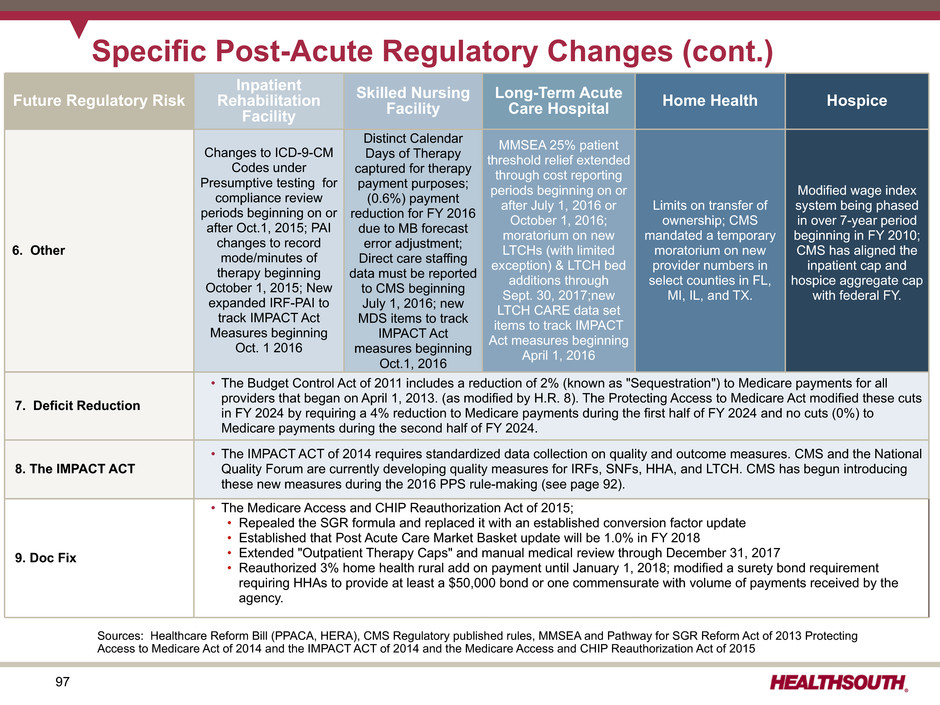
97 Future Regulatory Risk Inpatient Rehabilitation Facility Skilled Nursing Facility Long-Term Acute Care Hospital Home Health Hospice 6. Other Changes to ICD-9-CM Codes under Presumptive testing for compliance review periods beginning on or after Oct.1, 2015; PAI changes to record mode/minutes of therapy beginning October 1, 2015; New expanded IRF-PAI to track IMPACT Act Measures beginning Oct. 1 2016 Distinct Calendar Days of Therapy captured for therapy payment purposes; (0.6%) payment reduction for FY 2016 due to MB forecast error adjustment; Direct care staffing data must be reported to CMS beginning July 1, 2016; new MDS items to track IMPACT Act measures beginning Oct.1, 2016 MMSEA 25% patient threshold relief extended through cost reporting periods beginning on or after July 1, 2016 or October 1, 2016; moratorium on new LTCHs (with limited exception) & LTCH bed additions through Sept. 30, 2017;new LTCH CARE data set items to track IMPACT Act measures beginning April 1, 2016 Limits on transfer of ownership; CMS mandated a temporary moratorium on new provider numbers in select counties in FL, MI, IL, and TX. Modified wage index system being phased in over 7-year period beginning in FY 2010; CMS has aligned the inpatient cap and hospice aggregate cap with federal FY. 7. Deficit Reduction • The Budget Control Act of 2011 includes a reduction of 2% (known as "Sequestration") to Medicare payments for all providers that began on April 1, 2013. (as modified by H.R. 8). The Protecting Access to Medicare Act modified these cuts in FY 2024 by requiring a 4% reduction to Medicare payments during the first half of FY 2024 and no cuts (0%) to Medicare payments during the second half of FY 2024. 8. The IMPACT ACT • The IMPACT ACT of 2014 requires standardized data collection on quality and outcome measures. CMS and the National Quality Forum are currently developing quality measures for IRFs, SNFs, HHA, and LTCH. CMS has begun introducing these new measures during the 2016 PPS rule-making (see page 92). 9. Doc Fix • The Medicare Access and CHIP Reauthorization Act of 2015; • Repealed the SGR formula and replaced it with an established conversion factor update • Established that Post Acute Care Market Basket update will be 1.0% in FY 2018 • Extended "Outpatient Therapy Caps" and manual medical review through December 31, 2017 • Reauthorized 3% home health rural add on payment until January 1, 2018; modified a surety bond requirement requiring HHAs to provide at least a $50,000 bond or one commensurate with volume of payments received by the agency. Specific Post-Acute Regulatory Changes (cont.) Sources: Healthcare Reform Bill (PPACA, HERA), CMS Regulatory published rules, MMSEA and Pathway for SGR Reform Act of 2013 Protecting Access to Medicare Act of 2014 and the IMPACT ACT of 2014 and the Medicare Access and CHIP Reauthorization Act of 2015
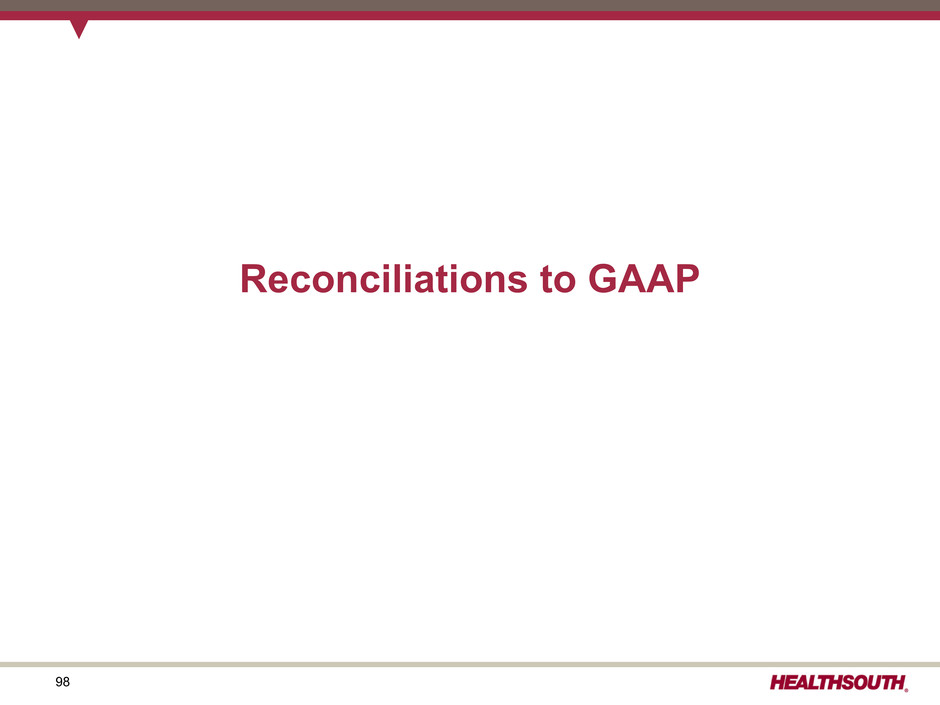
98 Reconciliations to GAAP
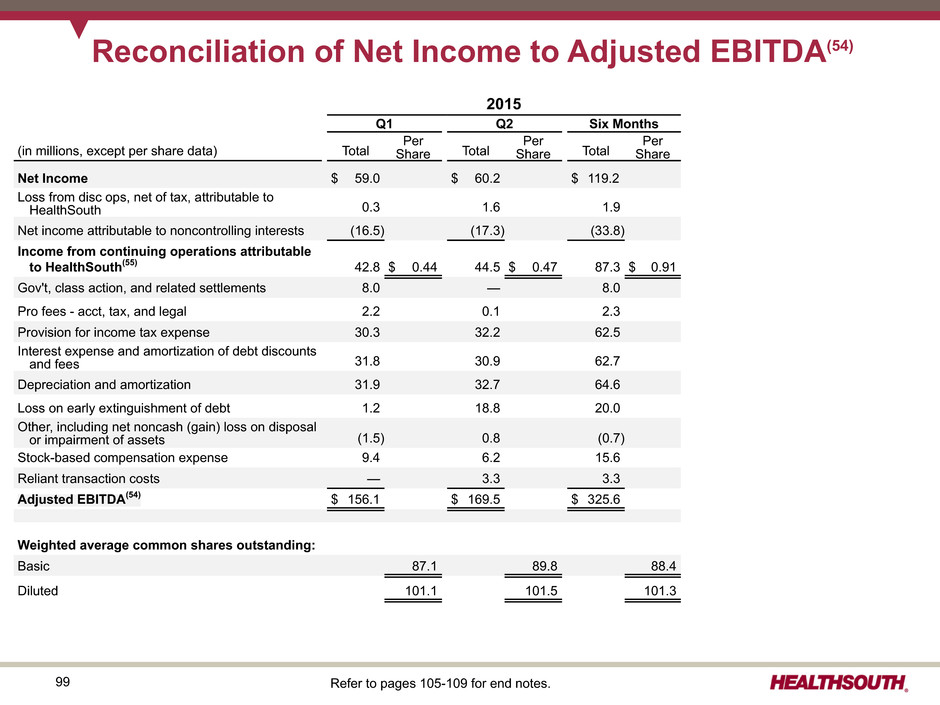
99 Reconciliation of Net Income to Adjusted EBITDA(54) 2015 Q1 Q2 Six Months (in millions, except per share data) Total Per Share Total Per Share Total Per Share Net Income $ 59.0 $ 60.2 $ 119.2 Loss from disc ops, net of tax, attributable to HealthSouth 0.3 1.6 1.9 Net income attributable to noncontrolling interests (16.5) (17.3) (33.8) Income from continuing operations attributable to HealthSouth(55) 42.8 $ 0.44 44.5 $ 0.47 87.3 $ 0.91 Gov't, class action, and related settlements 8.0 — 8.0 Pro fees - acct, tax, and legal 2.2 0.1 2.3 Provision for income tax expense 30.3 32.2 62.5 Interest expense and amortization of debt discounts and fees 31.8 30.9 62.7 Depreciation and amortization 31.9 32.7 64.6 Loss on early extinguishment of debt 1.2 18.8 20.0 Other, including net noncash (gain) loss on disposal or impairment of assets (1.5) 0.8 (0.7) Stock-based compensation expense 9.4 6.2 15.6 Reliant transaction costs — 3.3 3.3 Adjusted EBITDA(54) $ 156.1 $ 169.5 $ 325.6 Weighted average common shares outstanding: Basic 87.1 89.8 88.4 Diluted 101.1 101.5 101.3 Refer to pages 105-109 for end notes.
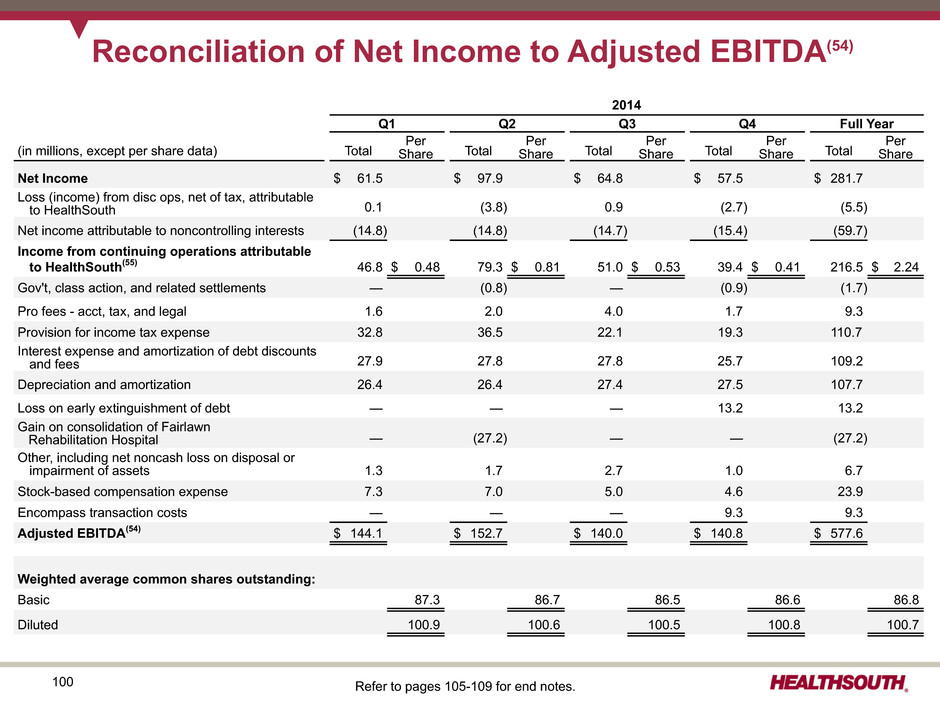
100 Reconciliation of Net Income to Adjusted EBITDA(54) 2014 Q1 Q2 Q3 Q4 Full Year (in millions, except per share data) Total Per Share Total Per Share Total Per Share Total Per Share Total Per Share Net Income $ 61.5 $ 97.9 $ 64.8 $ 57.5 $ 281.7 Loss (income) from disc ops, net of tax, attributable to HealthSouth 0.1 (3.8) 0.9 (2.7) (5.5) Net income attributable to noncontrolling interests (14.8) (14.8) (14.7) (15.4) (59.7) Income from continuing operations attributable to HealthSouth(55) 46.8 $ 0.48 79.3 $ 0.81 51.0 $ 0.53 39.4 $ 0.41 216.5 $ 2.24 Gov't, class action, and related settlements — (0.8) — (0.9) (1.7) Pro fees - acct, tax, and legal 1.6 2.0 4.0 1.7 9.3 Provision for income tax expense 32.8 36.5 22.1 19.3 110.7 Interest expense and amortization of debt discounts and fees 27.9 27.8 27.8 25.7 109.2 Depreciation and amortization 26.4 26.4 27.4 27.5 107.7 Loss on early extinguishment of debt — — — 13.2 13.2 Gain on consolidation of Fairlawn Rehabilitation Hospital — (27.2) — — (27.2) Other, including net noncash loss on disposal or impairment of assets 1.3 1.7 2.7 1.0 6.7 Stock-based compensation expense 7.3 7.0 5.0 4.6 23.9 Encompass transaction costs — — — 9.3 9.3 Adjusted EBITDA(54) $ 144.1 $ 152.7 $ 140.0 $ 140.8 $ 577.6 Weighted average common shares outstanding: Basic 87.3 86.7 86.5 86.6 86.8 Diluted 100.9 100.6 100.5 100.8 100.7 Refer to pages 105-109 for end notes.
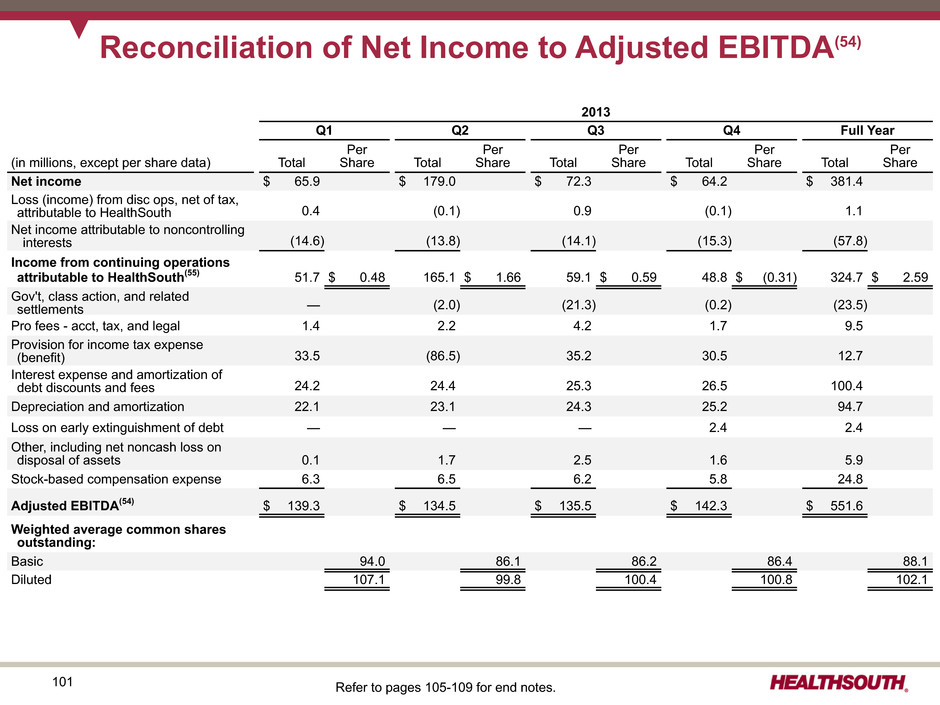
101 Reconciliation of Net Income to Adjusted EBITDA(54) 2013 Q1 Q2 Q3 Q4 Full Year (in millions, except per share data) Total Per Share Total Per Share Total Per Share Total Per Share Total Per Share Net income $ 65.9 $ 179.0 $ 72.3 $ 64.2 $ 381.4 Loss (income) from disc ops, net of tax, attributable to HealthSouth 0.4 (0.1) 0.9 (0.1) 1.1 Net income attributable to noncontrolling interests (14.6) (13.8) (14.1) (15.3) (57.8) Income from continuing operations attributable to HealthSouth(55) 51.7 $ 0.48 165.1 $ 1.66 59.1 $ 0.59 48.8 $ (0.31) 324.7 $ 2.59 Gov't, class action, and related settlements — (2.0) (21.3) (0.2) (23.5) Pro fees - acct, tax, and legal 1.4 2.2 4.2 1.7 9.5 Provision for income tax expense (benefit) 33.5 (86.5) 35.2 30.5 12.7 Interest expense and amortization of debt discounts and fees 24.2 24.4 25.3 26.5 100.4 Depreciation and amortization 22.1 23.1 24.3 25.2 94.7 Loss on early extinguishment of debt — — — 2.4 2.4 Other, including net noncash loss on disposal of assets 0.1 1.7 2.5 1.6 5.9 Stock-based compensation expense 6.3 6.5 6.2 5.8 24.8 Adjusted EBITDA(54) $ 139.3 $ 134.5 $ 135.5 $ 142.3 $ 551.6 Weighted average common shares outstanding: Basic 94.0 86.1 86.2 86.4 88.1 Diluted 107.1 99.8 100.4 100.8 102.1 Refer to pages 105-109 for end notes.
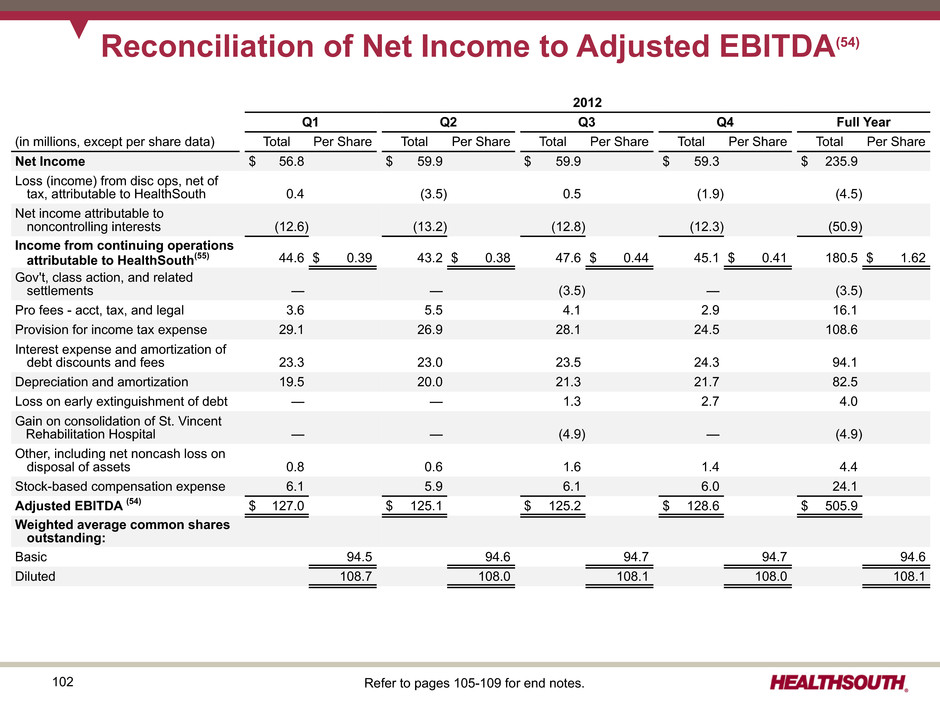
102 Reconciliation of Net Income to Adjusted EBITDA(54) 2012 Q1 Q2 Q3 Q4 Full Year (in millions, except per share data) Total Per Share Total Per Share Total Per Share Total Per Share Total Per Share Net Income $ 56.8 $ 59.9 $ 59.9 $ 59.3 $ 235.9 Loss (income) from disc ops, net of tax, attributable to HealthSouth 0.4 (3.5) 0.5 (1.9) (4.5) Net income attributable to noncontrolling interests (12.6) (13.2) (12.8) (12.3) (50.9) Income from continuing operations attributable to HealthSouth(55) 44.6 $ 0.39 43.2 $ 0.38 47.6 $ 0.44 45.1 $ 0.41 180.5 $ 1.62 Gov't, class action, and related settlements — — (3.5) — (3.5) Pro fees - acct, tax, and legal 3.6 5.5 4.1 2.9 16.1 Provision for income tax expense 29.1 26.9 28.1 24.5 108.6 Interest expense and amortization of debt discounts and fees 23.3 23.0 23.5 24.3 94.1 Depreciation and amortization 19.5 20.0 21.3 21.7 82.5 Loss on early extinguishment of debt — — 1.3 2.7 4.0 Gain on consolidation of St. Vincent Rehabilitation Hospital — — (4.9) — (4.9) Other, including net noncash loss on disposal of assets 0.8 0.6 1.6 1.4 4.4 Stock-based compensation expense 6.1 5.9 6.1 6.0 24.1 Adjusted EBITDA (54) $ 127.0 $ 125.1 $ 125.2 $ 128.6 $ 505.9 Weighted average common shares outstanding: Basic 94.5 94.6 94.7 94.7 94.6 Diluted 108.7 108.0 108.1 108.0 108.1 Refer to pages 105-109 for end notes.
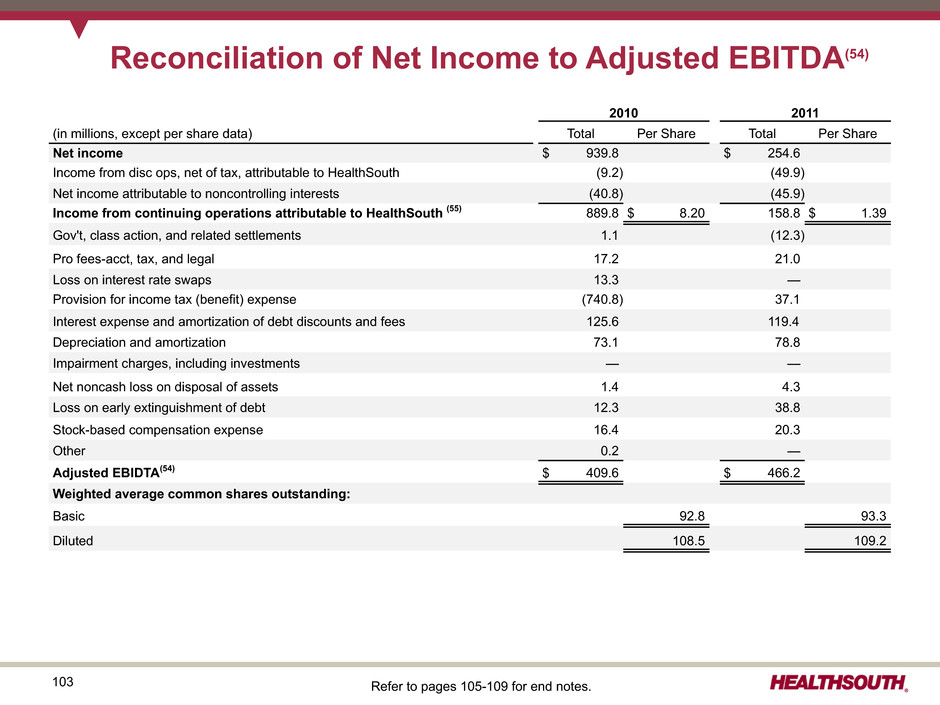
103 Reconciliation of Net Income to Adjusted EBITDA(54) 2010 2011 (in millions, except per share data) Total Per Share Total Per Share Net income $ 939.8 $ 254.6 Income from disc ops, net of tax, attributable to HealthSouth (9.2) (49.9) Net income attributable to noncontrolling interests (40.8) (45.9) Income from continuing operations attributable to HealthSouth (55) 889.8 $ 8.20 158.8 $ 1.39 Gov't, class action, and related settlements 1.1 (12.3) Pro fees-acct, tax, and legal 17.2 21.0 Loss on interest rate swaps 13.3 — Provision for income tax (benefit) expense (740.8) 37.1 Interest expense and amortization of debt discounts and fees 125.6 119.4 Depreciation and amortization 73.1 78.8 Impairment charges, including investments — — Net noncash loss on disposal of assets 1.4 4.3 Loss on early extinguishment of debt 12.3 38.8 Stock-based compensation expense 16.4 20.3 Other 0.2 — Adjusted EBIDTA(54) $ 409.6 $ 466.2 Weighted average common shares outstanding: Basic 92.8 93.3 Diluted 108.5 109.2 Refer to pages 105-109 for end notes.
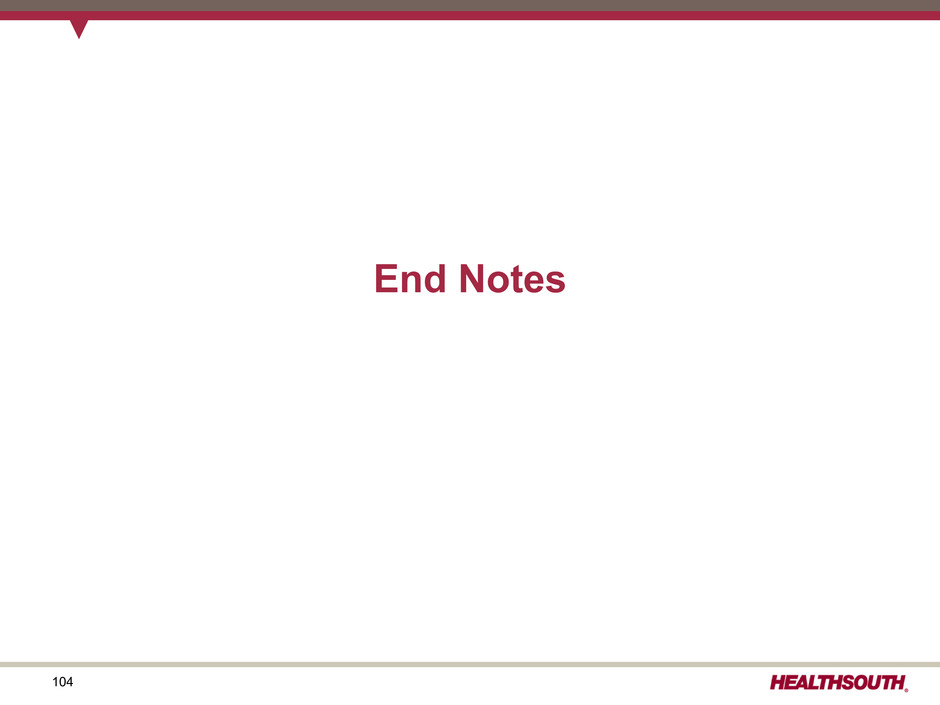
104 End Notes
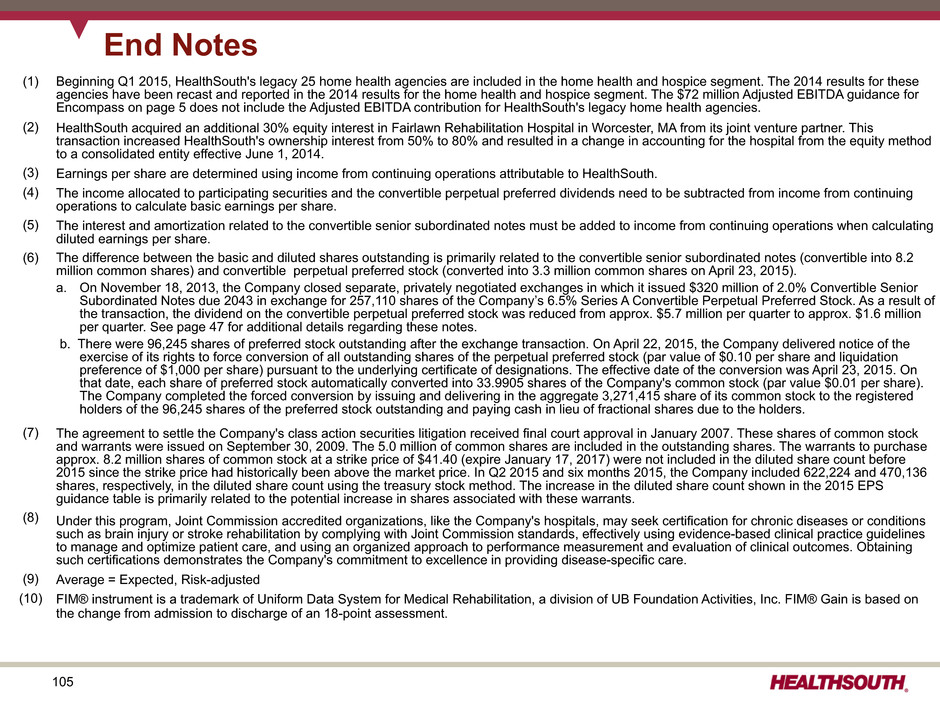
105 End Notes (1) Beginning Q1 2015, HealthSouth's legacy 25 home health agencies are included in the home health and hospice segment. The 2014 results for these agencies have been recast and reported in the 2014 results for the home health and hospice segment. The $72 million Adjusted EBITDA guidance for Encompass on page 5 does not include the Adjusted EBITDA contribution for HealthSouth's legacy home health agencies. (2) HealthSouth acquired an additional 30% equity interest in Fairlawn Rehabilitation Hospital in Worcester, MA from its joint venture partner. This transaction increased HealthSouth's ownership interest from 50% to 80% and resulted in a change in accounting for the hospital from the equity method to a consolidated entity effective June 1, 2014. (3) Earnings per share are determined using income from continuing operations attributable to HealthSouth. (4) The income allocated to participating securities and the convertible perpetual preferred dividends need to be subtracted from income from continuing operations to calculate basic earnings per share. (5) The interest and amortization related to the convertible senior subordinated notes must be added to income from continuing operations when calculating diluted earnings per share. (6) The difference between the basic and diluted shares outstanding is primarily related to the convertible senior subordinated notes (convertible into 8.2 million common shares) and convertible perpetual preferred stock (converted into 3.3 million common shares on April 23, 2015). a. On November 18, 2013, the Company closed separate, privately negotiated exchanges in which it issued $320 million of 2.0% Convertible Senior Subordinated Notes due 2043 in exchange for 257,110 shares of the Company’s 6.5% Series A Convertible Perpetual Preferred Stock. As a result of the transaction, the dividend on the convertible perpetual preferred stock was reduced from approx. $5.7 million per quarter to approx. $1.6 million per quarter. See page 47 for additional details regarding these notes. b. There were 96,245 shares of preferred stock outstanding after the exchange transaction. On April 22, 2015, the Company delivered notice of the exercise of its rights to force conversion of all outstanding shares of the perpetual preferred stock (par value of $0.10 per share and liquidation preference of $1,000 per share) pursuant to the underlying certificate of designations. The effective date of the conversion was April 23, 2015. On that date, each share of preferred stock automatically converted into 33.9905 shares of the Company's common stock (par value $0.01 per share). The Company completed the forced conversion by issuing and delivering in the aggregate 3,271,415 share of its common stock to the registered holders of the 96,245 shares of the preferred stock outstanding and paying cash in lieu of fractional shares due to the holders. (7) The agreement to settle the Company's class action securities litigation received final court approval in January 2007. These shares of common stock and warrants were issued on September 30, 2009. The 5.0 million of common shares are included in the outstanding shares. The warrants to purchase approx. 8.2 million shares of common stock at a strike price of $41.40 (expire January 17, 2017) were not included in the diluted share count before 2015 since the strike price had historically been above the market price. In Q2 2015 and six months 2015, the Company included 622,224 and 470,136 shares, respectively, in the diluted share count using the treasury stock method. The increase in the diluted share count shown in the 2015 EPS guidance table is primarily related to the potential increase in shares associated with these warrants. (8) Under this program, Joint Commission accredited organizations, like the Company's hospitals, may seek certification for chronic diseases or conditions such as brain injury or stroke rehabilitation by complying with Joint Commission standards, effectively using evidence-based clinical practice guidelines to manage and optimize patient care, and using an organized approach to performance measurement and evaluation of clinical outcomes. Obtaining such certifications demonstrates the Company's commitment to excellence in providing disease-specific care. (9) Average = Expected, Risk-adjusted (10) FIM® instrument is a trademark of Uniform Data System for Medical Rehabilitation, a division of UB Foundation Activities, Inc. FIM® Gain is based on the change from admission to discharge of an 18-point assessment.
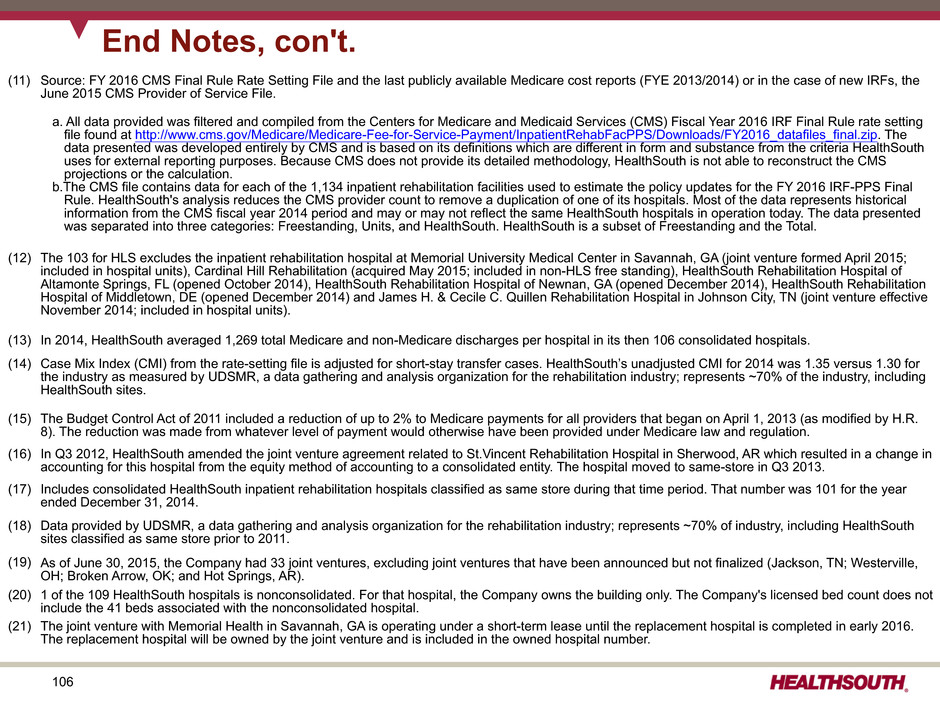
106 End Notes, con't. (11) Source: FY 2016 CMS Final Rule Rate Setting File and the last publicly available Medicare cost reports (FYE 2013/2014) or in the case of new IRFs, the June 2015 CMS Provider of Service File. a. All data provided was filtered and compiled from the Centers for Medicare and Medicaid Services (CMS) Fiscal Year 2016 IRF Final Rule rate setting file found at http://www.cms.gov/Medicare/Medicare-Fee-for-Service-Payment/InpatientRehabFacPPS/Downloads/FY2016_datafiles_final.zip. The data presented was developed entirely by CMS and is based on its definitions which are different in form and substance from the criteria HealthSouth uses for external reporting purposes. Because CMS does not provide its detailed methodology, HealthSouth is not able to reconstruct the CMS projections or the calculation. b.The CMS file contains data for each of the 1,134 inpatient rehabilitation facilities used to estimate the policy updates for the FY 2016 IRF-PPS Final Rule. HealthSouth's analysis reduces the CMS provider count to remove a duplication of one of its hospitals. Most of the data represents historical information from the CMS fiscal year 2014 period and may or may not reflect the same HealthSouth hospitals in operation today. The data presented was separated into three categories: Freestanding, Units, and HealthSouth. HealthSouth is a subset of Freestanding and the Total. (12) The 103 for HLS excludes the inpatient rehabilitation hospital at Memorial University Medical Center in Savannah, GA (joint venture formed April 2015; included in hospital units), Cardinal Hill Rehabilitation (acquired May 2015; included in non-HLS free standing), HealthSouth Rehabilitation Hospital of Altamonte Springs, FL (opened October 2014), HealthSouth Rehabilitation Hospital of Newnan, GA (opened December 2014), HealthSouth Rehabilitation Hospital of Middletown, DE (opened December 2014) and James H. & Cecile C. Quillen Rehabilitation Hospital in Johnson City, TN (joint venture effective November 2014; included in hospital units). (13) In 2014, HealthSouth averaged 1,269 total Medicare and non-Medicare discharges per hospital in its then 106 consolidated hospitals. (14) Case Mix Index (CMI) from the rate-setting file is adjusted for short-stay transfer cases. HealthSouth’s unadjusted CMI for 2014 was 1.35 versus 1.30 for the industry as measured by UDSMR, a data gathering and analysis organization for the rehabilitation industry; represents ~70% of the industry, including HealthSouth sites. (15) The Budget Control Act of 2011 included a reduction of up to 2% to Medicare payments for all providers that began on April 1, 2013 (as modified by H.R. 8). The reduction was made from whatever level of payment would otherwise have been provided under Medicare law and regulation. (16) In Q3 2012, HealthSouth amended the joint venture agreement related to St.Vincent Rehabilitation Hospital in Sherwood, AR which resulted in a change in accounting for this hospital from the equity method of accounting to a consolidated entity. The hospital moved to same-store in Q3 2013. (17) Includes consolidated HealthSouth inpatient rehabilitation hospitals classified as same store during that time period. That number was 101 for the year ended December 31, 2014. (18) Data provided by UDSMR, a data gathering and analysis organization for the rehabilitation industry; represents ~70% of industry, including HealthSouth sites classified as same store prior to 2011. (19) As of June 30, 2015, the Company had 33 joint ventures, excluding joint ventures that have been announced but not finalized (Jackson, TN; Westerville, OH; Broken Arrow, OK; and Hot Springs, AR). (20) 1 of the 109 HealthSouth hospitals is nonconsolidated. For that hospital, the Company owns the building only. The Company's licensed bed count does not include the 41 beds associated with the nonconsolidated hospital. (21) The joint venture with Memorial Health in Savannah, GA is operating under a short-term lease until the replacement hospital is completed in early 2016. The replacement hospital will be owned by the joint venture and is included in the owned hospital number.
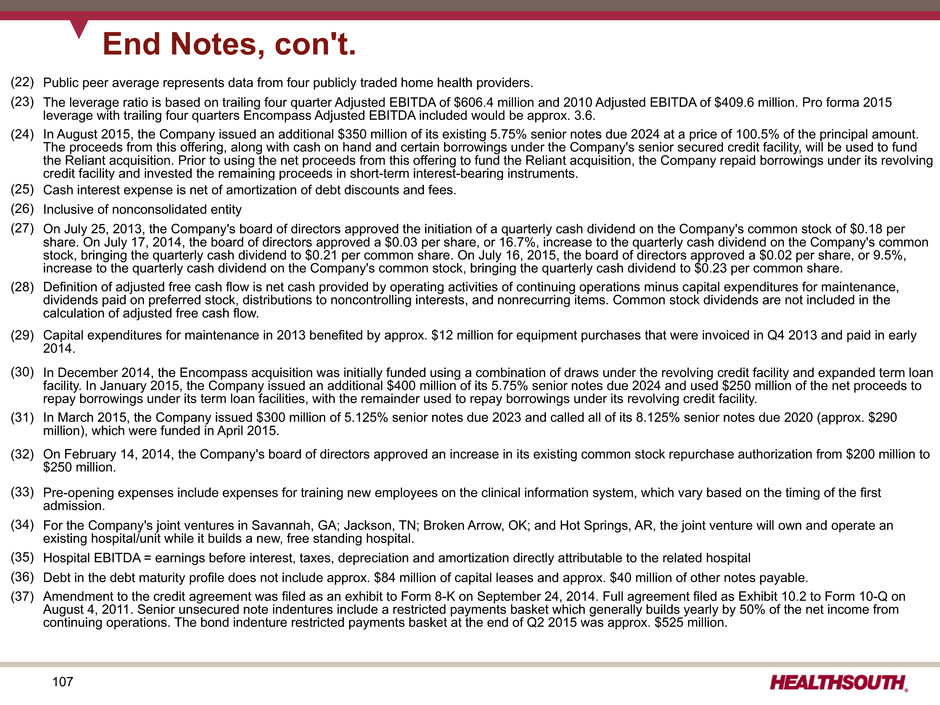
107 End Notes, con't. (22) Public peer average represents data from four publicly traded home health providers. (23) The leverage ratio is based on trailing four quarter Adjusted EBITDA of $606.4 million and 2010 Adjusted EBITDA of $409.6 million. Pro forma 2015 leverage with trailing four quarters Encompass Adjusted EBITDA included would be approx. 3.6. (24) In August 2015, the Company issued an additional $350 million of its existing 5.75% senior notes due 2024 at a price of 100.5% of the principal amount. The proceeds from this offering, along with cash on hand and certain borrowings under the Company's senior secured credit facility, will be used to fund the Reliant acquisition. Prior to using the net proceeds from this offering to fund the Reliant acquisition, the Company repaid borrowings under its revolving credit facility and invested the remaining proceeds in short-term interest-bearing instruments. (25) Cash interest expense is net of amortization of debt discounts and fees. (26) Inclusive of nonconsolidated entity (27) On July 25, 2013, the Company's board of directors approved the initiation of a quarterly cash dividend on the Company's common stock of $0.18 per share. On July 17, 2014, the board of directors approved a $0.03 per share, or 16.7%, increase to the quarterly cash dividend on the Company's common stock, bringing the quarterly cash dividend to $0.21 per common share. On July 16, 2015, the board of directors approved a $0.02 per share, or 9.5%, increase to the quarterly cash dividend on the Company's common stock, bringing the quarterly cash dividend to $0.23 per common share. (28) Definition of adjusted free cash flow is net cash provided by operating activities of continuing operations minus capital expenditures for maintenance, dividends paid on preferred stock, distributions to noncontrolling interests, and nonrecurring items. Common stock dividends are not included in the calculation of adjusted free cash flow. (29) Capital expenditures for maintenance in 2013 benefited by approx. $12 million for equipment purchases that were invoiced in Q4 2013 and paid in early 2014. (30) In December 2014, the Encompass acquisition was initially funded using a combination of draws under the revolving credit facility and expanded term loan facility. In January 2015, the Company issued an additional $400 million of its 5.75% senior notes due 2024 and used $250 million of the net proceeds to repay borrowings under its term loan facilities, with the remainder used to repay borrowings under its revolving credit facility. (31) In March 2015, the Company issued $300 million of 5.125% senior notes due 2023 and called all of its 8.125% senior notes due 2020 (approx. $290 million), which were funded in April 2015. (32) On February 14, 2014, the Company's board of directors approved an increase in its existing common stock repurchase authorization from $200 million to $250 million. (33) Pre-opening expenses include expenses for training new employees on the clinical information system, which vary based on the timing of the first admission. (34) For the Company's joint ventures in Savannah, GA; Jackson, TN; Broken Arrow, OK; and Hot Springs, AR, the joint venture will own and operate an existing hospital/unit while it builds a new, free standing hospital. (35) Hospital EBITDA = earnings before interest, taxes, depreciation and amortization directly attributable to the related hospital (36) Debt in the debt maturity profile does not include approx. $84 million of capital leases and approx. $40 million of other notes payable. (37) Amendment to the credit agreement was filed as an exhibit to Form 8-K on September 24, 2014. Full agreement filed as Exhibit 10.2 to Form 10-Q on August 4, 2011. Senior unsecured note indentures include a restricted payments basket which generally builds yearly by 50% of the net income from continuing operations. The bond indenture restricted payments basket at the end of Q2 2015 was approx. $525 million.
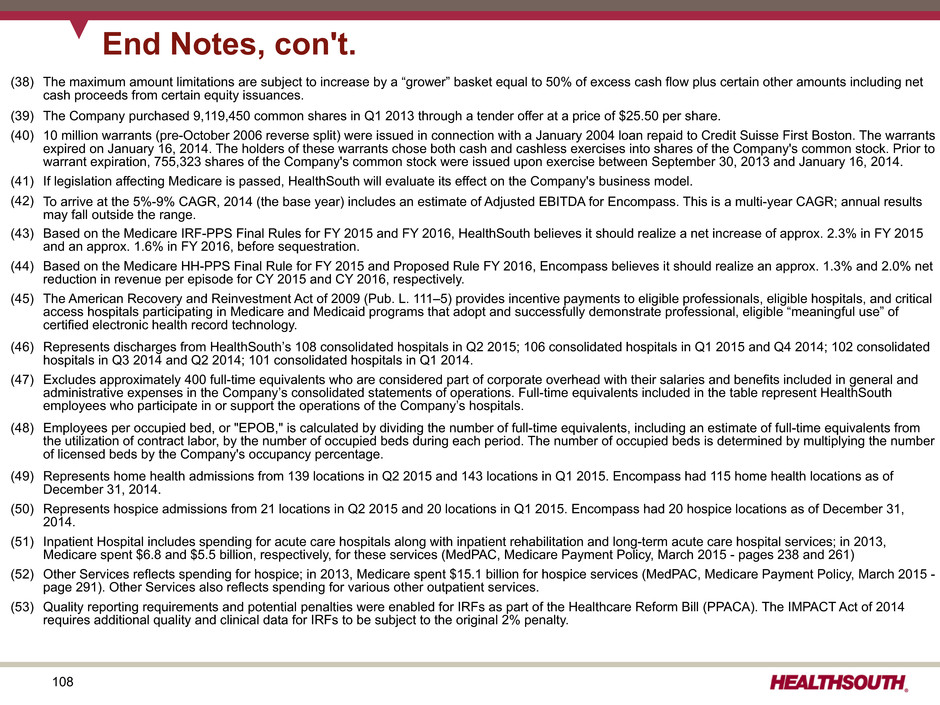
108 End Notes, con't. (38) The maximum amount limitations are subject to increase by a “grower” basket equal to 50% of excess cash flow plus certain other amounts including net cash proceeds from certain equity issuances. (39) The Company purchased 9,119,450 common shares in Q1 2013 through a tender offer at a price of $25.50 per share. (40) 10 million warrants (pre-October 2006 reverse split) were issued in connection with a January 2004 loan repaid to Credit Suisse First Boston. The warrants expired on January 16, 2014. The holders of these warrants chose both cash and cashless exercises into shares of the Company's common stock. Prior to warrant expiration, 755,323 shares of the Company's common stock were issued upon exercise between September 30, 2013 and January 16, 2014. (41) If legislation affecting Medicare is passed, HealthSouth will evaluate its effect on the Company's business model. (42) To arrive at the 5%-9% CAGR, 2014 (the base year) includes an estimate of Adjusted EBITDA for Encompass. This is a multi-year CAGR; annual results may fall outside the range. (43) Based on the Medicare IRF-PPS Final Rules for FY 2015 and FY 2016, HealthSouth believes it should realize a net increase of approx. 2.3% in FY 2015 and an approx. 1.6% in FY 2016, before sequestration. (44) Based on the Medicare HH-PPS Final Rule for FY 2015 and Proposed Rule FY 2016, Encompass believes it should realize an approx. 1.3% and 2.0% net reduction in revenue per episode for CY 2015 and CY 2016, respectively. (45) The American Recovery and Reinvestment Act of 2009 (Pub. L. 111–5) provides incentive payments to eligible professionals, eligible hospitals, and critical access hospitals participating in Medicare and Medicaid programs that adopt and successfully demonstrate professional, eligible “meaningful use” of certified electronic health record technology. (46) Represents discharges from HealthSouth’s 108 consolidated hospitals in Q2 2015; 106 consolidated hospitals in Q1 2015 and Q4 2014; 102 consolidated hospitals in Q3 2014 and Q2 2014; 101 consolidated hospitals in Q1 2014. (47) Excludes approximately 400 full-time equivalents who are considered part of corporate overhead with their salaries and benefits included in general and administrative expenses in the Company’s consolidated statements of operations. Full-time equivalents included in the table represent HealthSouth employees who participate in or support the operations of the Company’s hospitals. (48) Employees per occupied bed, or "EPOB," is calculated by dividing the number of full-time equivalents, including an estimate of full-time equivalents from the utilization of contract labor, by the number of occupied beds during each period. The number of occupied beds is determined by multiplying the number of licensed beds by the Company's occupancy percentage. (49) Represents home health admissions from 139 locations in Q2 2015 and 143 locations in Q1 2015. Encompass had 115 home health locations as of December 31, 2014. (50) Represents hospice admissions from 21 locations in Q2 2015 and 20 locations in Q1 2015. Encompass had 20 hospice locations as of December 31, 2014. (51) Inpatient Hospital includes spending for acute care hospitals along with inpatient rehabilitation and long-term acute care hospital services; in 2013, Medicare spent $6.8 and $5.5 billion, respectively, for these services (MedPAC, Medicare Payment Policy, March 2015 - pages 238 and 261) (52) Other Services reflects spending for hospice; in 2013, Medicare spent $15.1 billion for hospice services (MedPAC, Medicare Payment Policy, March 2015 - page 291). Other Services also reflects spending for various other outpatient services. (53) Quality reporting requirements and potential penalties were enabled for IRFs as part of the Healthcare Reform Bill (PPACA). The IMPACT Act of 2014 requires additional quality and clinical data for IRFs to be subject to the original 2% penalty.
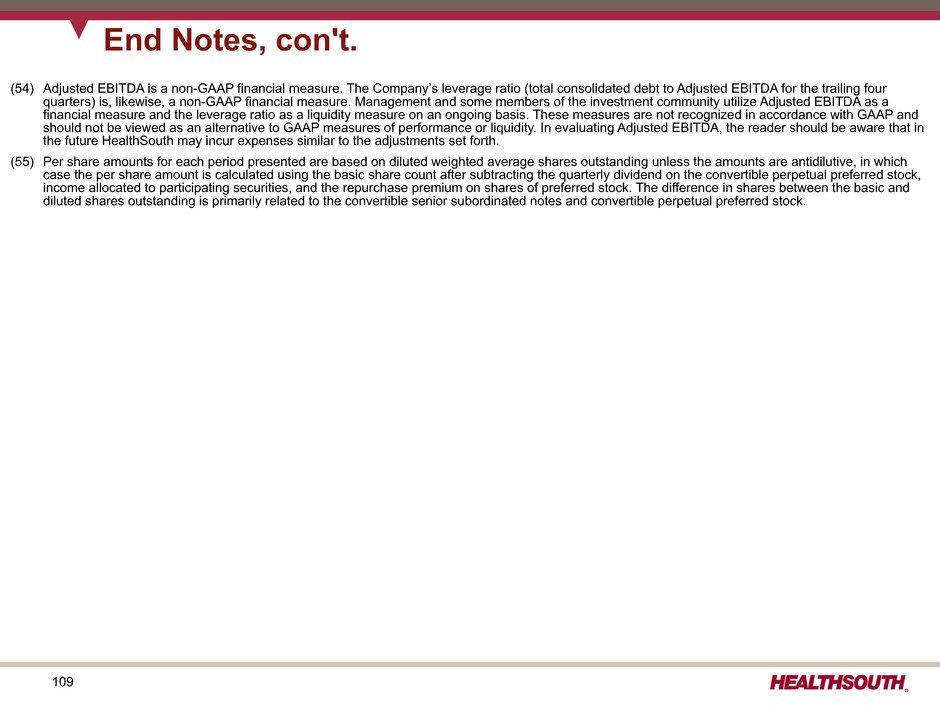
109 (54) Adjusted EBITDA is a non-GAAP financial measure. The Company’s leverage ratio (total consolidated debt to Adjusted EBITDA for the trailing four quarters) is, likewise, a non-GAAP financial measure. Management and some members of the investment community utilize Adjusted EBITDA as a financial measure and the leverage ratio as a liquidity measure on an ongoing basis. These measures are not recognized in accordance with GAAP and should not be viewed as an alternative to GAAP measures of performance or liquidity. In evaluating Adjusted EBITDA, the reader should be aware that in the future HealthSouth may incur expenses similar to the adjustments set forth. (55) Per share amounts for each period presented are based on diluted weighted average shares outstanding unless the amounts are antidilutive, in which case the per share amount is calculated using the basic share count after subtracting the quarterly dividend on the convertible perpetual preferred stock, income allocated to participating securities, and the repurchase premium on shares of preferred stock. The difference in shares between the basic and diluted shares outstanding is primarily related to the convertible senior subordinated notes and convertible perpetual preferred stock. End Notes, con't.












































































































